In fact, although this testing is devoted to the next (third) Pascal video card, the article could be called differently: “Overview aMD video cards Radeon RX 480: a new round of competition. Everything is very simple. In the role of opponents performed accelerators, which have long been on sale. The same GeForce GTX 970/980 will be no less than two years old in September. Now the Radeon RX 480 has a full-fledged competitor. Or vice versa.
Specifications and design features
The Founders Edition has arrived to our test lab. As usual. Immediately I will say: the reference will not be officially sold in Russia, since the reference modification of the GeForce GTX 1060 is implemented by NVIDIA solely by its own store, and this is not the case in Russia. However, the recommended price for custom models is known - from 19,000 rubles. Approximately the same amount is requested for the 8-gigabyte reference version of the Radeon RX 480.
|
Chip name |
Polaris 10 (Ellesmere) |
|
|
Technical process |
||
|
Number of stream processors / CUDA cores |
||
|
The number of texture units |
||
|
ROP number |
||
|
Second level cache |
||
|
Core frequency |
1506 (1708) MHz |
1120 (1266) MHz |
|
GDDR5, 6 GB, 2000 (8000) MHz |
GDDR5, 8 GB, 2000 (8000) MHz |
|
|
Memory interface |
||
|
Memory bandwidth |
||
|
TDP level |
||
|
from 19 000 rub. ($ 250 - MSRP; $ 300 - Founders Edition) |
19 000 rub. ($ 240) |
Details on the Pascal architecture and the new NVIDIA technologies i. I will not repeat. If the subflags of the "green" are based on the GP104 GPU, then the GeForce GTX 1060 received a completely new chip - the GP106. Let's make two comparisons.
First, GP106 uses two processor graphics clusters (GPC). Stone received ten streaming multiprocessors (SM), 1280 CUDA cores, 80 texture units and 48 ROPs. This is 640, 40 and 16 units less than the GP104 used in, but 256, 16 and 16 blocks more than the GM206 and, respectively. Judging by the marking, the GeForce GTX 1060 has come to replace the second adapter. Now, without any tests, it is obvious that the difference in performance between the third and second Pascal in the tables will be noticeable.
GP106 and GP104 operate at the same clock frequency of 1506 MHz. The memory speed of the GeForce GTX 1060 and GeForce GTX 1070 is the same, but in the younger version only 6 GB are used together with the 192-bit bus. Hence, a small bandwidth of 192 GB / s.
Secondly, AMD produces its chips (so far only the chip) on a thinner 14-nm process technology. But what do we see in practice? The Polaris 10 crystal used in the Radeon RX 480 has a usable area of 232 mm 2 and a transistor budget of 5 billion silicon cells. GP106 has only 4.4 billion valves, which fit 200 mm 2. We compare the density and we get very interesting figures: 21.55 million transistors per square millimeter in Polaris versus 22 million transistors per square millimeter in Pascal. Here you have a 16-nanometer process technology! At the same time, the GeForce GTX 1060 consumes 30 W less than the Radeon RX 480.
Pascal has higher transistor density
The reference sample is made in the style of the reference versions of GeForce GTX 1070 and GeForce GTX 1080. I like it. Some differences still exist. If we are talking about the design, then everything remains the same. The time-tested supercharger of tangential type is used. It drives cold air through a radiator without heat pipes. Already heated streams are output through a special grid on the video card I / O panels. If we are talking about design, the Founders version of the GeForce GTX 1060 has lost its glass window. His place was taken by a plastic cap. So cheaper, but, really, and more brutal!
A photograph of the back side gives more food for thought. Bekpleyt not, as in the same reference GeForce GTX 1070 and GeForce GTX 1080. Printed circuit board shortened. In this regard, the standards of the GeForce GTX 1060 and Radeon RX 480 are similar. But the most interesting thing is the location of the 6-pin power connector.
Usually plastic port unsolder directly on the PCB. In the GeForce GTX 1060 Founders Edition, it is attached directly to the casing of the cooler. I fully support this engineering idea. The connector located in the middle of the video card spoils the whole picture when laying the cables inside the case. It is obvious that on the basis of the printed circuit board used in the GeForce GTX 1060, one more (two, three?) Video card will appear, which most likely will not require additional power supply.
One more thing. GeForce GTX 1060 has lost connectors for connecting flexible () bridges. I.e sLI technology not supported The motive is clear: NVIDIA does not want two such video cards to compete with one GeForce GTX 1080, because the flagship of the "green" costs $ 100-200 more expensive. Personally, in the absence of support for SLI, I do not see any problem, because I have long been opposed to bundles of nontopic accelerators. The game is not worth the candle.
A set of video outputs from the GeForce GTX 1060 Founders Edition standard. Holders of "heavily used" monitors will appreciate the DVI port. The reference Radeon RX 480 is not. I am also pleased that new video cards are now friends with HDR. The energy efficient GeForce GTX 1060 is a good option for building a compact HTPC that can easily handle all games in Full HD resolution.
Here is a cooler without a metal casing. It is based on an aluminum radiator with two heat pipes. In senior Pascal, as you know, evaporative chambers are used.
The photo of the printed circuit board only confirms my guess: on the basis of the same PCB, we will soon see a new (new) product (s). Two places for decoupling memory chips are not occupied. GP106 GPU power subsystem consists of three phases.
Officially, the Boost-frequency of the GeForce GTX 1060 graphics processor is 1708 MHz, but at FurMark the speed of the chip has risen to 1823 MHz. In games, it ranges from 1823-1886 MHz. Under load, the GPU warmed up to 76 degrees Celsius. At a distance of a meter from the test bench, the sound level meter recorded 39.5 dB. Noticeable, but quite comfortable. The fan spun up to 2000 rpm. The first result of the confrontation between the Radeon RX 480 and the GeForce GTX 1060: the NVIDIA reference is better.
The power subsystem does not cool very efficiently. Elements of the conclusions warmed up to 90 degrees Celsius. However, there is nothing wrong with that. .
In terms of energy efficiency, the GeForce GTX 1060 again looks preferable to the Radeon RX 480. Yes, and many others. gaming graphics cards.
Testing
Test bench:
- CPU: @ 4.5 GHz
- CPU cooler:
- Motherboard: MSI Z97MPOWER
- Storage device:
- RAM: DDR3-2133, 2x 8 GB
- Power Supply: Corsair HX850i, 850 W
- Peripherals: LG 31MU97 monitor
- Operating system:Windows 10 x64
- Drivers:AMD - 16.6.2; NVIDIA - 369.64
Almost all games were launched with maximum graphics quality settings. Smoothing was used only for Full HD and WQHD resolutions. Explanation of the settings is on the graphs and tables themselves. Screenshots with a full list of options are located in.
Steam VR
Let's start with the increasing popularity of VR gaming. So far, the accessories are more expensive than the video cards themselves, but to dream, as they say, is not harmful. Harmful - not to dream. Both manufacturers use a different approach to optimize their solutions for gaming in a virtual reality environment. AMD for the most part placed all operations on asynchronous computing. NVIDIA's Pascal uses Simultaneous Multi-Projection hardware block. In practice, the built-in benchmark Steam demonstrates that the GeForce GTX 1060 with 8.6 points looks preferable to the Radeon RX 480 with seven points. But both video cards are ready for VR.
Well, the opposition turns out to be very stubborn. In the megapopular among the PC boyars, The Witcher III: Wild Hunt "one thousand sixtieth" bypasses the Radeon RX 480 by 9% in full HD resolution and by 8% in WQHD.
It is interesting that in RotTR there is practically no difference between the GeForce GTX 1060 and the overclocked GeForce GTX 970, if we compare these adapters by the average frame rate. But the presence of an additional two gigabytes of memory allows the Pascal card to avoid such nasty drawdowns of FPS.
In general, the confrontation between the GeForce GTX 1060 and the Radeon RX 480 really turns out to be stubborn, but in the overwhelming majority of cases, in games with DirectX 11, the winner of these fights is a green 3D accelerator.
Directx 12
In games that use low-level APIs, the situation changes with the exact opposite. The leader in the national video card race is the Radeon RX 480. In a personal conversation with representatives of AMD, which took place a few days ago at a special event dedicated to the launch of new devices, they said so: a similar situation is a trend, since “red” graphics accelerators work better with asynchronous computing, rather than NVIDIA products. But I am plagued by vague doubts. According to the official data, the work of asynchronous computing in Pascal has also improved. Yes, in Quantum Break the Radeon RX 480 is ahead of the GeForce GTX 1060 by 10% in Full HD and 11% in WQHD. But let's look at other games.
Ashes of Singularity has long been used by marketers of the Reds as lethal evidence proving total superiority. video card radeon in DirectX 12. But along with the GeForce GTX 1060, the driver numbered 369.64 came out. Now ahead of the GeForce. So in Total War: Warhammer between rival parity cards. In DirectX 12. Also a trend.
NVIDIA is catching up with AMD in DirectX 12
It is clear that for DirectX 12 games the future. Ahead of such hits as "Civilization 6" and Battlefield 1, which also support this low-level API. Dumb with such hits like death. The most interesting thing in this whole situation - will they not forget to optimize not only Pascal, but Maxwell, under DirectX 12 and Vulkan? About the existence of Kepler, it seems, in NVIDIA no longer
OpenGL and Vulkan
As expected, the new DOOM now supports not only OpenGL, but also the low-level Vulkan API. The results were shocking. "Red" cards decently added. In Full HD resolution, the same Radeon RX 480 added 47.6% when changing the API! Unfortunately, FRAPS with Vulkan does not work, but the Action program! limited by the frame rate of the monitor. A WQHD display with a scan rate of 120-144 Hz was not at hand.
GeForce GTX 1060 refused to add FPS from changing the software interface in our test segment. Let's see if the situation changes with the release of new driver versions. The second interesting point: Vulkan noticeably offloads the CPU.
Acceleration added 10-13% FPS
As you can see, in most games, an increase of 200 MHz (13%) per chip almost proportionally affected the increase in performance. Trifle, but nice.
I remind you that because of the short deadlines for testing the results of testing the overclocked Radeon RX 480, I have not (yet). And it would be very interesting to compare these adapters, as they say, at the peak of their capabilities.
Finally
GeForce GTX 1060 clearly demonstrates the evolution of gaming graphics cards. September 9, 2014 came the GeForce GTX 980 worth $ 500. After almost two years, NVIDIA introduced an adapter with a similar level of speed, but twice as cheap. Looking forward to GeForce GTX 1060 performance for $ 125 in 2018? As shown by testing, the novelty copes with all modern games in the resolution of Full HD and at maximum graphics quality settings and is quite combat-ready in WQHD. In games using DirectX 11, the GeForce GTX 1060 in most cases turned out to be faster than the Radeon RX 480. In DirectX 12 and Vulkan, the competitor is often faster. But it should be noted that with the release of new driver versions, the performance of low-level APIs in NVIDIA video cards is getting better.
The advantages of the GeForce GTX 1060 are obvious. The reference is colder and quieter. The Founders Edition card consumes less power. Besides, it has a good overclocking potential. And this means that soon NVIDIA partners will receive countless custom modifications, which will be even faster, even quieter and even colder. In general, it will be obvious to choose from what. In domestic terms, the GeForce GTX 1060 certainly surpasses the Radeon RX 480.
An interesting question: how long is 6 GB of memory? I think for two years exactly if we are talking about the resolution of Full HD.
As a matter of fact, here are the advantages of the Radeon RX 480. They are obvious: the card definitely will not hit the face in the dirt in games with support for low-level APIs. In addition, it has 8 GB of memory, and therefore, to some extent, it is fair to hang on the "four hundred and eightieth" label a more "long-playing" accelerator. It is only alarming that so far there is not a single version of the Polaris on sale. Is it really that bad with overclocking? We are waiting for August. Well, time has shown that the story about the $ 200 version of the Radeon RX 480 is a typical marketing. The story of unlocking the memory you probably already heard. There are no references available for sale with 4 GB, but a version with 8 GB is available.
Let's see how much the custom GeForce GTX 1060 will cost in Russia. Let me remind you that the Founders Edition version will not be officially in our country. Nerefy will go in retail from 19 000 rubles. It is clear that for such a price we are talking about the most simple versions from companies such as Palit and Zotac. But cool custom will cost a tidier amount. For example, the MSI GeForce GTX 1060 GAMING X 6G model at the start of sales will cost 24,000 rubles. Expensive. It is better to tighten the belt, but for 29-30,000 rubles to get the cheapest GeForce GTX 1070. Below is a list of US prices for some non-references:
- EVGA GTX 1060 edition - $ 249;
- EVGA GTX 1060 Superclocked (SC) Edition - $ 259;
- ASUS STRIX-GTX1060-6G-GAMING - $ 329;
- ASUS Turbo Edition - $ 249;
- PNY GeForce GTX 1060 - $ 259;
- MSI GeForce GTX 1060 GAMING X 6G - $ 289;
- MSI GeForce GTX 1060 Gaming 6G - $ 279;
- MSI GeForce GTX 1060 Armor 6G OC - $ 259;
- MSI GeForce GTX 1060 6GT - $ 249;
- Gigabyte GV-N1060G1 GAMING-6GD - $ 289;
- Zotac GeForce GTX 1060 AMP 6GB - $ 279;
- Zotac ZT-P10600A-10L ZOTAC GTX 1060 Mini 6G - $ 249.
Since the Founders Edition version is not officially sold in Russia, the device remains without an estimate. Sorry, NVIDIA references are good. This one is no exception.
August 30 Reads: 17125
NVIDIA continues the victorious march across the desktop graphics accelerator segment and leisurely responds with AMD RX 480 output. The third accelerator was named GeForce GTX 1060 and it is possible that this model will become the most popular in our market due to its price and performance. But let's not get ahead of ourselves and tell you everything in order.
Specification
- Manufacturer: NVIDIA;
- Model: GeForce GTX 1060;
- Graphics processor: GP106;
- Process technology: 16 nm;
- GPU frequency: 1506 / turbo mode 1708 MHz;
- Number of shader processors: 1280;
- Video memory: 6 GB;
- Type of video memory: GDDR5;
- Video bus width: 192 bits;
- Video Memory Frequency: 2000 MHz (8 GHz QDR);
- SLI support: no;
- HDCP support: yes (1080p);
- Ports: 3x DisplayPort, DVI-D, HDMI 2.0;
- Max. Number of connected monitors: 4 (up to 3 for 3D Vision Surround);
- Auxiliary power connector: 6-pin;
- Consumption level: 120 W;
- Length: 250 mm;
- Price: 19000 rub.
What's new?
According to NVIDIA, the new architecture is revolutionary, but is it really? The most striking innovation in the case of PASCAL is the transition to a new process technology of 16 nm. This made it possible to achieve a significant increase in the operating frequency of the GPU, which led to a noticeable increase in performance. Another important feature was the use of FinFET (Field Effect Transistor with Fin) - transistors, due to which there was a decrease in power consumption and an increase in efficiency. Despite this, the PASCAL architecture is a Maxwell evolution rather than something fundamentally new.
If we pay attention to the sphere of innovative technologies, it is important to note the presence of support for an advanced toolkit. Nvidia VRWorkswhich is designed to provide the most complete immersion in the VR environment.

This will be achieved through a combination of different player sensations, which will be provided with high-quality surround sound, the correct response of the environment to certain actions and a high-quality graphic component.
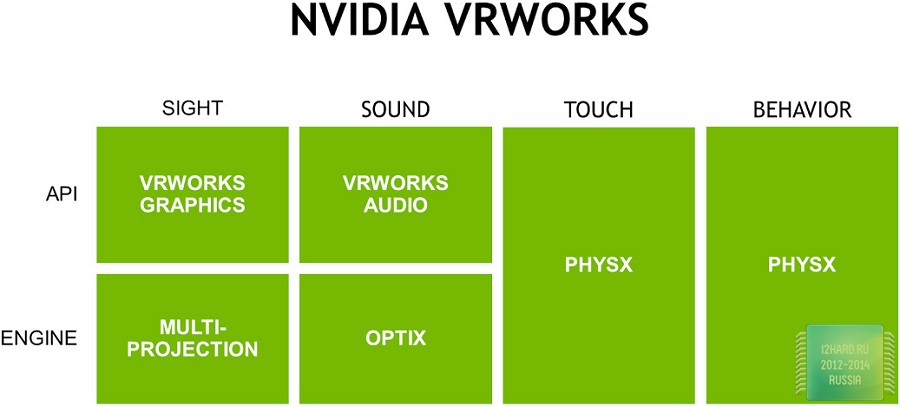
For lovers of multi-monitor configurations and virtual reality helmets, NVIDIA has prepared a one-time multiprojection technology ( Simultaneous Multi-Projection). In fact, this optimization is designed to simultaneously calculate the geometric data for several pre-prepared projections. What is it for? First, to eliminate various distortions when using curved monitors or configurations with multiple displays. Secondly, it allows you to improve performance for such use cases of your system. Few of us had the opportunity to try out NVIDIA 3D Vision at one time, but those who did, noted a noticeable lack of performance, since the video card had a double load when drawing images for each eye. With the introduction of SMP, this problem is eliminated.

Also, it is impossible not to mention two interesting innovations, which are entitled as Ansel and Fast Sync.
Ansel - an invaluable tool for creating related gaming content, which is useful for streamers and authors of various gaming blogs. During the game, you can pause and adjust the camera at any desired angle to create a screenshot. In addition, you will be available to a number of effects to improve the image, as well as the ability to take a picture with stunning clarity. In addition, there is the possibility of creating 3D images, panoramic screenshots and 360 ° images. The truth should be said that it will be available only in those games where the corresponding support for this option will be introduced.

Fast sync - This is a kind of addition to such a function as VSYNC. In general, the activation of this innovation will allow you to get rid of the delays that occur when you turn on VSYNC. In addition, artifacts in the form of a picture break are eliminated, which can be noticeable when vertical synchronization is turned off. This scenario is valid only if the FPS value exceeds the screen refresh rate threshold.
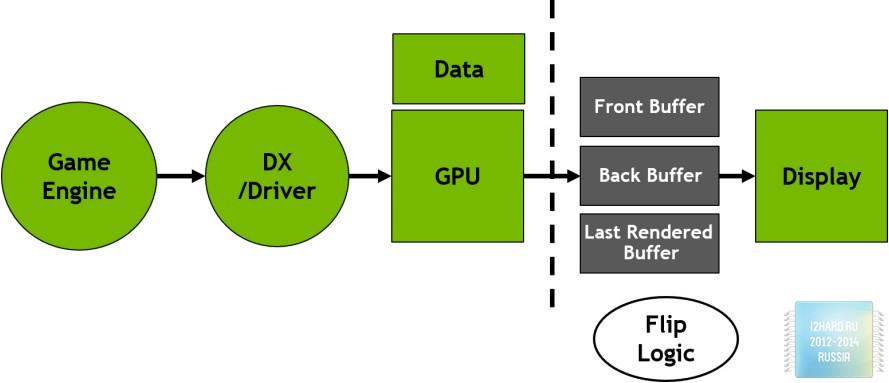
Positioning
To begin with we will be defined with a typical portrait of the consumer. Nvidia geforce The GTX 1060 has good performance and is aimed primarily at those who want to play comfortably on monitors with a resolution of Full HD (1920x1080). To acquire such a video card for playing WQXGA (2560x1440) and especially 4K UHD (3840x2160), the occupation is far from the most reasonable. Popularization of this model contributes to a more affordable price tag, which varies around 19 thousand rubles. Add here the low power supply requirements and we have a new contender for the best choice in the middle price segment. The only negative aspect in this case is the lack of the possibility of combining several video cards in SLI. This can take advantage of a competitor that offers RX 480 with support for Crossfire.
Packing and packaging
The video card came to the test without packaging. However, the box and equipment are no different from those discussed earlier in the material on. In turn, I want to note that in versions from third-party brands, the equipment can be supplemented with various adapters and accessories or bonus codes for current game projects.
Appearance of the product
Externally, the video card does not look as impressive as the GTX 1080 or GTX 1070. Despite this, it is impossible not to note the expressive outlines in the design and use of quality materials. The advantages of Founders Edition are undoubtedly compact size, which guarantees compatibility with any standard components of a computer assembly. The video card takes exactly two slots, and its length does not exceed 25 cm.
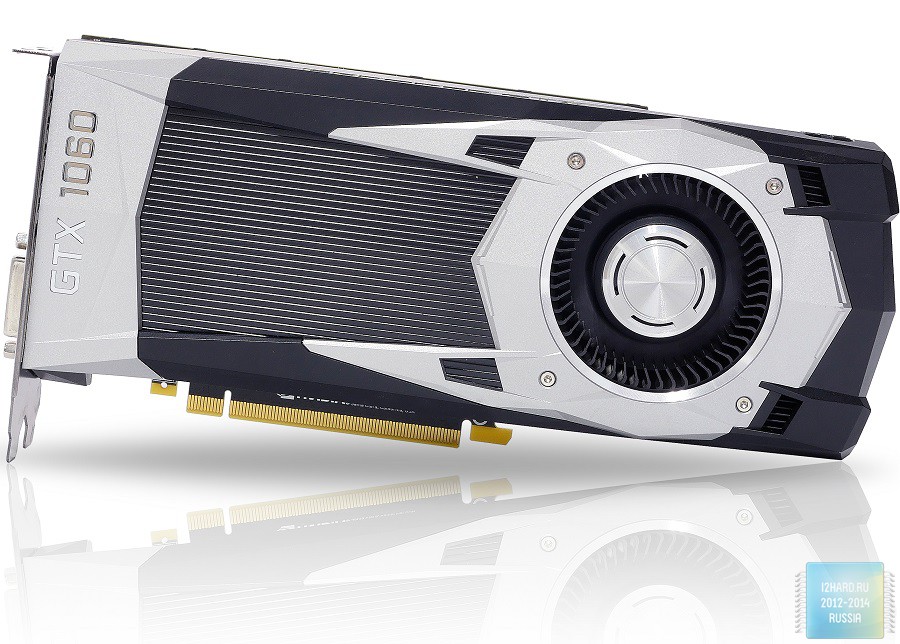
The absence of a metal plate on the back side slightly spoils the final impression of the device, which case owners with a transparent side window will especially notice. Also striking is the fact that the PCB is noticeably shorter than the cooling system installed on it.
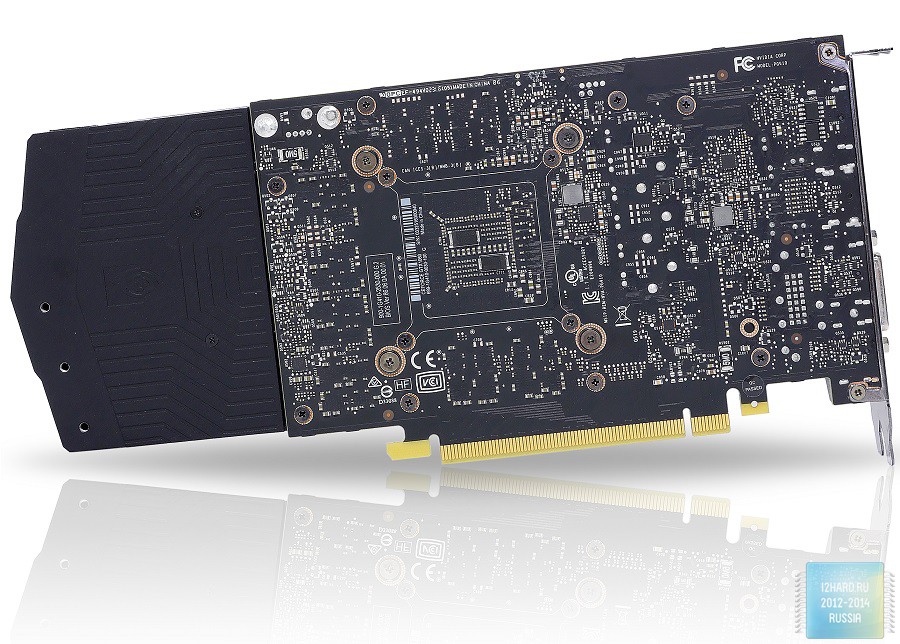
To connect additional power, the device is equipped with one 6-pin connector, which is located on the end closer to the end of the board. For proper operation, you will need a power supply with a capacity of 400 watts or higher. A distinctive feature of the GTX 1060 from the older brothers in the face of the GTX 1070 and GTX 1080 is the lack of a connector for combining video cards in SLI. And this is despite the fact that the closest competitor from AMD, this option is implemented.
It is curious to observe how with the increase in the performance of a video card, they are becoming more and more economical in consumption and against this background there is no need for superpower power supplies. There is also no need to use bulky alternative cooling systems, but some manufacturers continue to install three fans and huge radiators even for such economical solutions as the GTX 1060. The pleasant nuances include the presence of a green logo illumination, which is regulated through the GeForce Experience application.
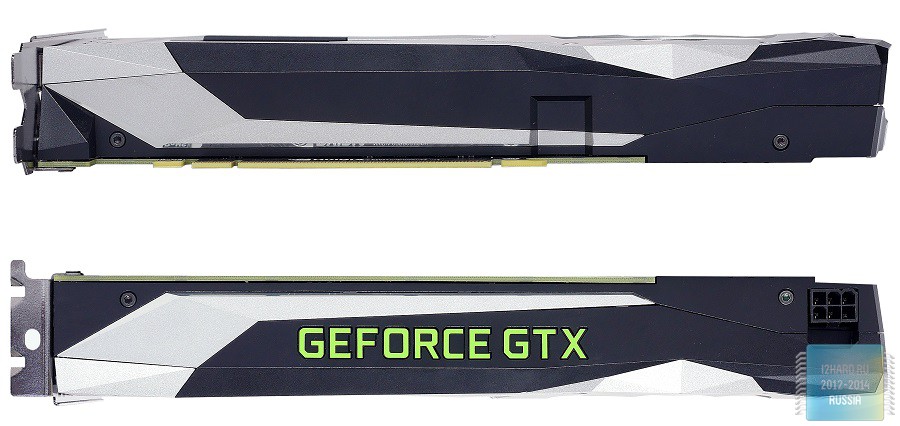
On the front end, there is a lack of any additional connectors, only radiator fins are visible here. If you look closely, this angle causes persistent associations with the bumper and the hood of the car.

The interface panel is unremarkable and repeats a typical set of ports, which we have repeatedly seen on the video cards of the previous generation: 3 DisplayPort, DVI-D, HDMI 2.0.
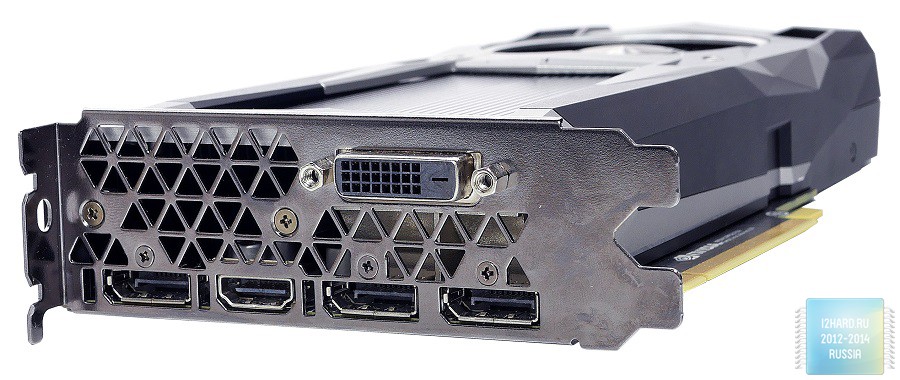
Cooling system
The cooling system of the GeForce GTX 1060 Founders Edition is a turbine type design. To remove heat from the GPU, a separate radiator with a copper base is used. Memory chips with power elements that come into contact with a separate metal plate on which a fan is installed were not neglected. The fan impeller is equipped with some optimizations, which made it possible to reduce the noise level without reducing the air flow. I also want to note the absence of a “backplate”, which slightly impairs the final appearance.
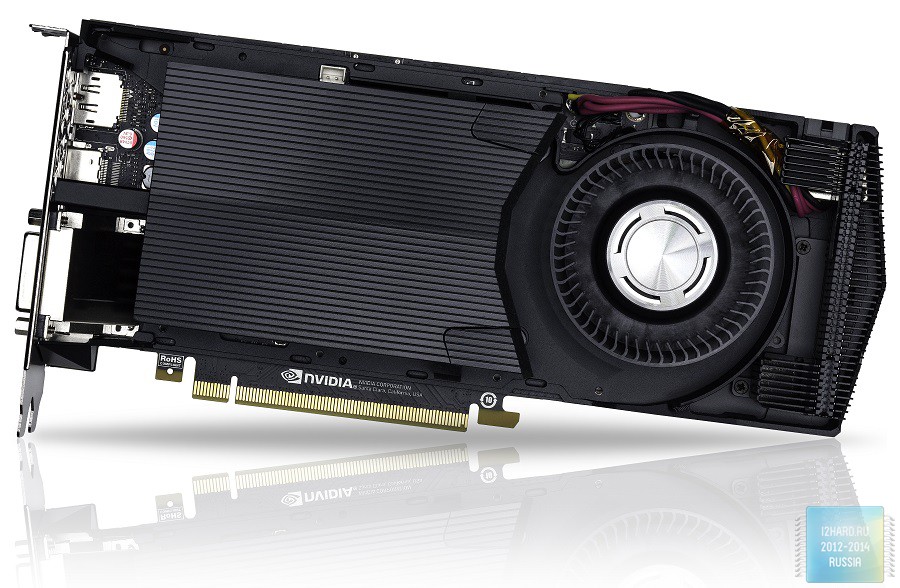
Most often, video cards with a reference cooling system are used where it is necessary to bring hot air out of the case. Usually this means operation of the accelerator in compact assemblies, where the possibilities for installing additional fans are very limited.
Printed circuit board
Before us is a compact printed circuit board made in black with a classic arrangement of components. In the central part there is a graphics chip around which the memory chips are soldered. The power subsystem is located on the left side.
Note the lack of a protective frame around the GPU. This means that you must be extremely careful to remove or install the cooling system in order not to accidentally damage the chip.
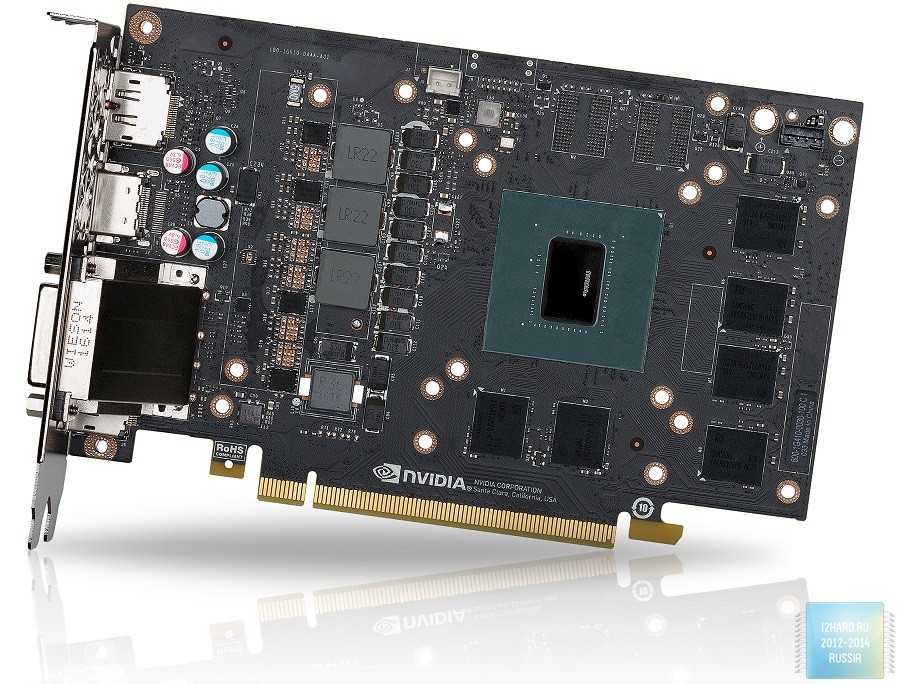
The total memory is accumulated by six chips labeled Samsung K4G80325FB. The power subsystem consists of 4 phases, three of which are reserved for the GPU and one for memory. For power management, the uP9509P PWM controller manufactured by uPI Semiconductor is used. NTMFD4C85N manufactured by ON Semiconductor are used as transistors.
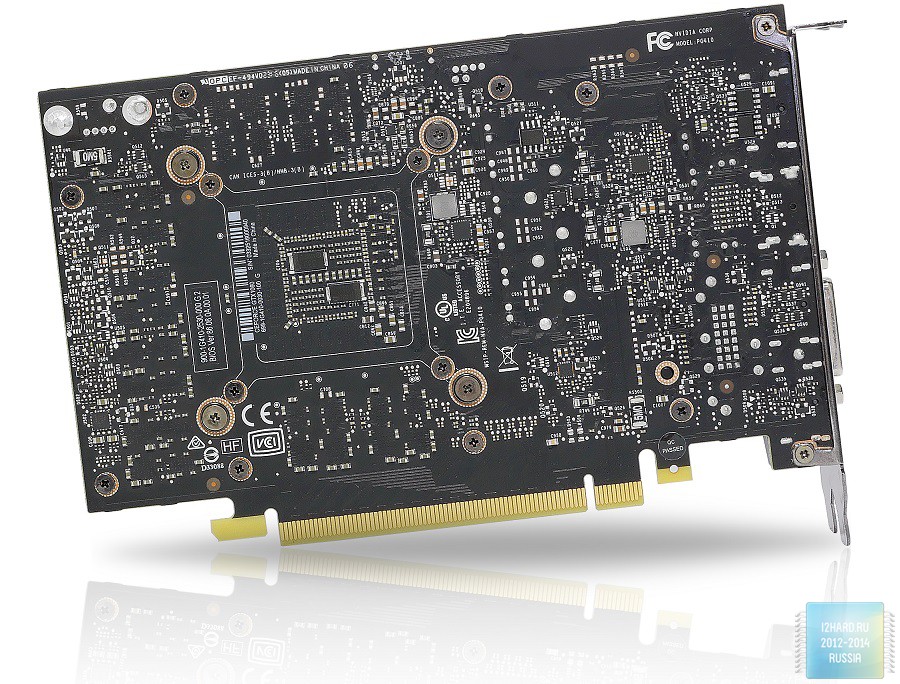
Testbed Configuration
- Processor: Intel Core i7-6700K (4000 MHz);
- Motherboard: GIGABYTE GA-Z170X-Gaming 7;
- Cooler:;
- Thermal Interface: Cryorig CP15;
- Memory: 4 x 4 GB DDR4 3400,;
- Video card: NVIDIA GeForce GTX 1060;
- SSD Drive: ;
- Fan speed controller: Schyte Kaze Q-12;
- Power Supply: ;
- Enclosure: NZXT Switch 810;
- Monitor: SAMSUNG U32E850R;
- Operating system: Windows 10 64-bit.
- Drivers: GeForce 368.81.
The Intel Core i7-6700K was used as the central processor, while the processor frequency was nominal. The role of the platform was performed by the GIGABYTE GA-Z170X-Gaming 7 motherboard. The FCLK value was set manually and corresponded to 1000 MHz. The memory functioned at a frequency of 3400 MHz with an active XMP profile with timings of 16-18-18-36.
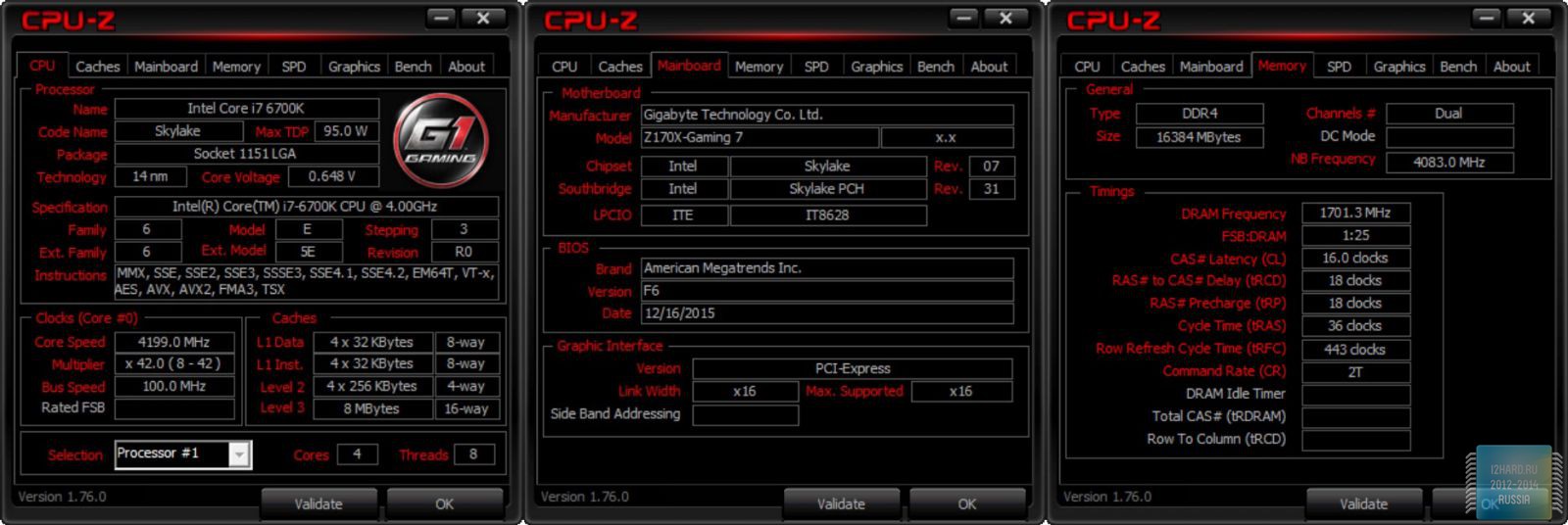
The specimen in question is a reference: the core and memory frequencies correspond to standard values, and reference CO is used for cooling. The thermal interface for the GPU corresponds to the factory one.

Synthetic tests
Valley Benchmark, Heaven Benchmark and 3DMark13 were used to evaluate performance in synthetics.


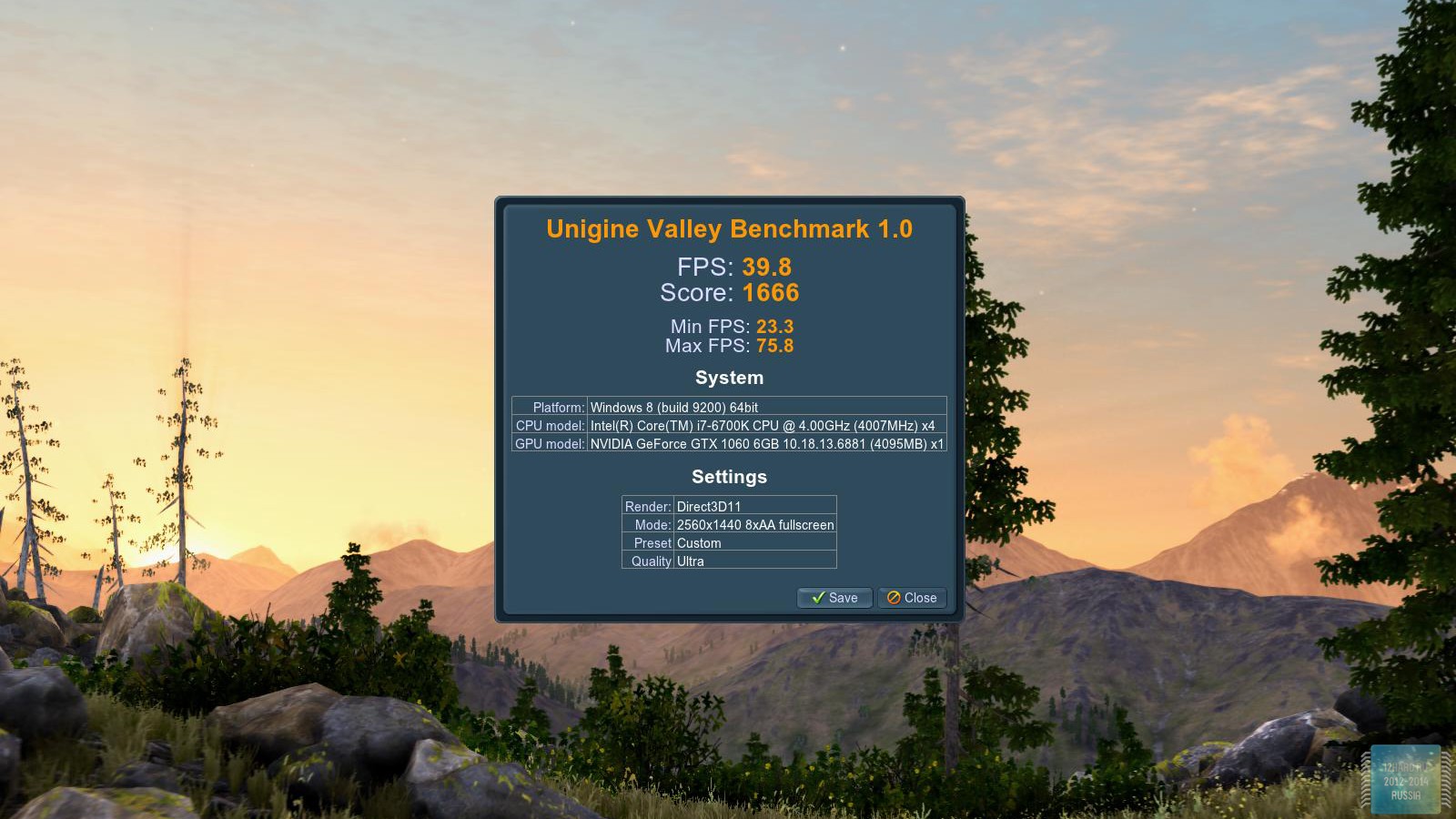
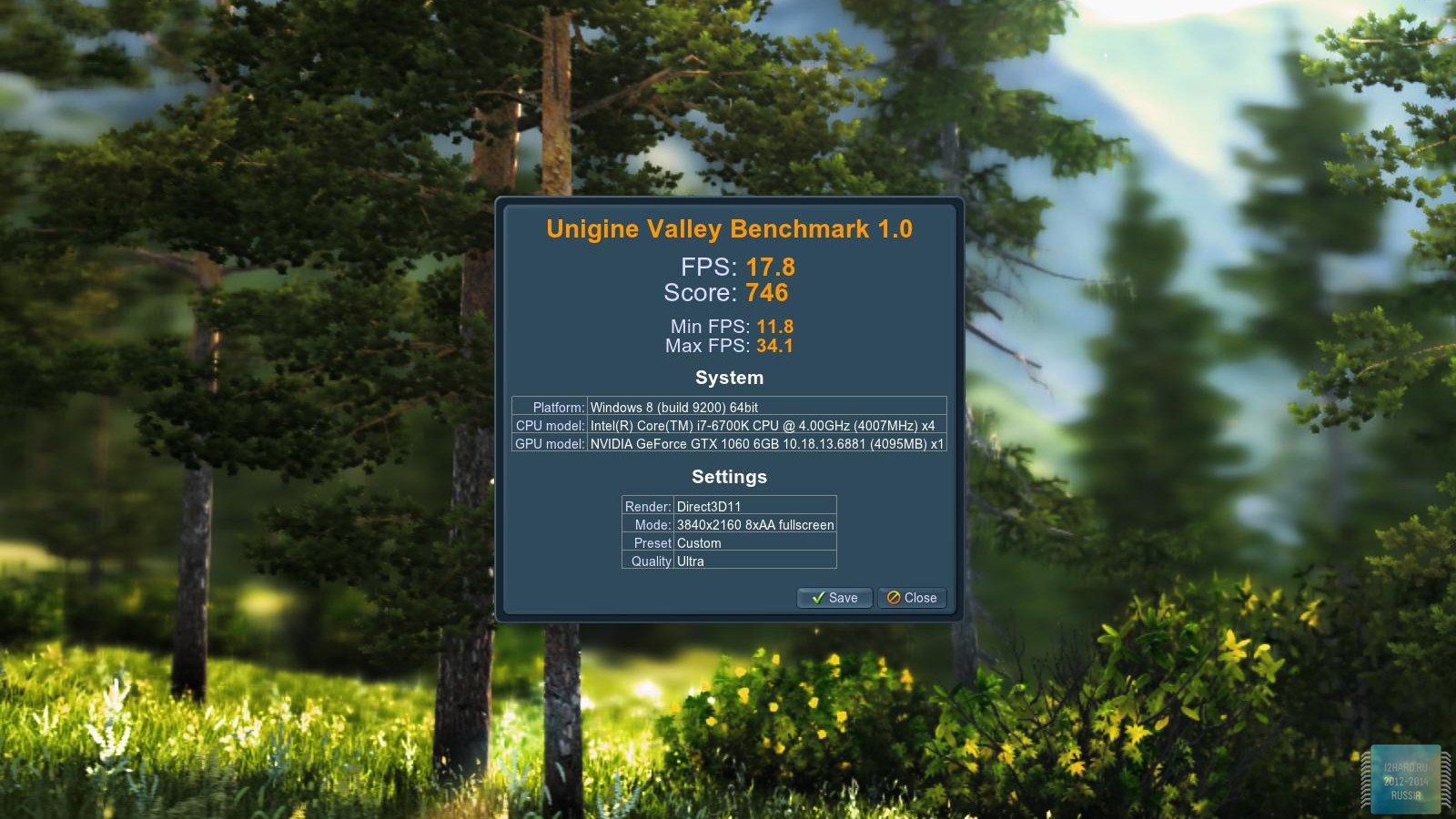






Game Tests
Let us turn to gaming applications and focus on the method of testing. The FPS measurement was performed using the FRAPS utility. All games were tested in the three most relevant resolutions: 1920x1080, 2560x1440 and 3840x2160. Manually disabled the following options:
- Vsync (vertical sync)
All other settings, including anti-aliasing, were set to the maximum possible. For clarity, each game is equipped with screenshots from the graphics settings menu, only the resolution was changed, all other parameters remained unchanged.

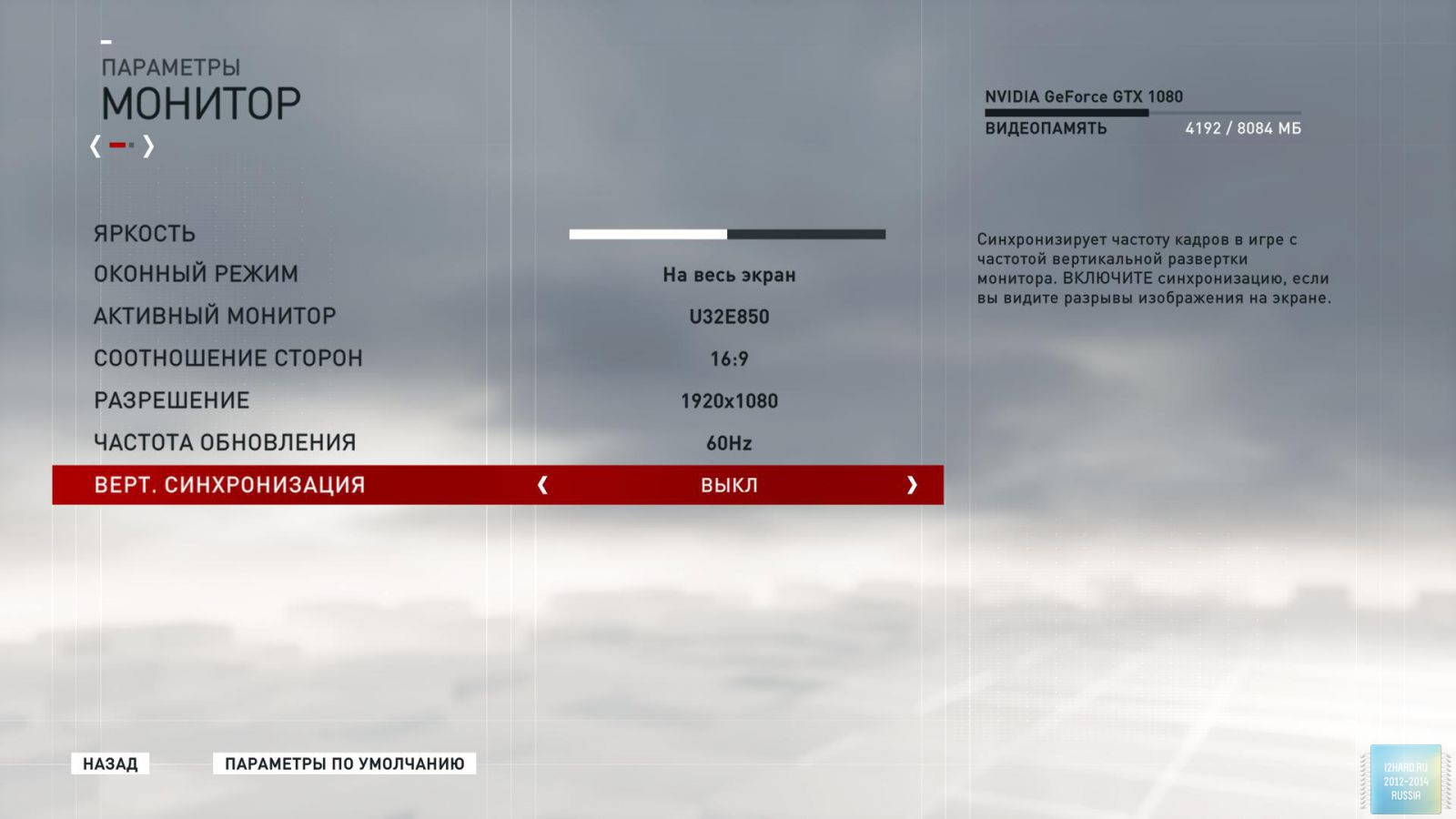
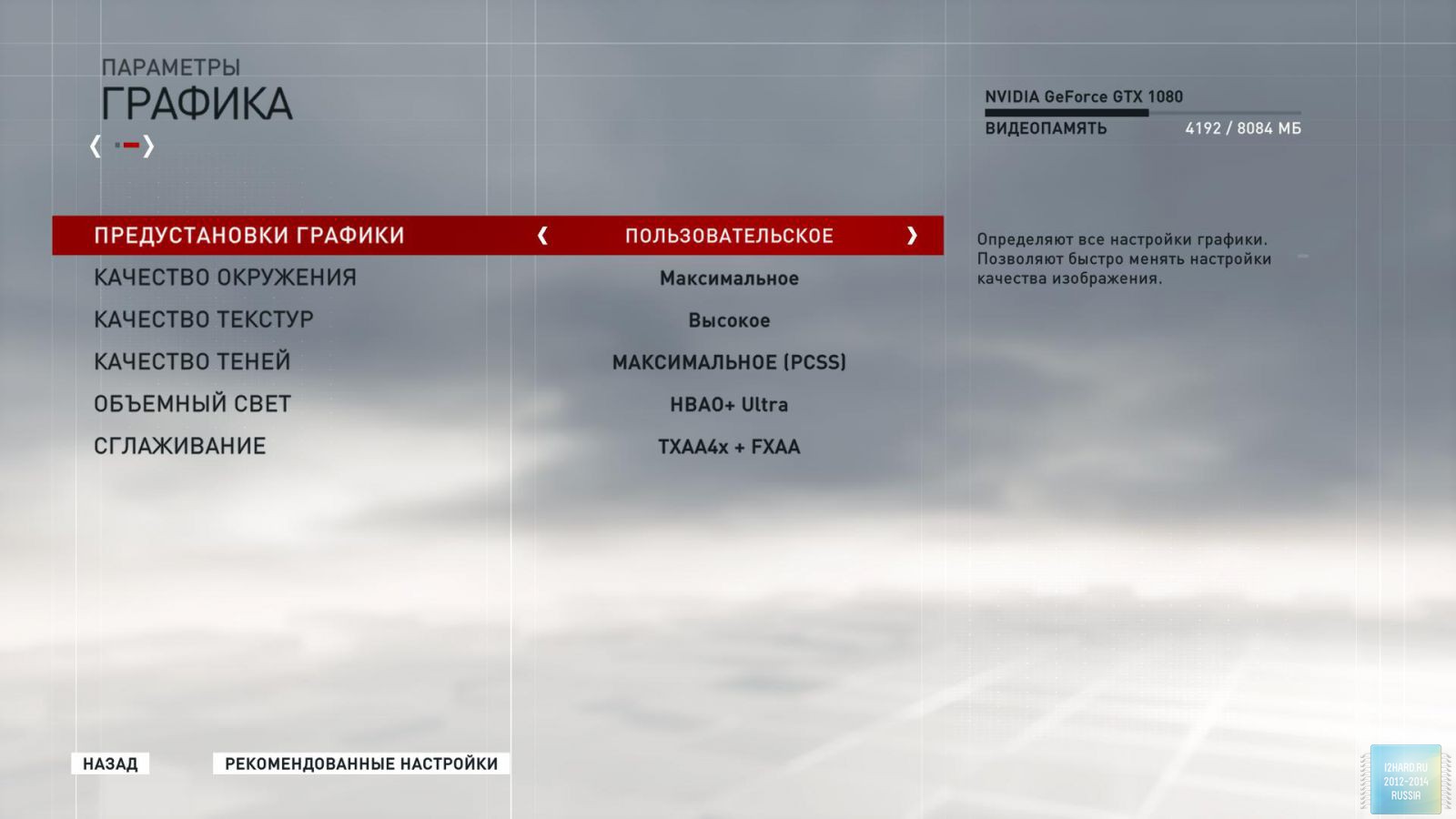


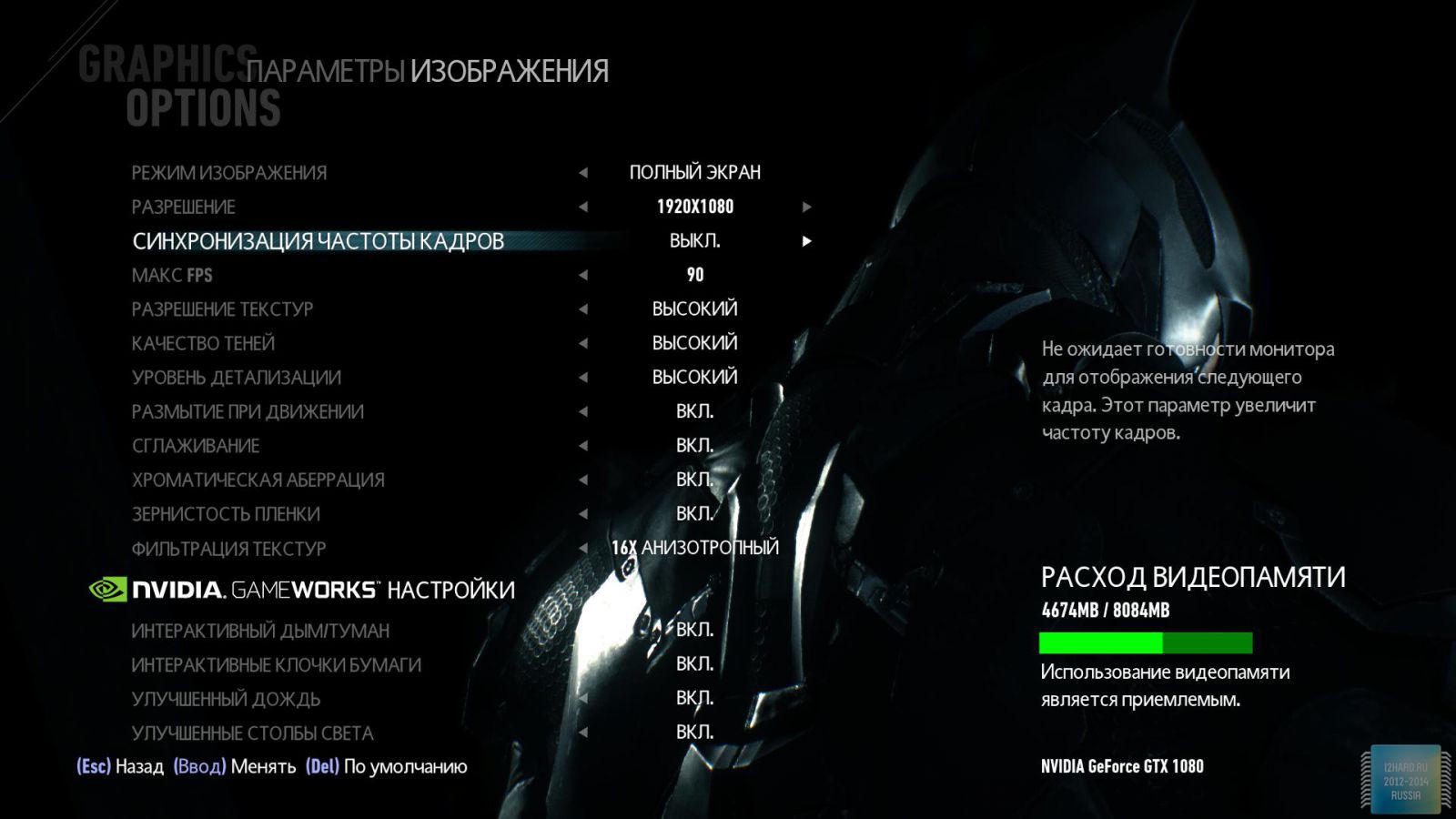
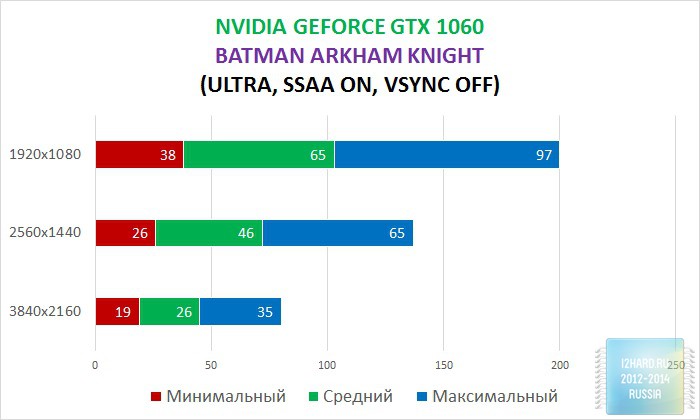


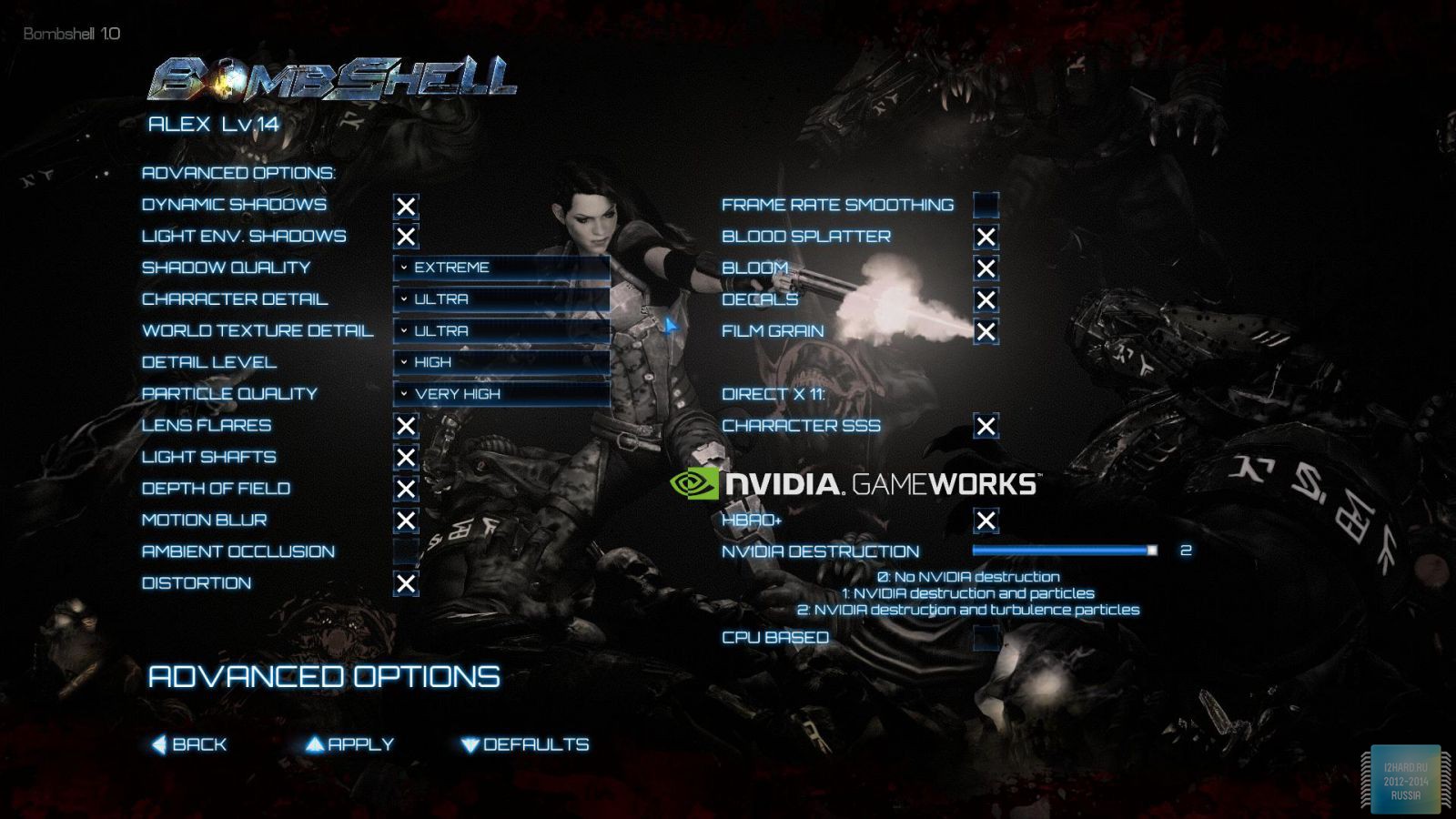


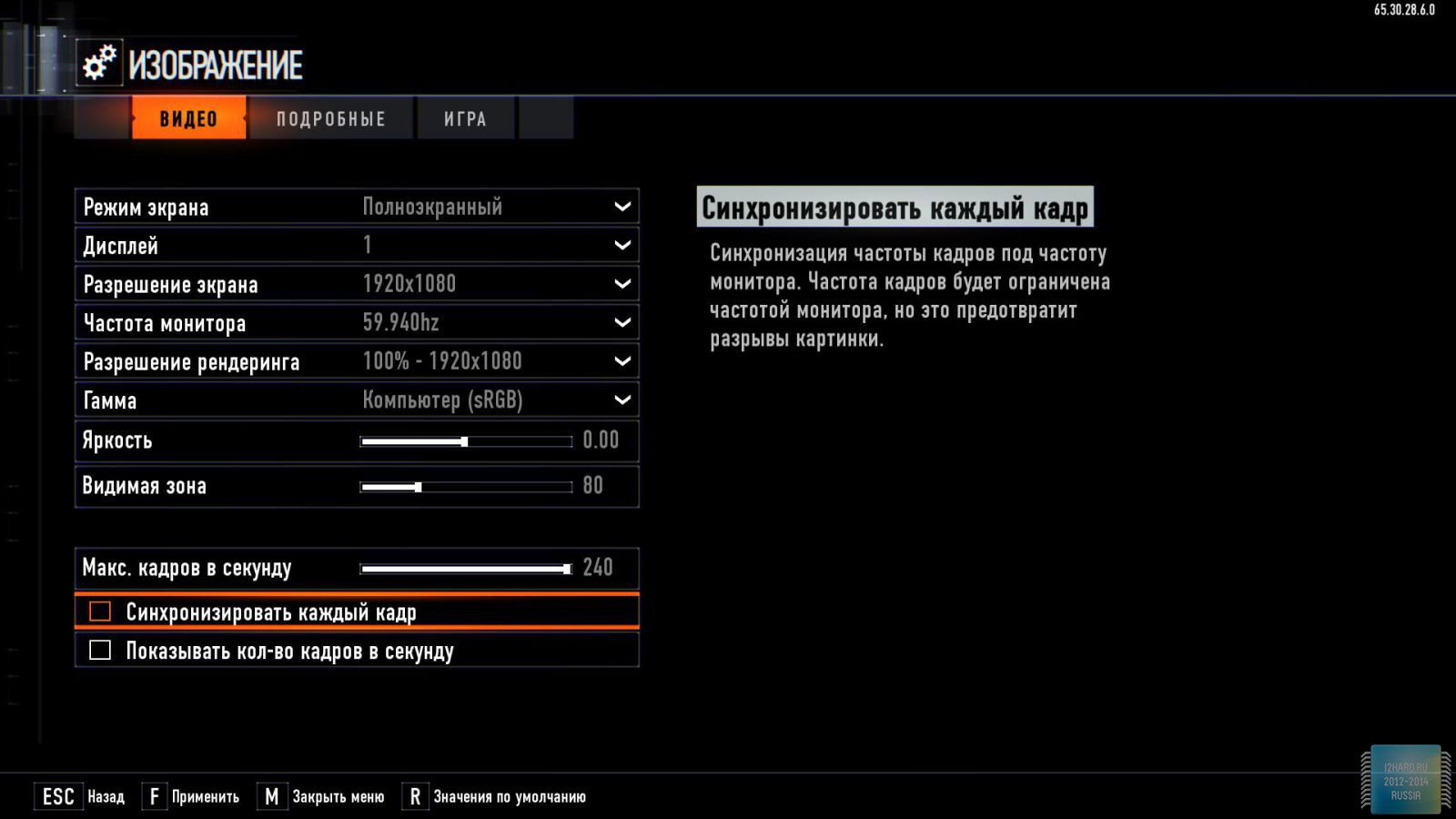



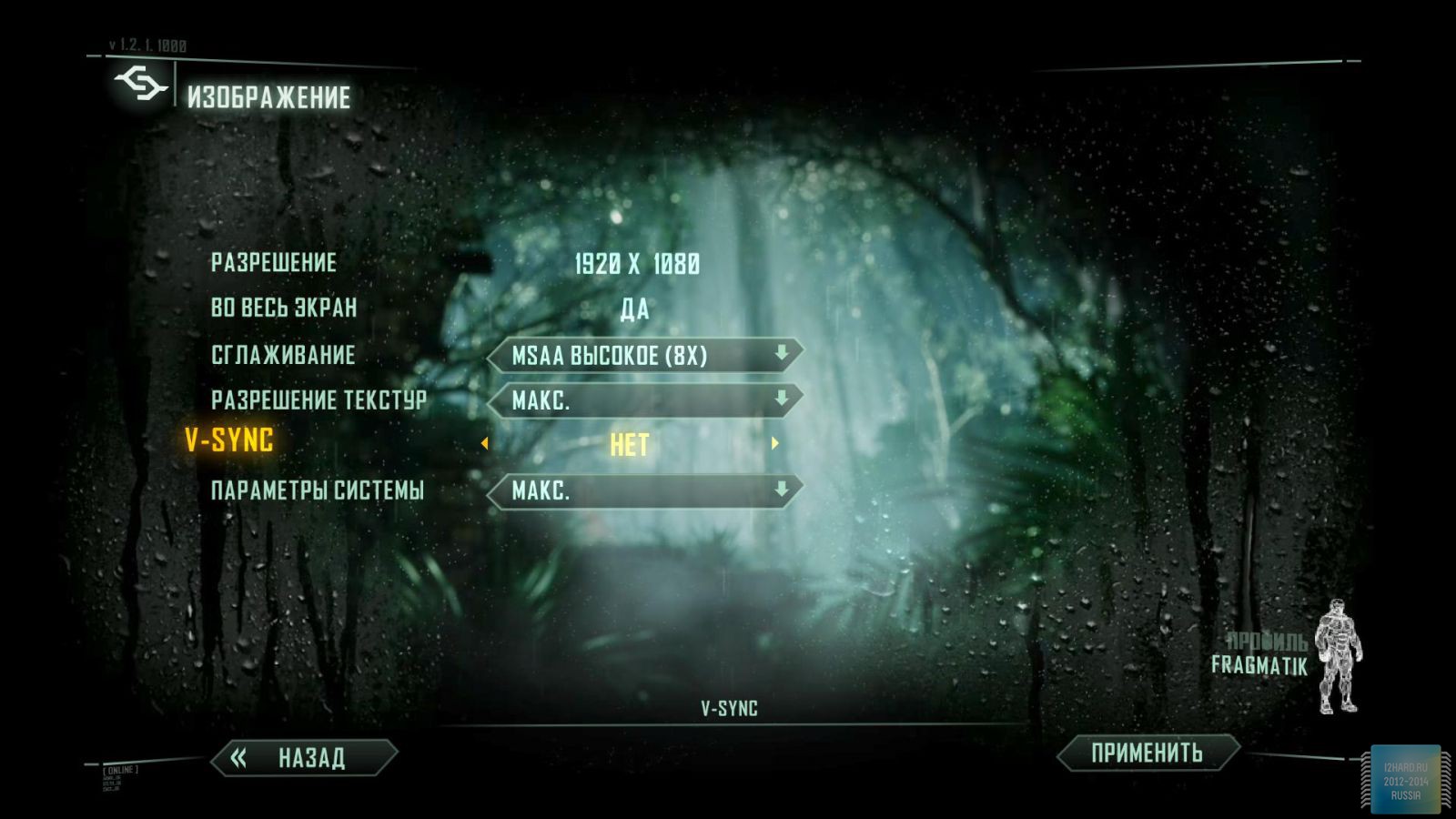
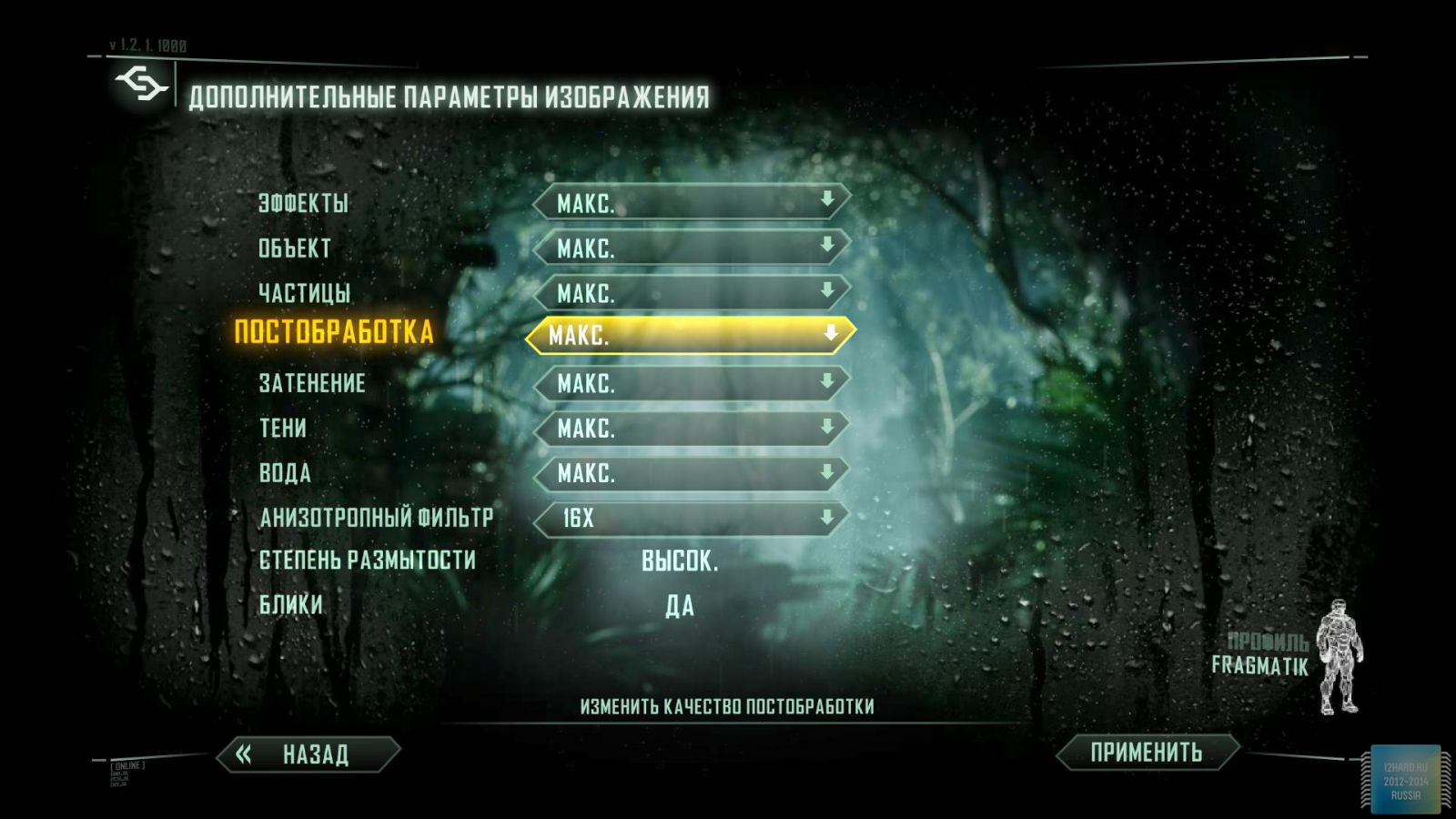
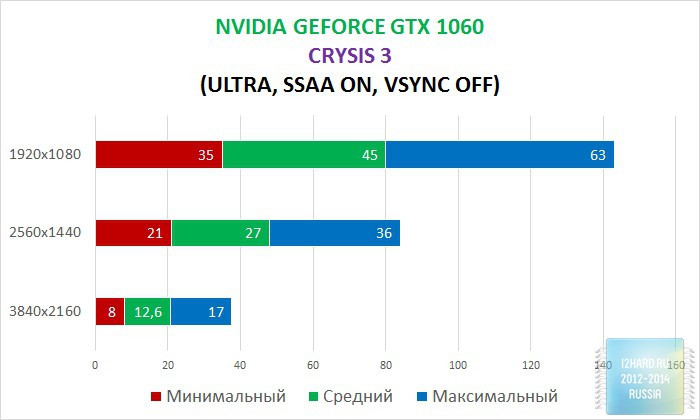

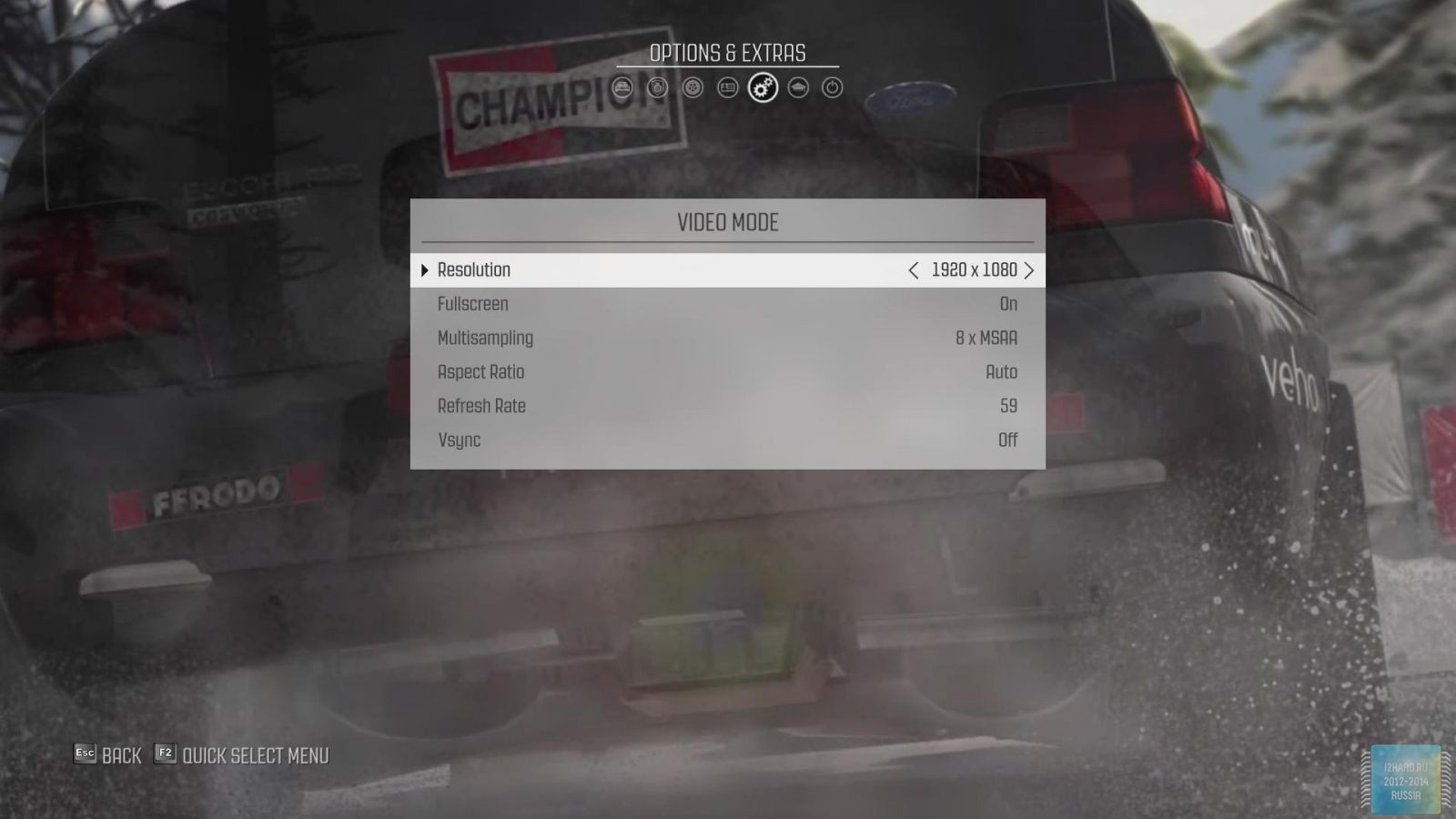
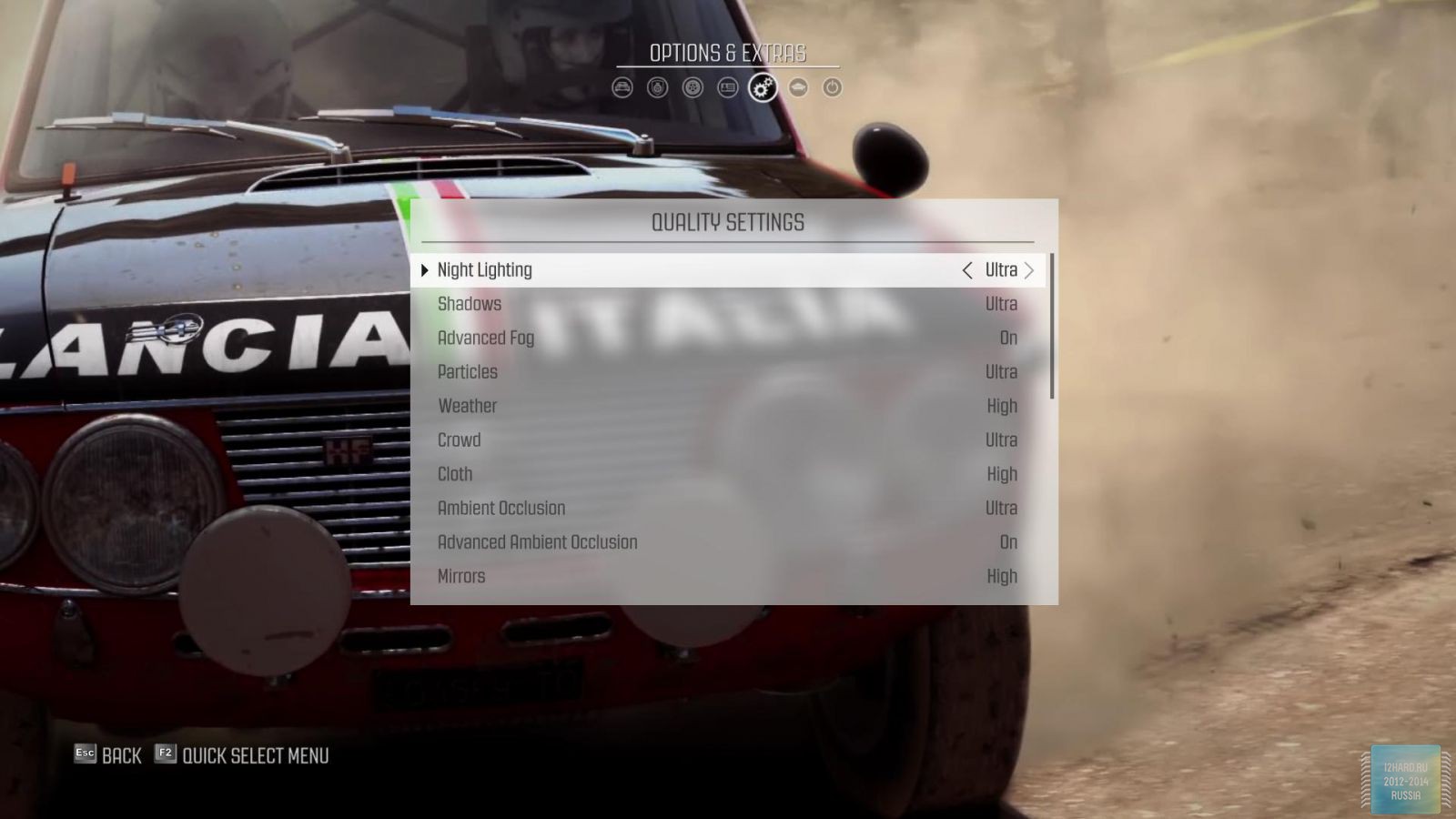


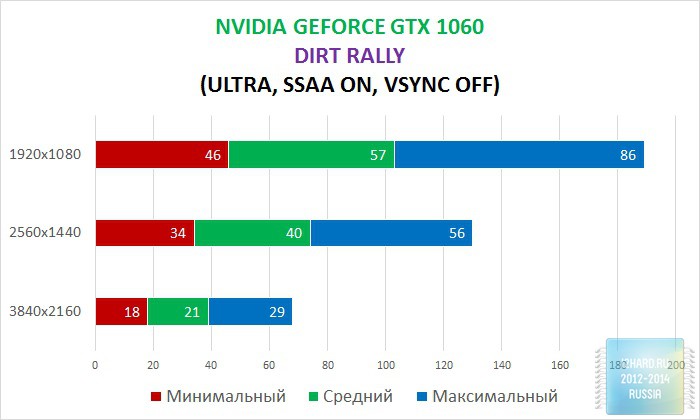

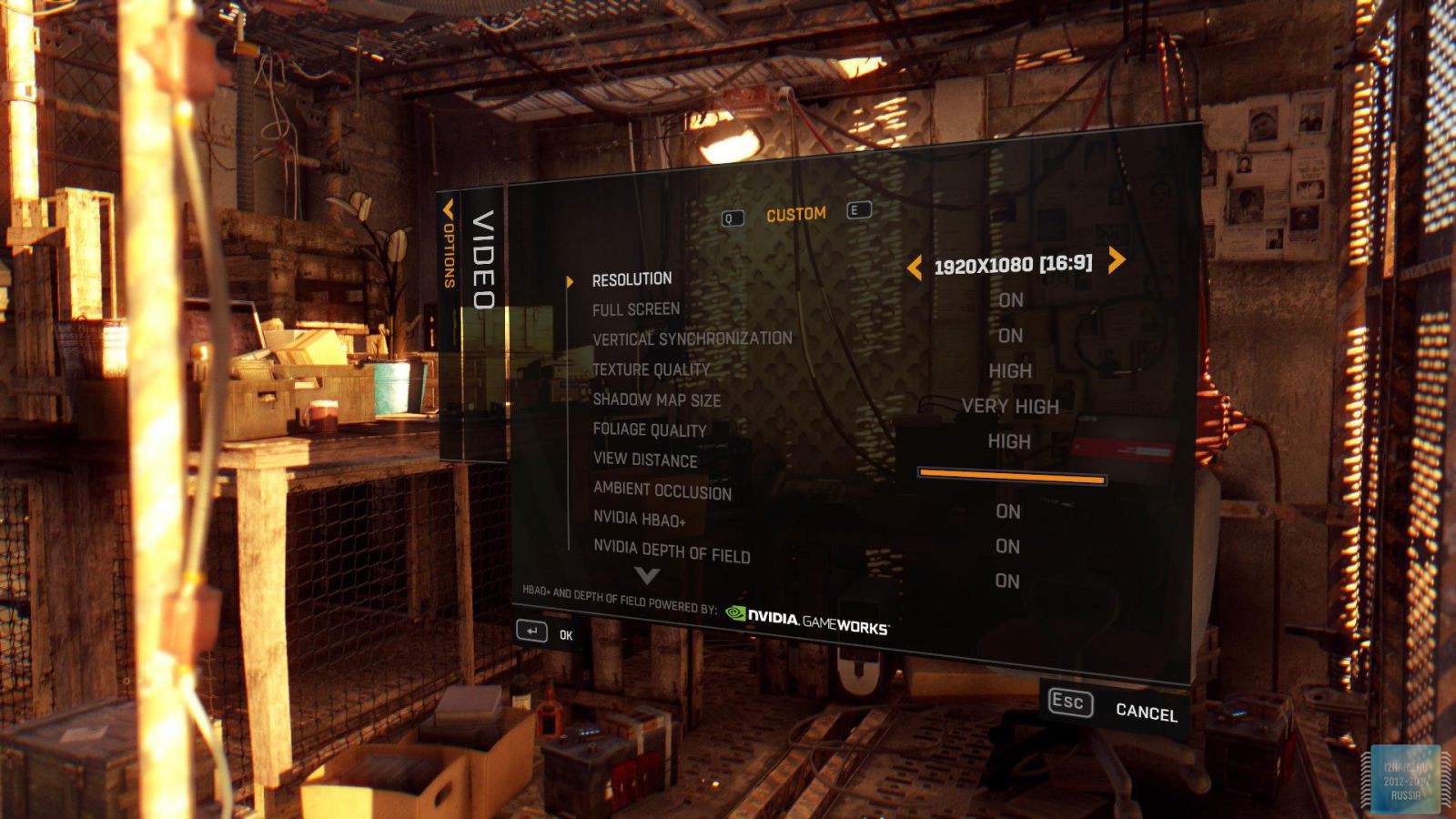
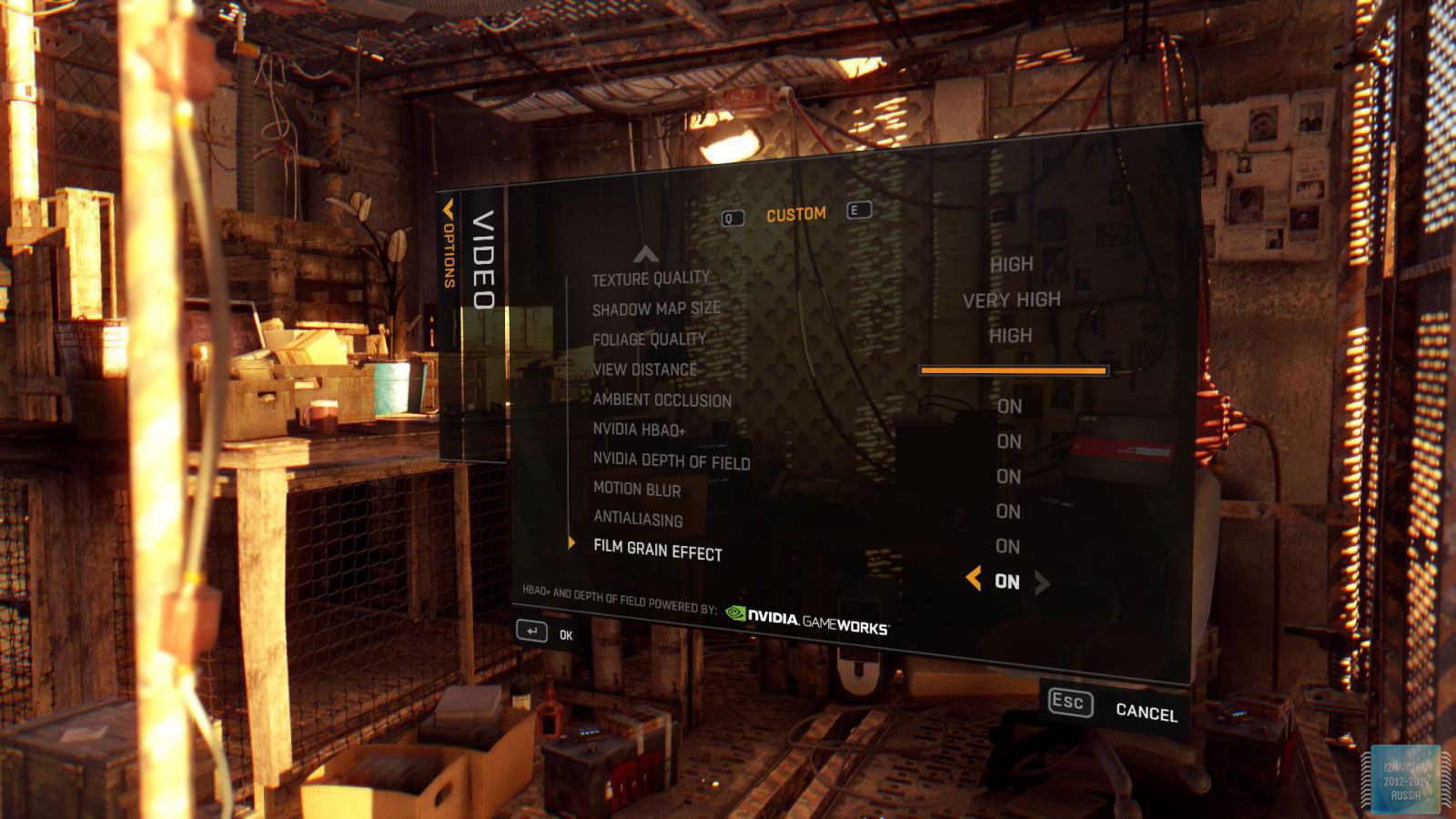
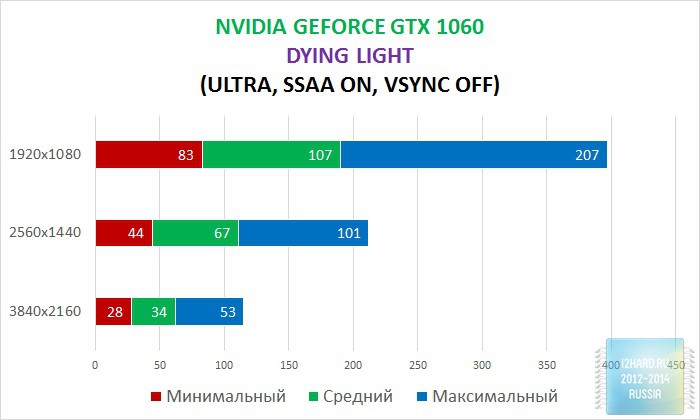




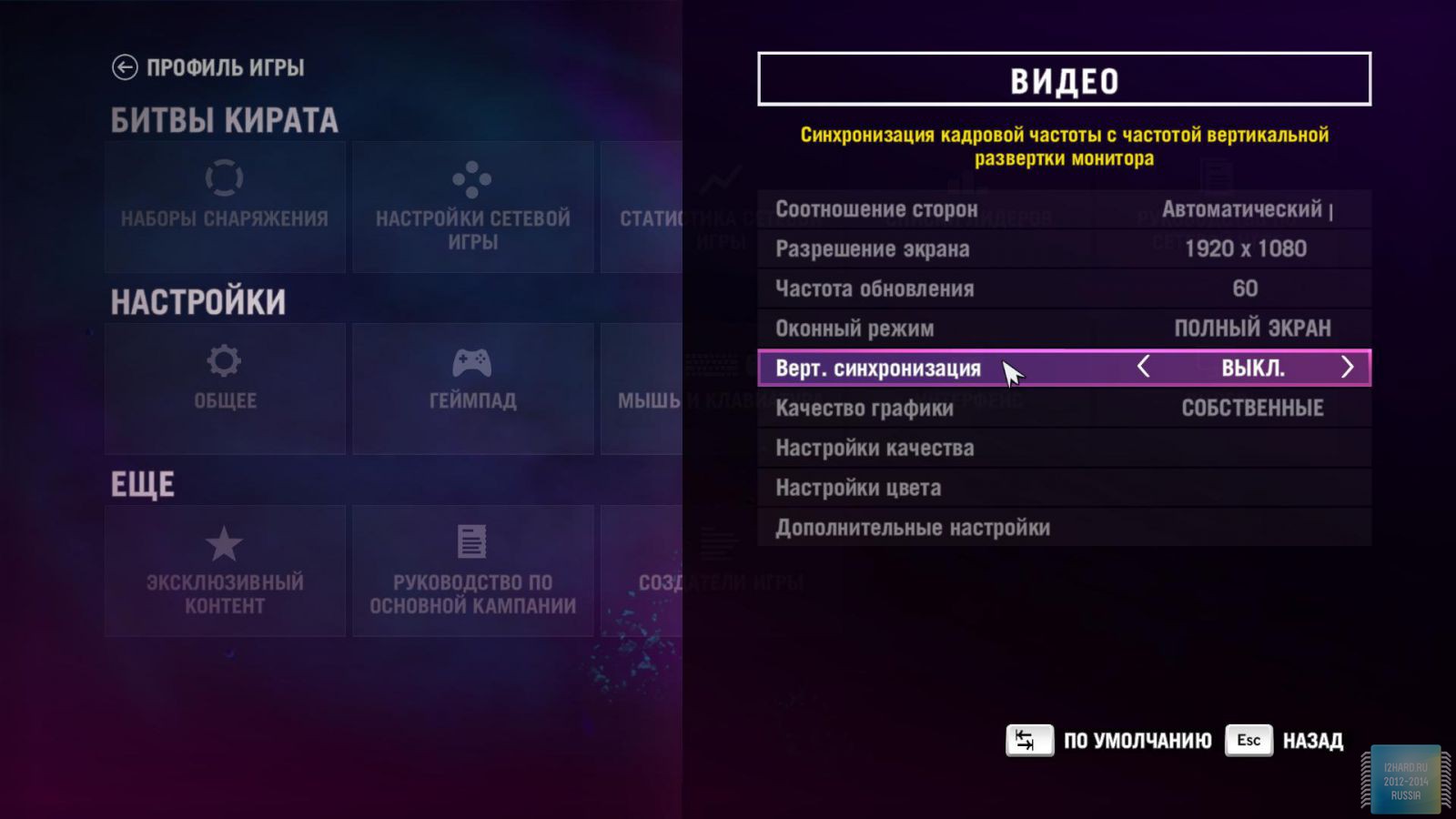




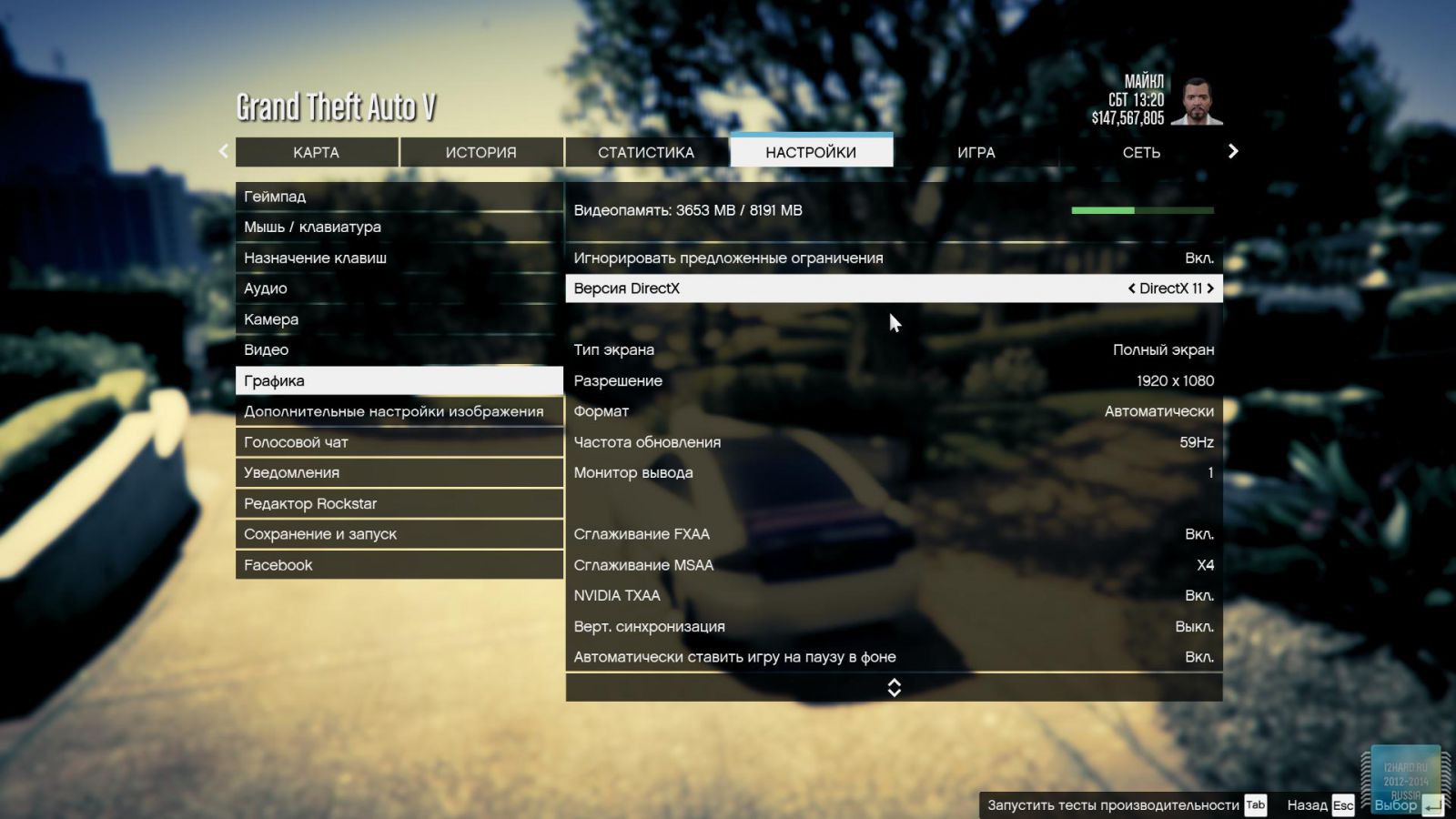
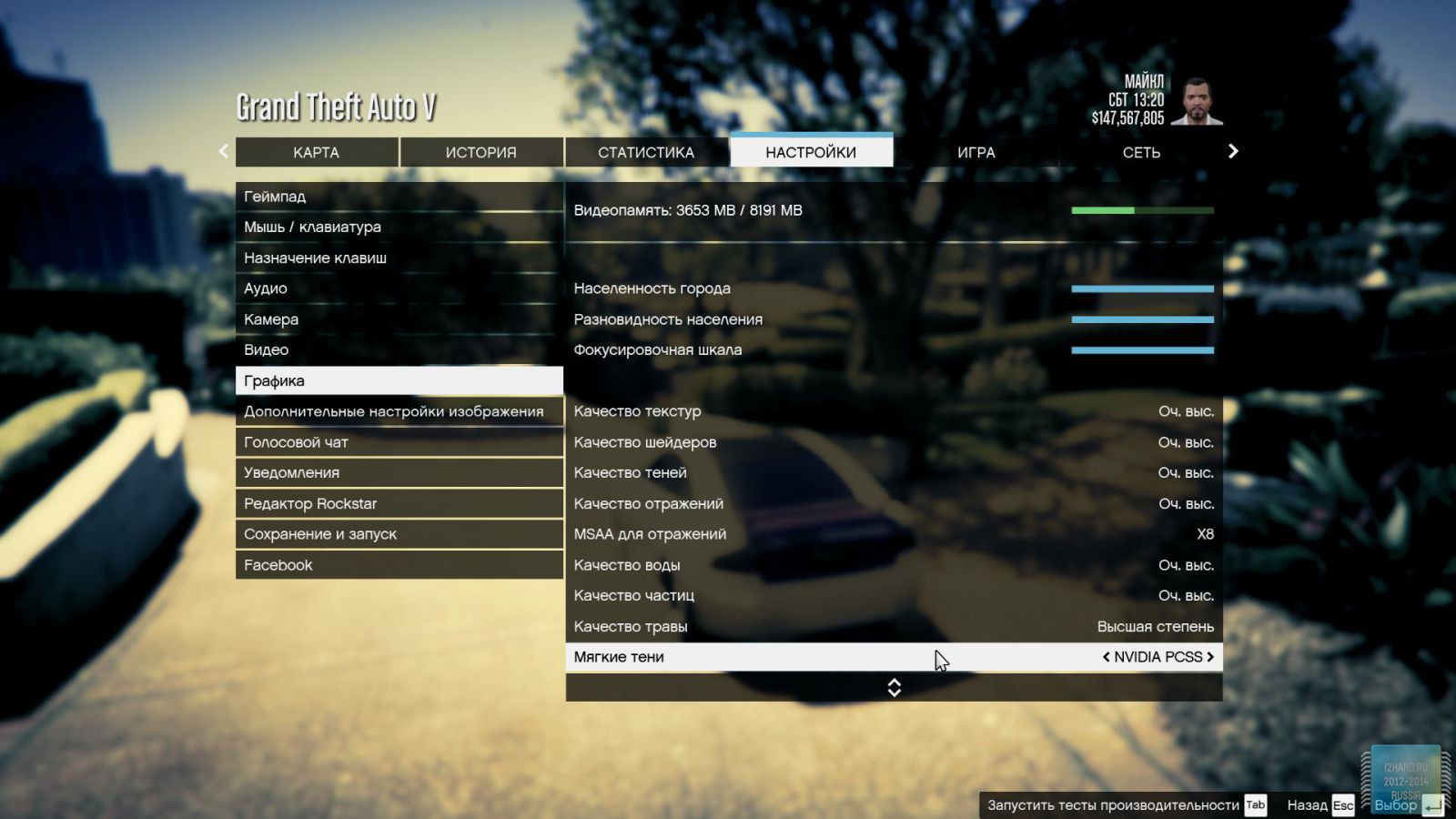
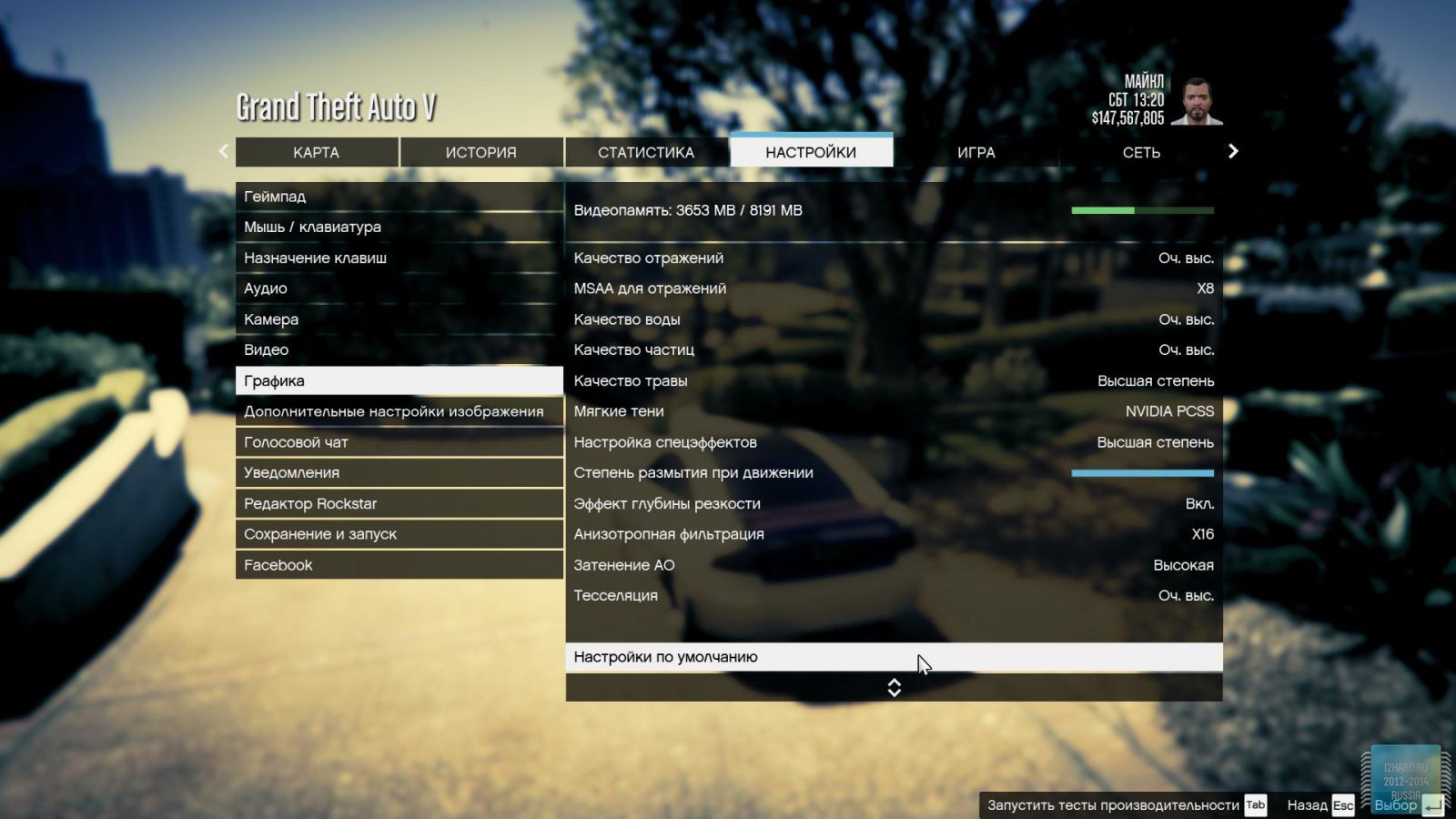
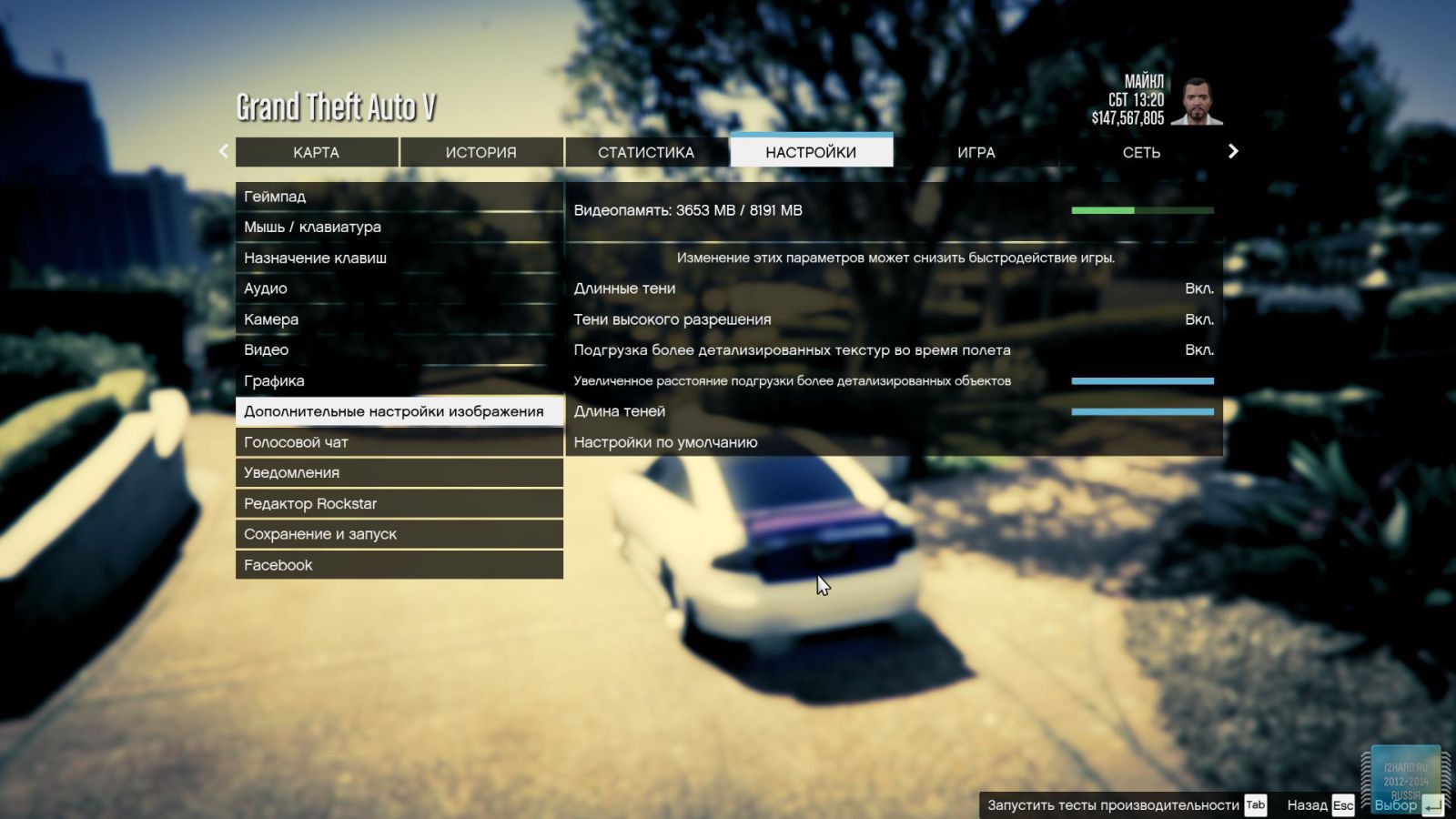
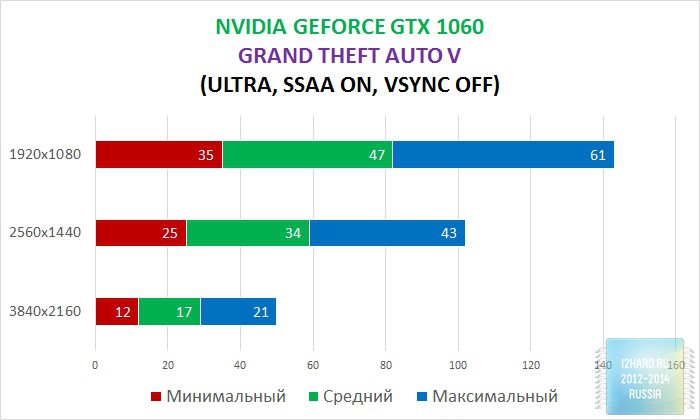

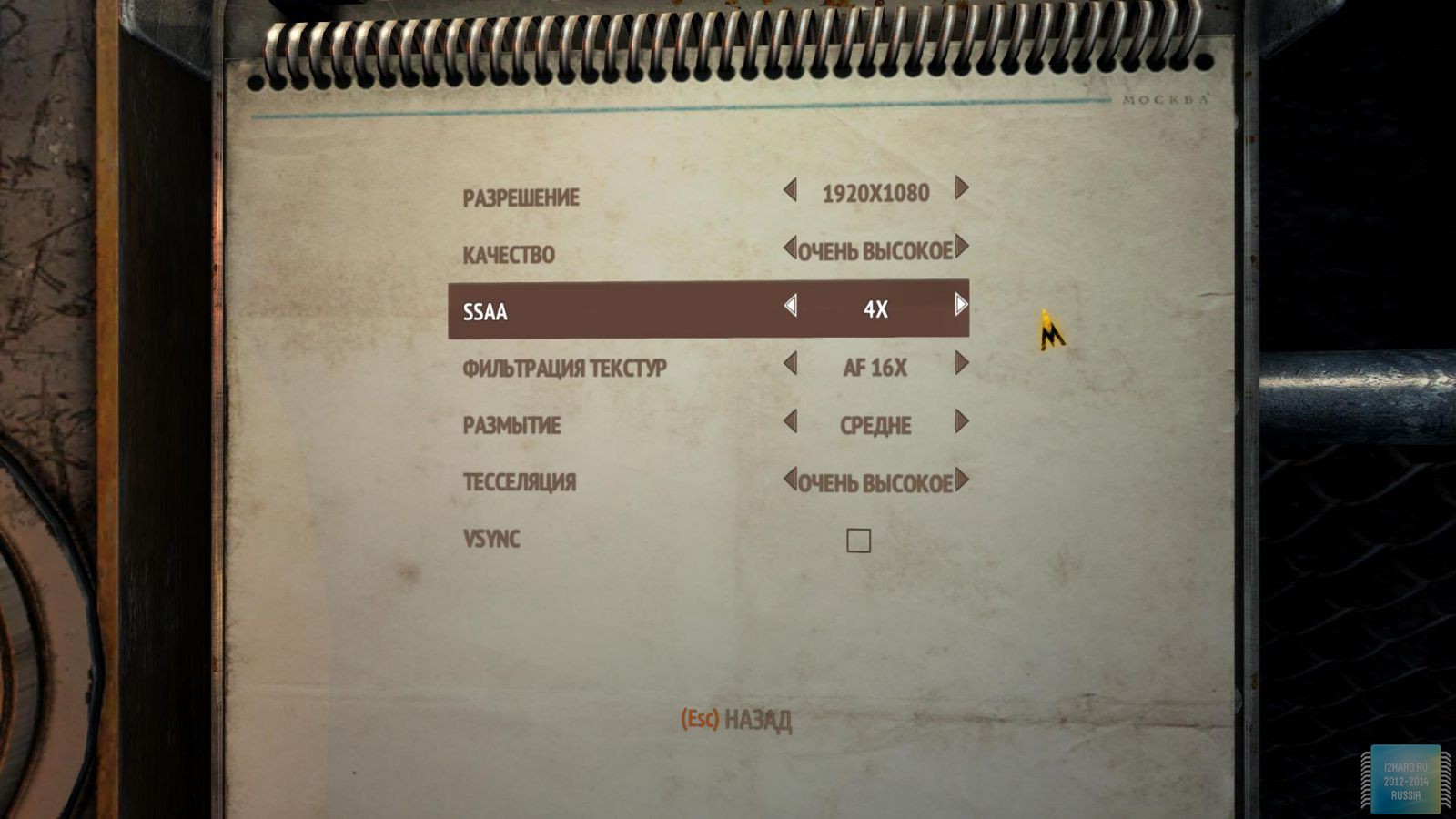
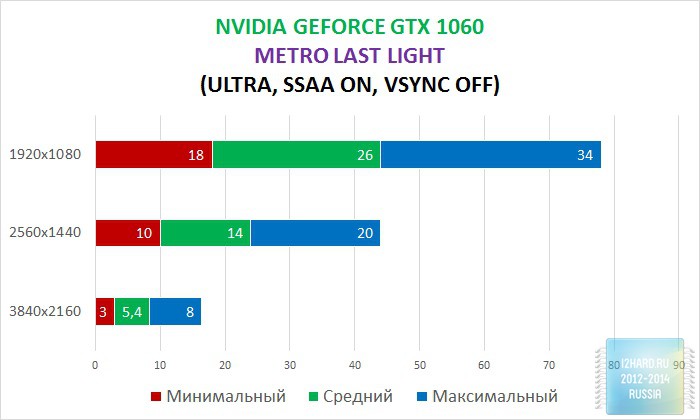

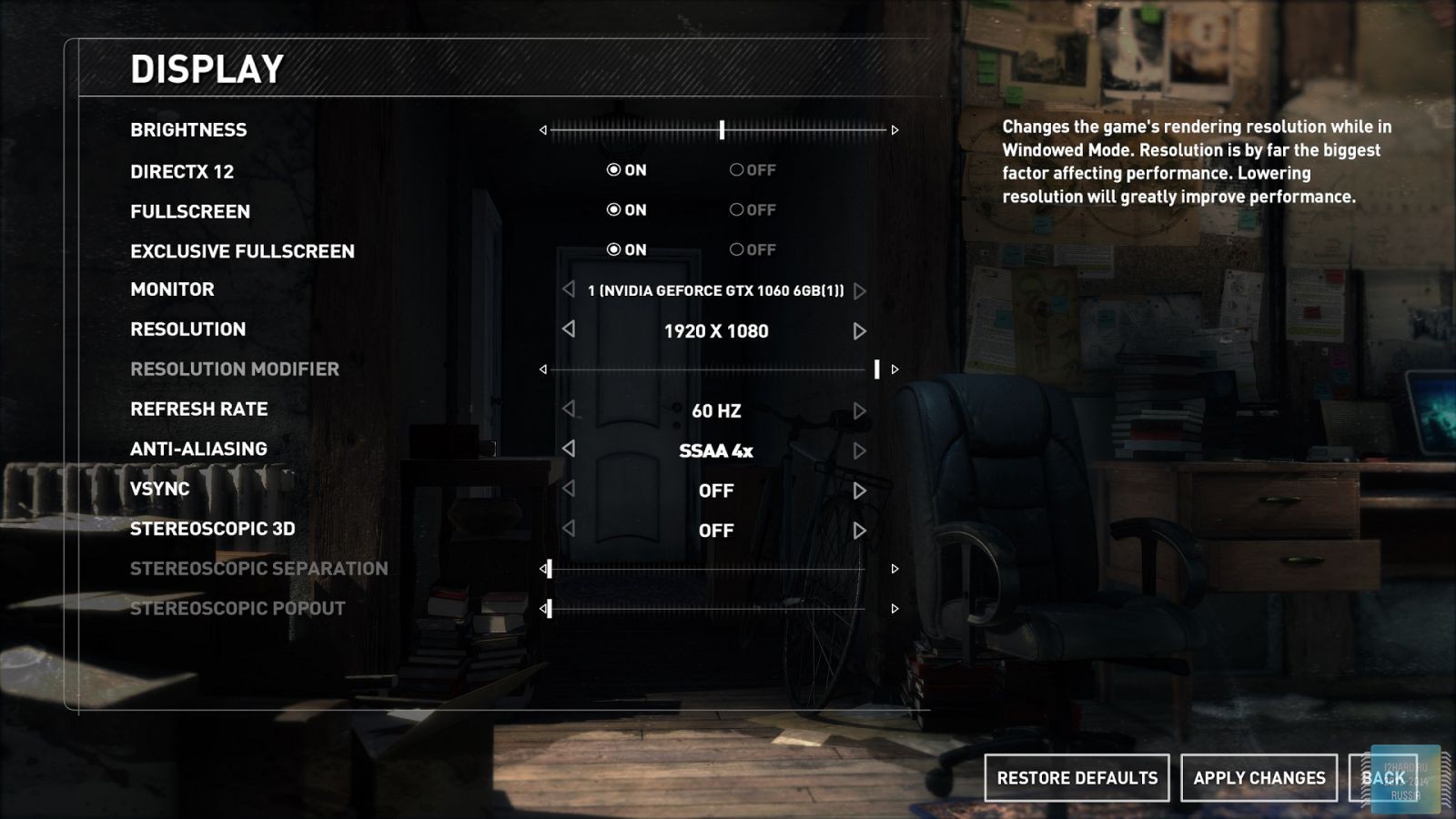

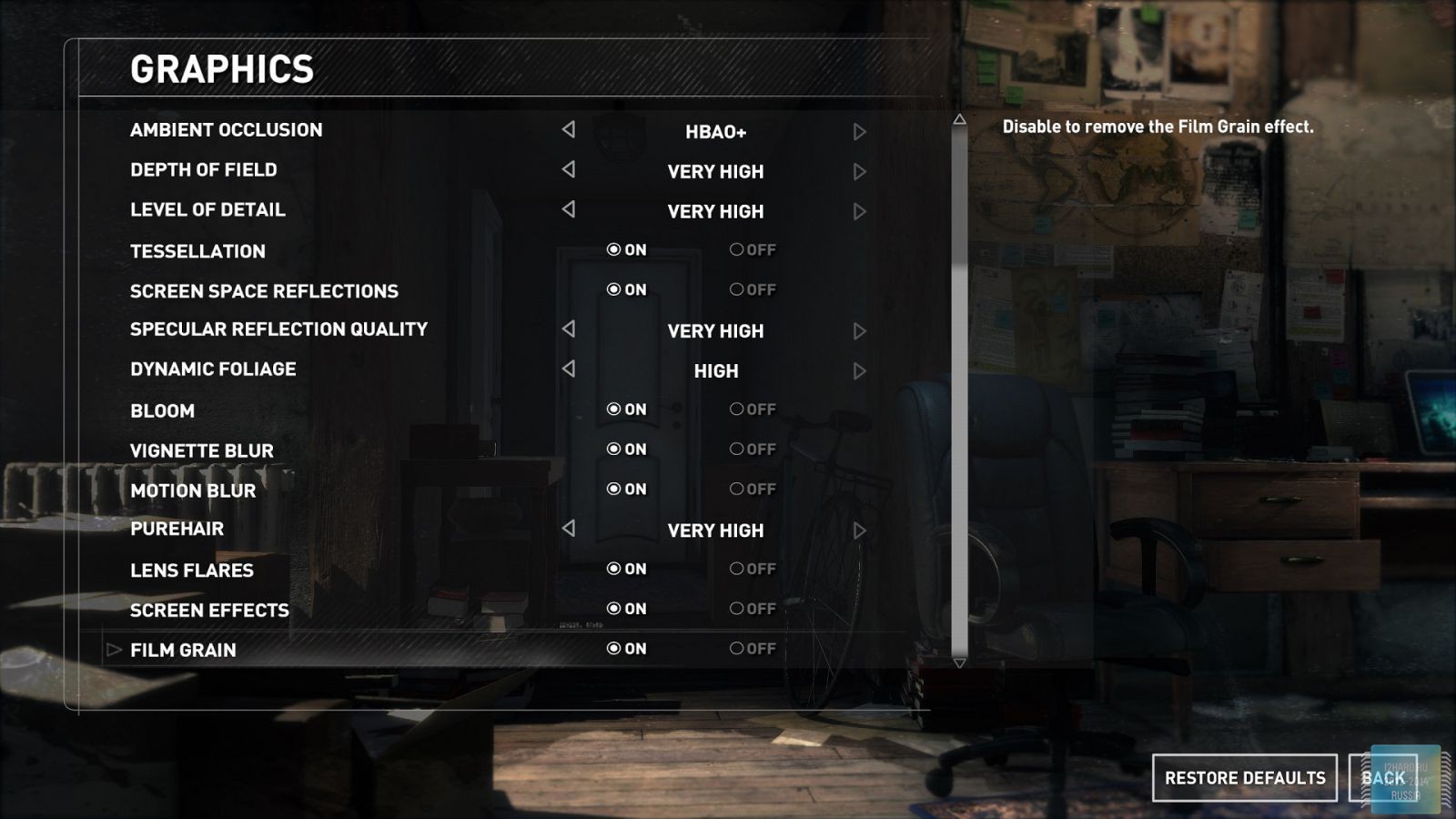
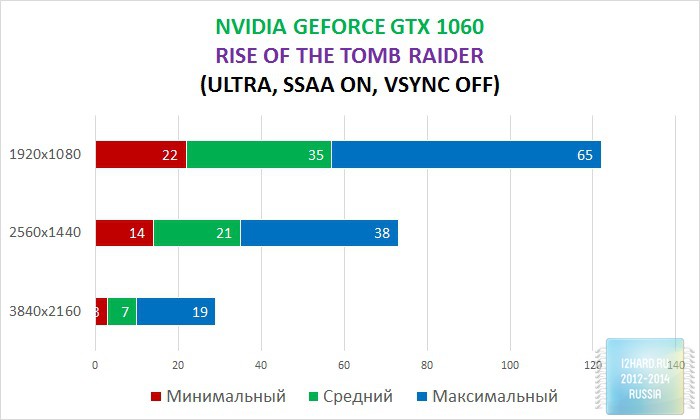

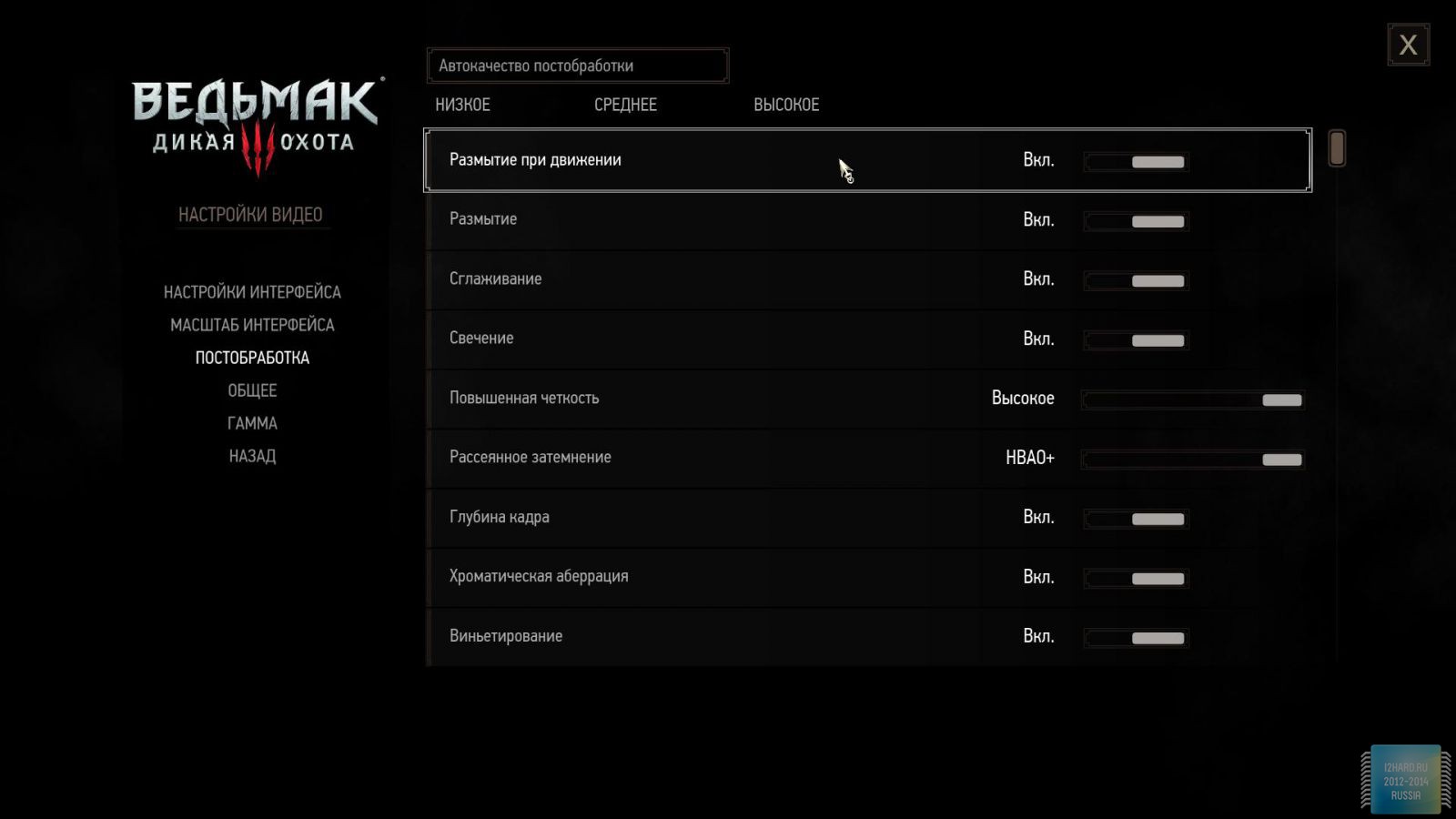
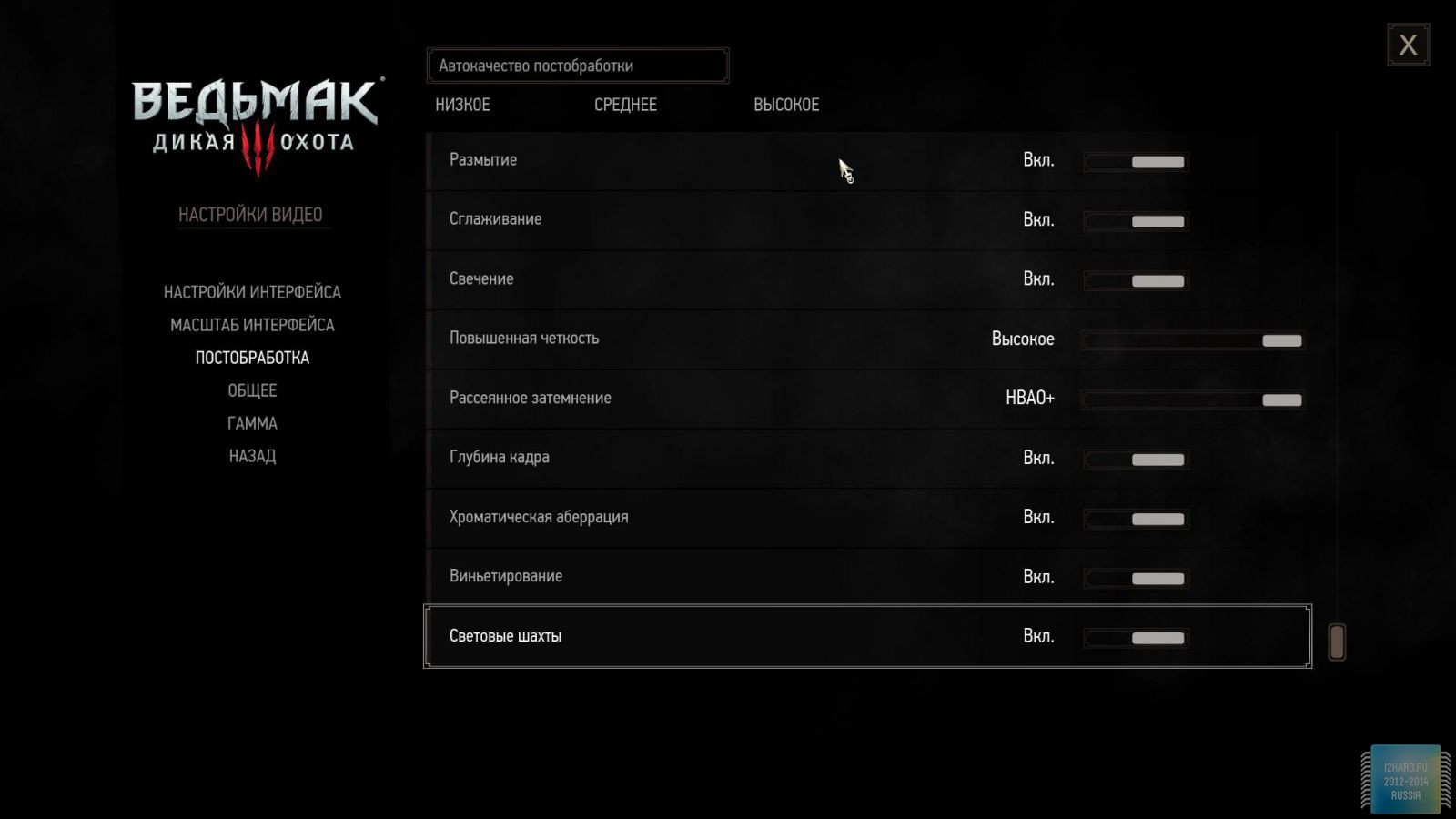

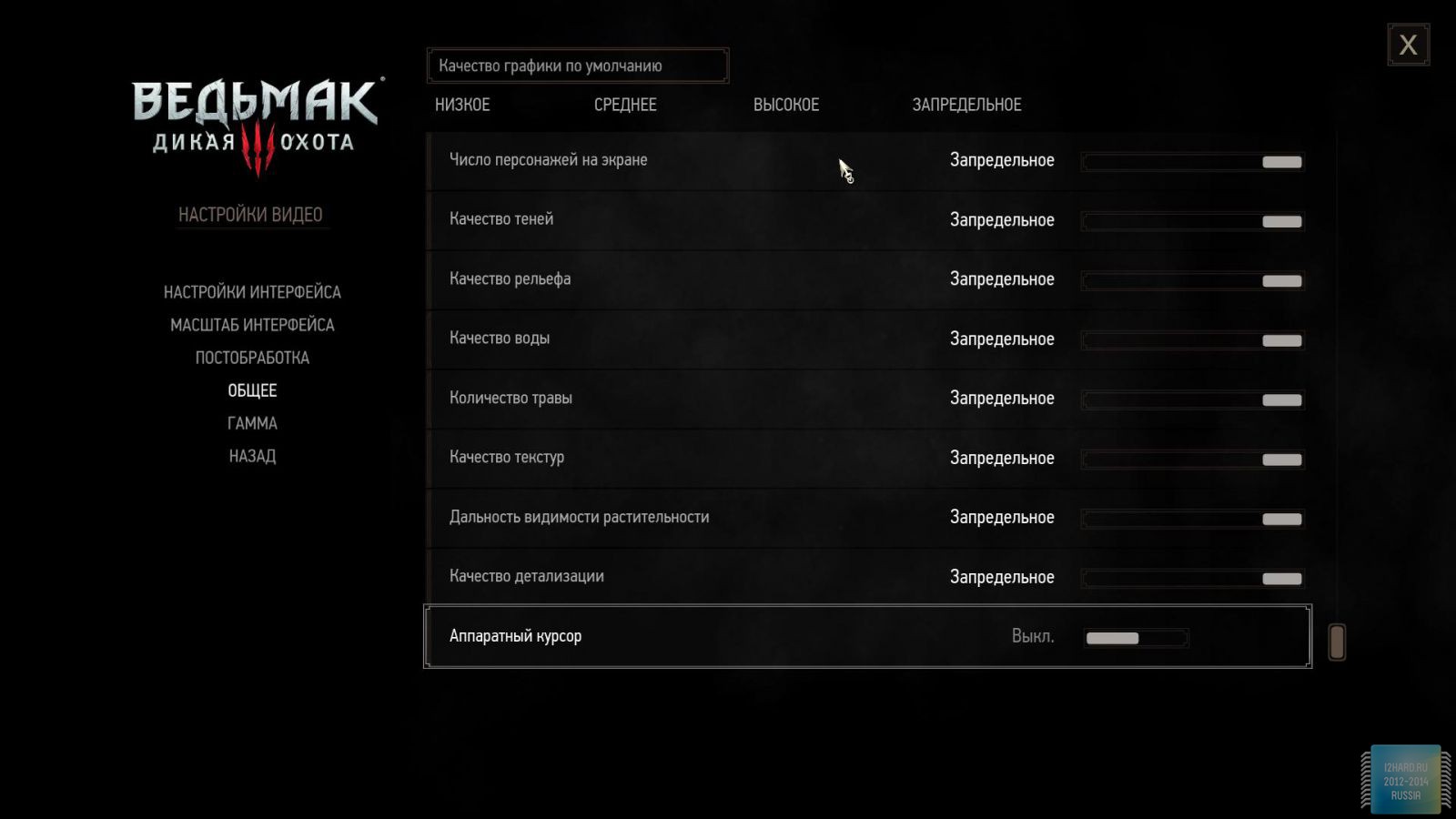


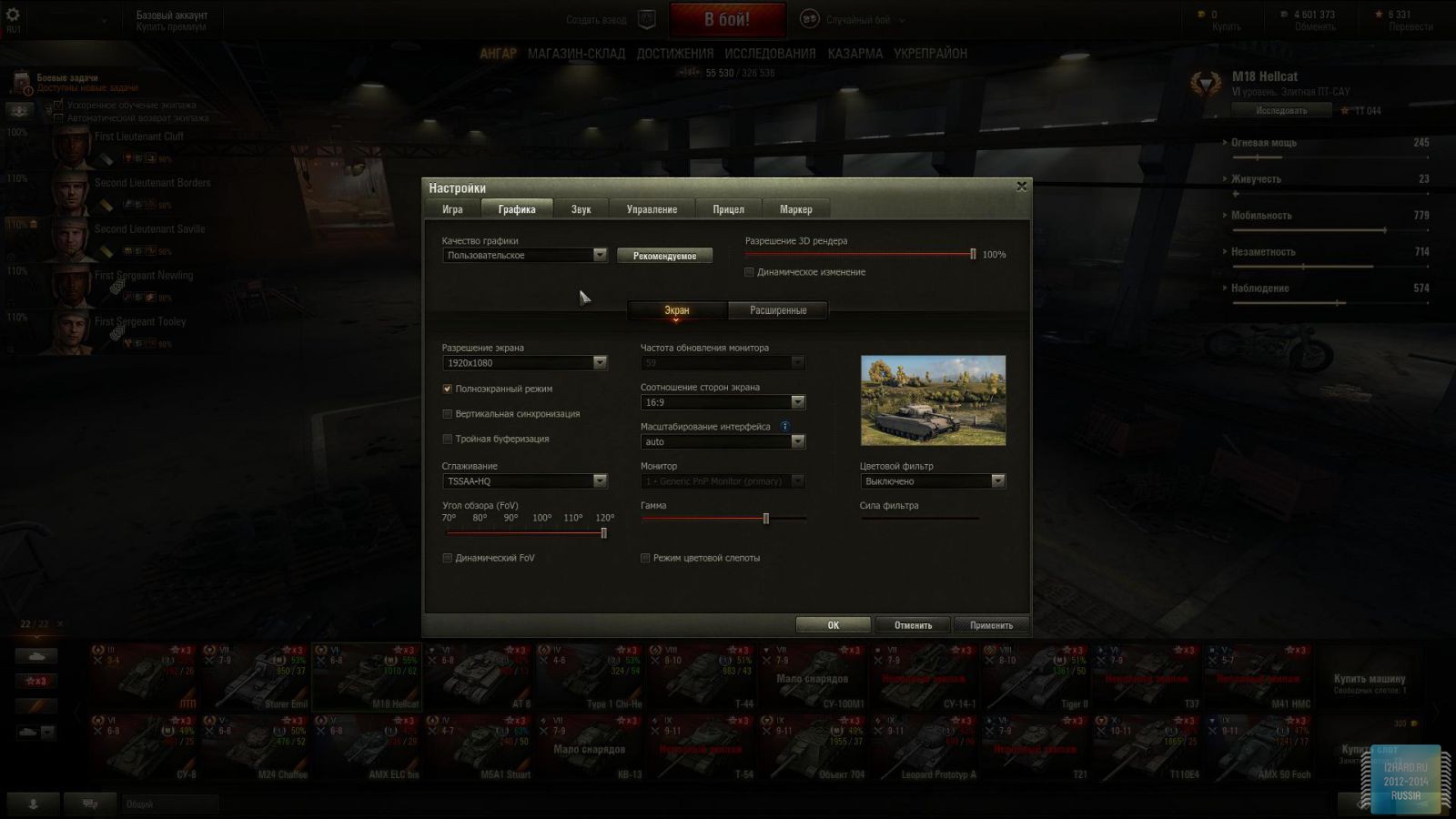
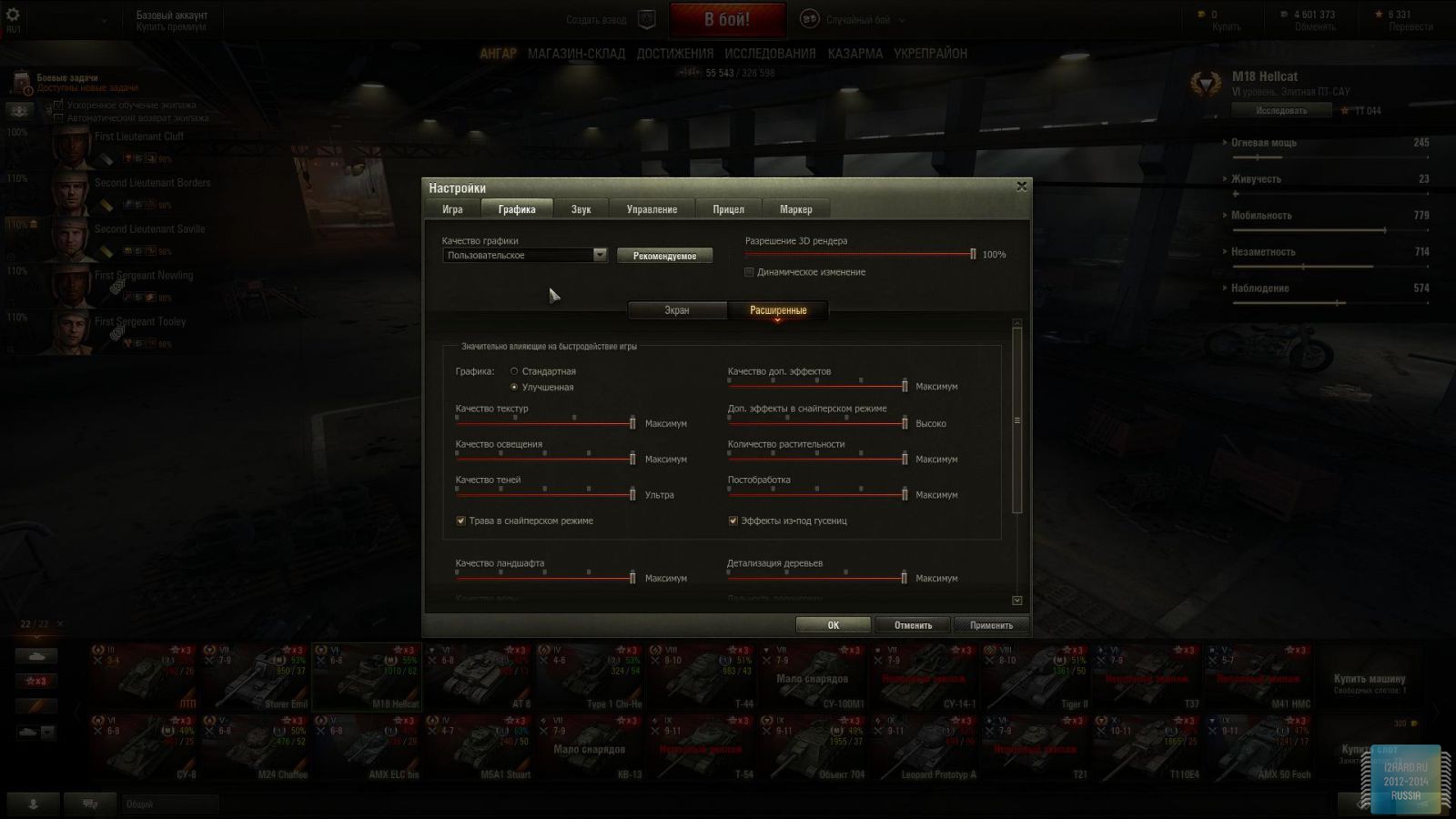


According to the test results, it can be noted that the performance of the GTX 1060 is approximately on par with the GTX 980. This video card It is perfect for playing at a resolution of 1920x1080, even if such a resource-intensive option as anti-aliasing is enabled. The exception in our case is games such as Assassin 's Creed Syndicate and Metro Last Light, it is recommended to disable this option. If you pay attention to a higher resolution of 2560x1440, then you can count on a decent level of performance, but only when disabling and such parameters as shadows, volumetric lighting, range of drawing objects.For the new-fashioned 4K video card is completely unsuitable and to a large extent this is due to the lack of SLI support.
Temperature and acceleration
Testing took place in an open case at room temperature of 25 degrees. In idle mode, the frequency of the GPU and memory is reduced to 139/405 MHz, which directly affects energy efficiency and improves temperature indicators. In the rest mode, the temperature dropped to 32 ° C, and under load it did not exceed 72 ° C. As for the noise level, at low loads the video card works quite quietly and it is unlikely that someone will be unhappy with this parameter. Under load, noise also does not leave the comfort zone. In general, due to the reduction of power consumption and, as a result, reduction of heating, the reference cooling system quite confidently copes with heat removal.
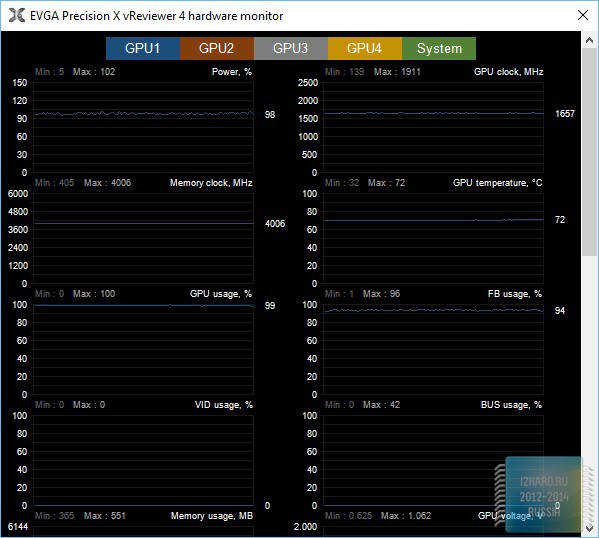
Overclocking was carried out using the latest version of the EVGA PrecisionX 16 utility.
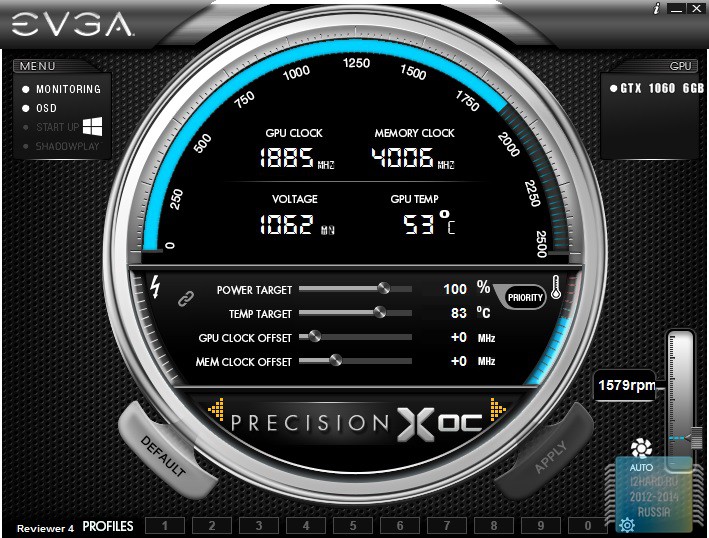
In addition to the standard menu with changing the parameters of frequency and voltage in this utility, three more modes are available:
- Basic - we select a point on the graph with a certain voltage value and indicate the required frequency level, in this case there is a linear construction of this dependence.
- Linear - we build on two points, which makes it possible to set the initial and final values, which affects the steepness of the line.
- Manual - manually set each frequency point for the corresponding value of the supply voltage.
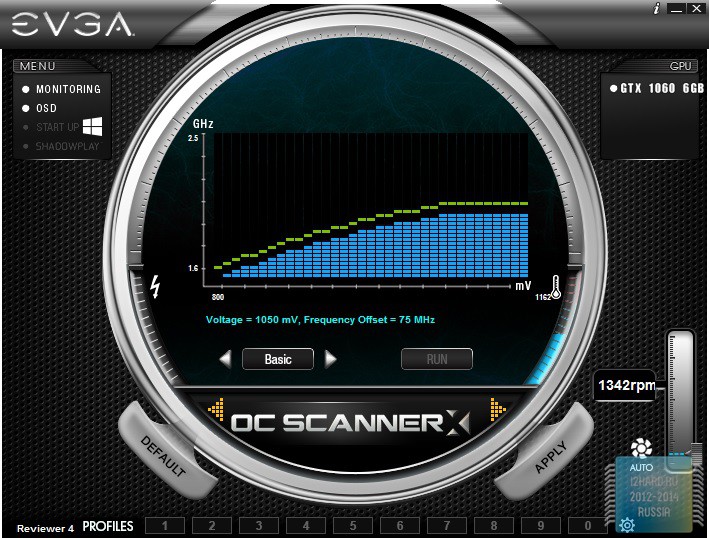
![]()
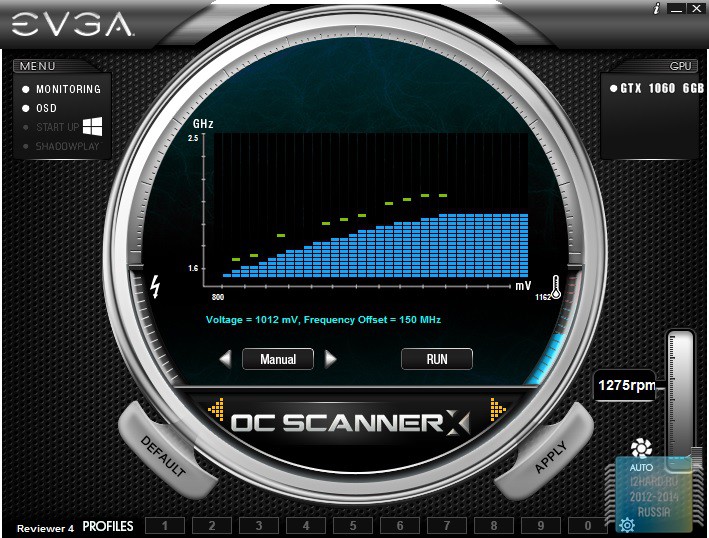
To check the stability set parameters It is recommended to use the built-in OS scanner, due to which the stability of the video card is checked depending on the frequency and the voltage level. As a result, you can save the profile, where all points on the chart will be marked.
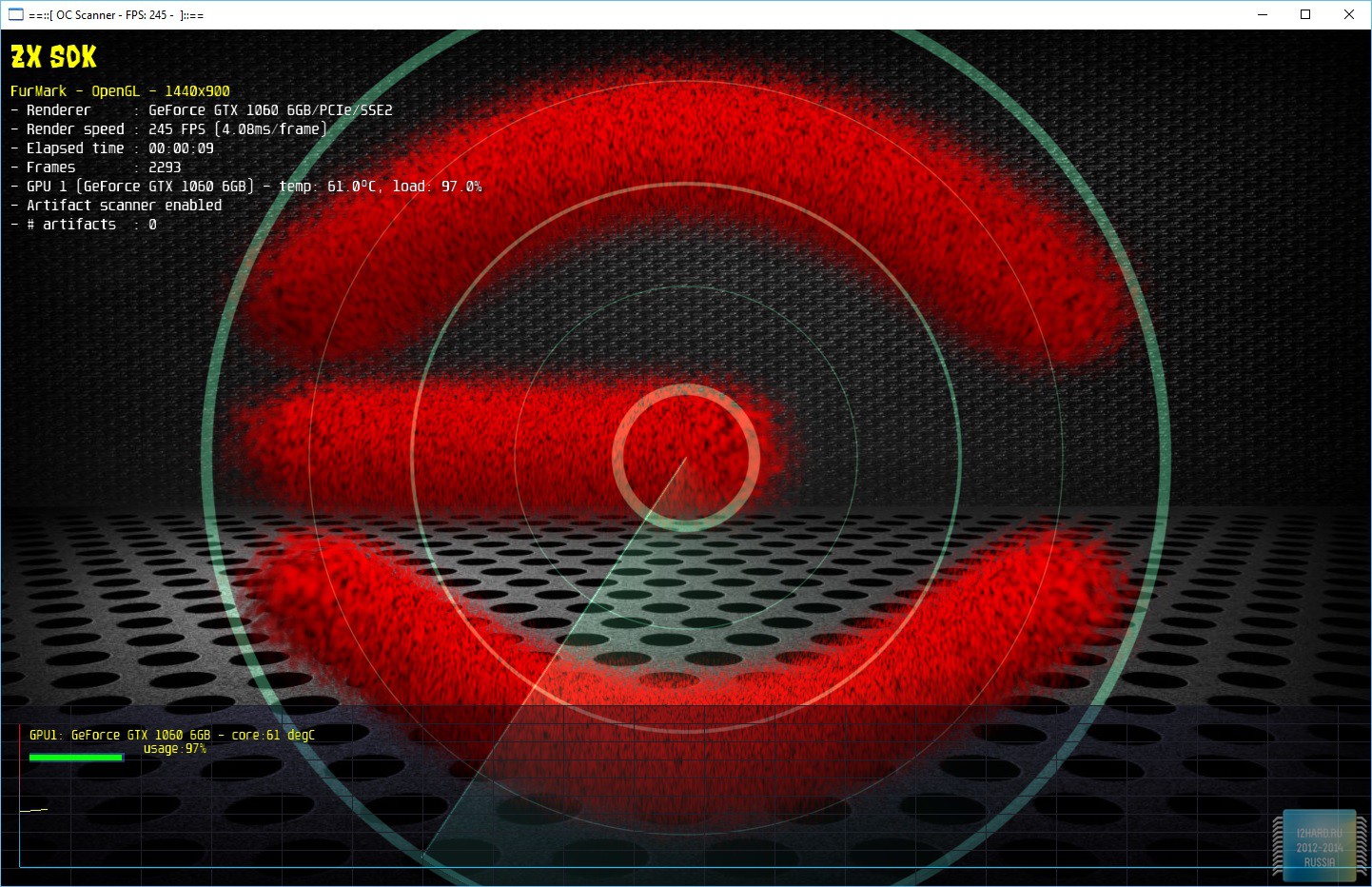
The result of overclocking:
- The frequency of the graphics processor was increased by 200 MHz, which in the final version was 1706 MHz. However, taking into account the GPU Boost, the desired value has grown to 2100 MHz, which guarantees a very significant increase in performance.
- The memory frequency was increased by 750 MHz and reached the value of 2376 MHz (9.5 GHz QDR), an excellent increase was obtained.

I suggest to get acquainted with the increased performance of Fire Strike Extreme and Fire Strike Ultra:
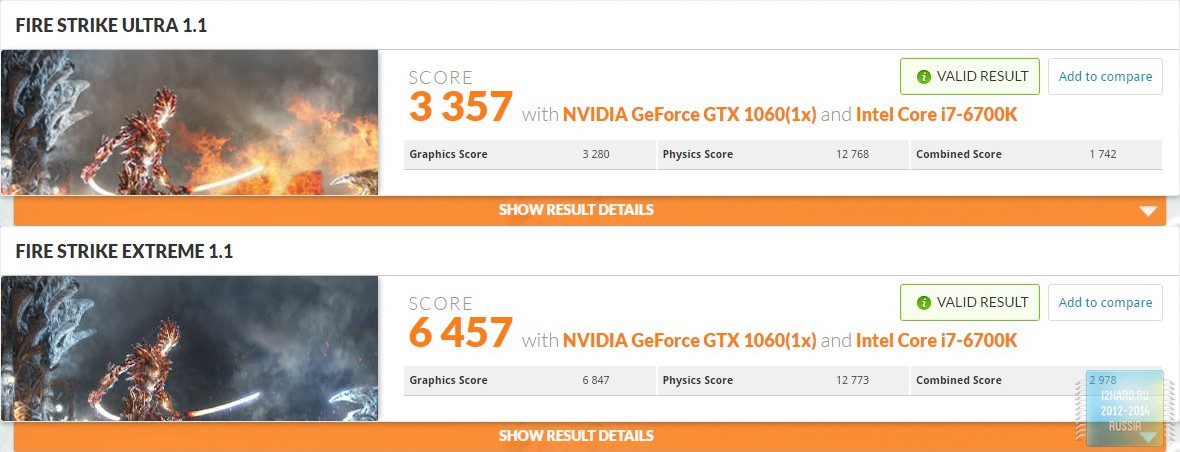
Conclusion
NVIDIA GeForce GTX 1060 is sure to become one of the most demanded models in our market, especially when prices drop as a result of the AMD RX 480 competition. graphic settings. Along with this, it is impossible not to note the low power consumption of the video card, which is able to work in a pair with four hundred watt power supply units. Plus, there is a decrease in heat generation and, as a result, no need to use bulky cooling systems. We were also pleased with the overclocking opportunity, which enthusiasts and advanced users will definitely take advantage of in order to get a solid FPS increase.
Should I buy Founders Edition or wait for the release of alternative versions? According to the author, you should not hurry with the purchase. To begin with, the options from NVIDIA partners will be equipped with a semi-passive cooling system and will work much quieter. Another advantage in the piggy bank of alternatives is factory overclocking, which will have a significant impact on performance. Recall also about all sorts of design delights, such as RGB lights, color design, and more. The final argument for buyers may be the price. It is known for certain that some models will cost less than Founders Edition, which, with all the advantages listed above, makes the purchase of reference not the most profitable option. And if you really sum it up, buying NVIDIA GeForce GTX 1060 on the territory of the Russian Federation will not be easy, as the Founders Edition version is not officially sold here.
Pros:
- Design, appearance;
- Good level performance;
- Excellent overclocking capability;
- Economical consumption;
- Silent in idle and under load;
- Good cooling system performance.
Minuses:
- Lack of SLI support.
![]()
According to the editors, taking into account all the pros and cons, the NVIDIA GeForce GTX 1070 Founders Edition receives the Silver Award.
Season loud announcements. After senior graphic cards family Pascal nVIDIA presents a mid-level model - GeForce GTX 1060. The novelty will be the answer to the recent release of the Radeon RX 480 and will replace a number of mid-high level models from the previous series.
GeForce GTX 1060 video card will get all the advantages of the new Pascal architecture. It is based on the GP106 GPU, which is based on two graphic clusters of five TPC multiprocessors. The architecture of such clusters and multiprocessors is traditionally unified within a single series. More about them in a separate article about the architectural and technological features of Pascal.
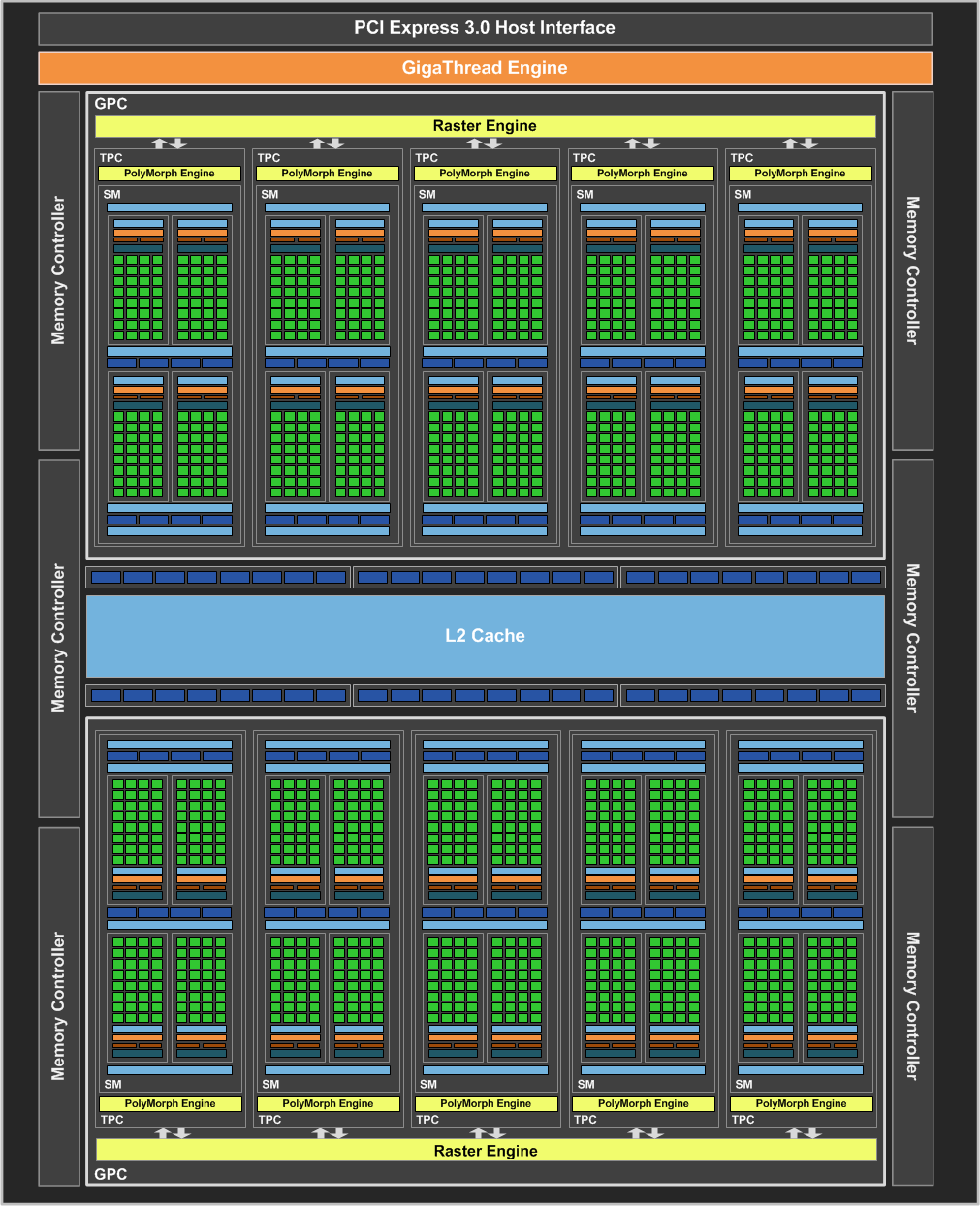
Each multiprocessor has 128 CUDA stream processors and eight texture units. As a result, the GPU has only 1280 stream processors and 80 TMUs. Work with the external memory organized on a 192-bit bus across six 32-bit controllers. Support for advanced color data compression techniques improves information transfer and actual throughput. Improved work with asynchronous computing. A special Simultaneous Multi-Projection block has been added to the Polymorph Engine engines that allows you to simultaneously calculate the geometry for several projections at the hardware level. This allows you to correctly display the image on complex-shaped displays and form a panorama with the correct viewing angle in multi-monitor configurations. In addition, multiprojection is used in a number of nvidia technology VRWorks to optimize and speed up rendering in VR mode.
GeForce GTX 1060 occupies an intermediate position between GeForce GTX 960 and GeForce GTX 970 in its main characteristics. Slightly more computational units in comparison with GeForce GTX 960, L2 cache memory increased from 1 MB to 1.5 MB, memory bus increased from 128 bits up to 192 bits. Thanks to the new 16-nm process technology and optimization of the silicon core structure, the frequencies have seriously increased. Taking into account architectural improvements and a significant increase in frequencies from the new product, one would expect it to replace the GeForce GTX 970, but the manufacturer promises a GeForce GTX 980 performance level in the GeForce GTX 1060, which is impressive.
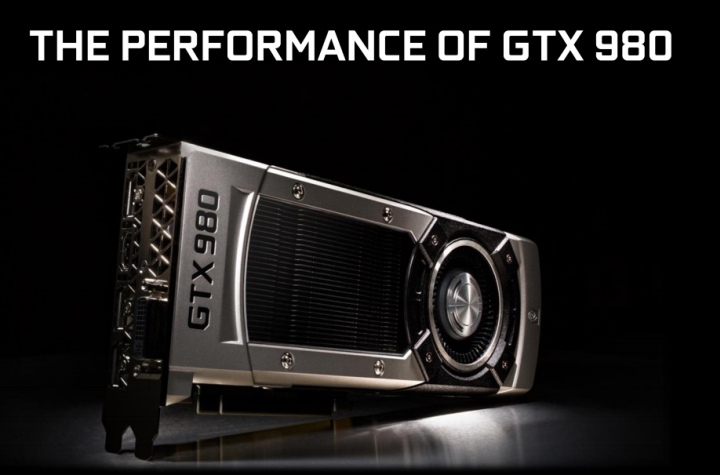
The base frequency of the GPU GP106 is set at 1506 MHz, and the average Boost Clock is 1708 MHz. This is close to the core frequency level of the GeForce GTX 1070, and Boost is even slightly higher. GDDR5 memory chips with a total capacity of 6 GB are used. Their effective data exchange rate is 8 GHz. The TDP level at a modest level of 120 W, which is similar to the TDP of the GeForce GTX 960.
For a visual comparison of the GeForce GTX 1060 with previous models and the GeForce GTX 1070, we summarize their characteristics in one table.
| Video adapter | GeForce GTX 1070 | GeForce GTX 980 | GeForce GTX 970 | GeForce GTX 960 | |
|---|---|---|---|---|---|
| Core | GP104 | GP106 | GM204 | GM204 | GM206 |
| 7200 | 4400 | 5200 | 5200 | 2940 | |
| Process technology, nm | 16 | 16 | 28 | 28 | 28 |
| Core area, square mm | 314 | n / a | 398 | 398 | 228 |
| 1920 | 1280 | 2048 | 1664 | 1024 | |
| The number of texture units | 120 | 80 | 128 | 104 | 64 |
| Number of rendering blocks | 64 | 48 | 64 | 56 | 32 |
| Core frequency, MHz | 1506-1683 | 1506-1708 | 1126-1216 | 1051-1178 | 1126-1178 |
| Memory bus, bit | 256 | 192 | 256 | 256 | 128 |
| Memory type | GDDR5 | GDDR5 | GDDR5 | GDDR5 | GDDR5 |
| Memory frequency, MHz | 8000 | 8000 | 7010 | 7010 | 7010 |
| Memory capacity, MB | 8192 | 6144 | 4096 | 3584+512 | 2048 |
| 12.1 | 12 | 12 | 12 | 12 | |
| Interface | PCI-E 3.0 | PCI-E 3.0 | PCI-E 3.0 | PCI-E 3.0 | PCI-E 3.0 |
| Power, W | 150 | 120 | 165 | 145 | 120 |
At the time of the announcement of the GeForce GTX 1080, we wrote about the new Ansel software technology. Now she has acquired the status of the finished product. This is a platform for taking screenshots with a free camera and the possibility of imposing additional visual effects. While it works only in Mirror’s Edge: Catalyst, Ansel will soon receive The Witcher 3: Wild Hunt and other games.

Test Ansel will be able to buyers GeForce GTX 1060 and the owners of other current NVIDIA graphics cards with the release of the next official driver package.
The first GeForce GTX 1060 on the market will correspond to the reference design. These models will be called Founders Edition and will be offered at a higher price. Later come non-standard versions, in which the official price tag may be lower by $ 50.
GeForce GTX 1060 Founders Edition looks like the older models, but a bit more compact and slightly easier. Instead of a transparent window on the cooling system is a stub.

Turbine-type cooling inherits the design of top-end cards. There is a massive base and two radiators - one on the GP106 chip and an additional radiator to improve the cooling of the VRM.
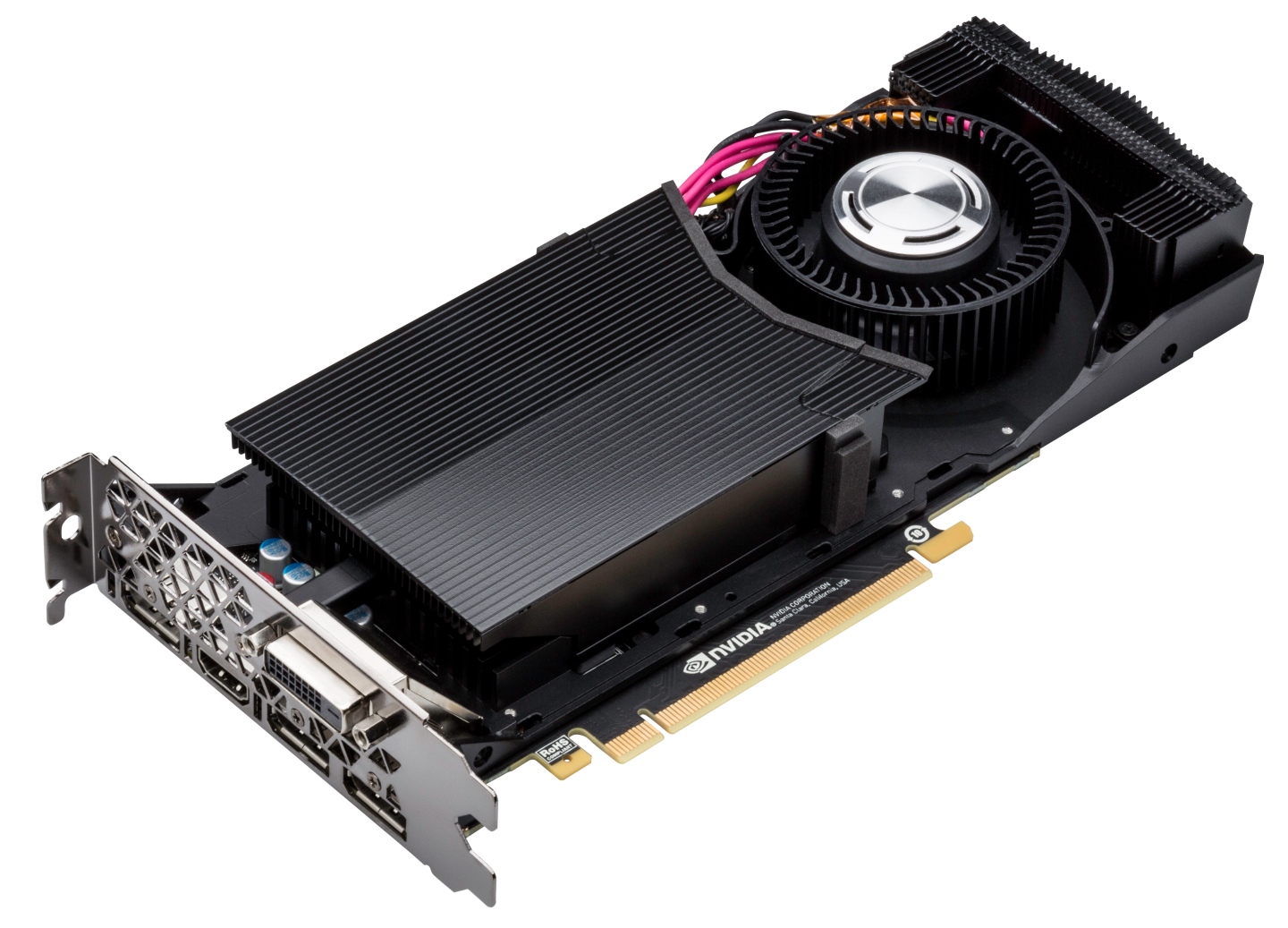
The board is as compact as it once was at the GeForce GTX 760 or GeForce GTX 660. The power supply of the core is three-phase.
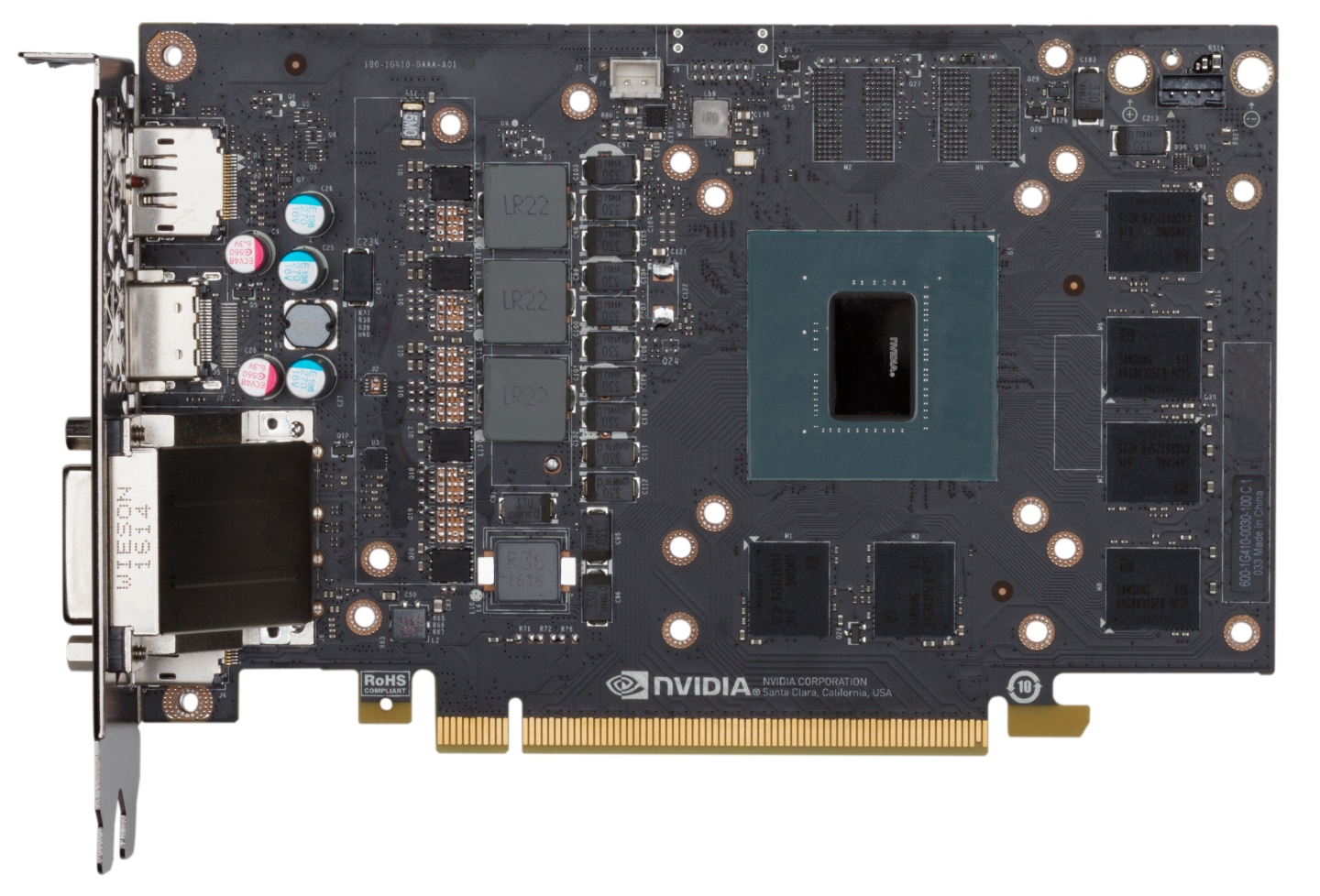
Our practical acquaintance will immediately begin with a non-reference version. We will introduce the new video card using the example of MSI GeForce GTX 1060 Gaming X 6G, which will be tested at factory frequencies, at the recommended frequencies (reference level) and overclocked.
The card comes in a box of medium size. Red color dominates in the design of the card and the card itself, which is unusual for NVIDIA products, but has already become a hallmark of MSI Gaming.
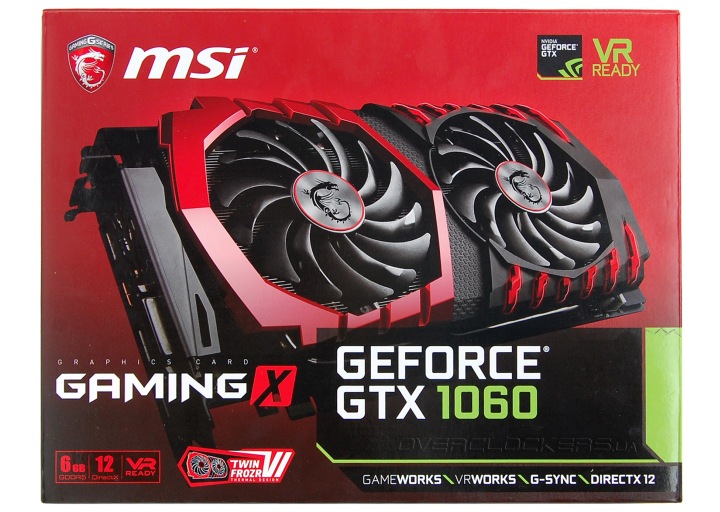
Externally, this model does not differ from the more powerful solutions of this series, for example, MSI GeForce GTX 1070 Gaming X 8G. That is, for all the initial simplicity of the board and the low TDP, MSI did not make any serious simplifications by releasing a version that is not technically inferior to the top solutions.
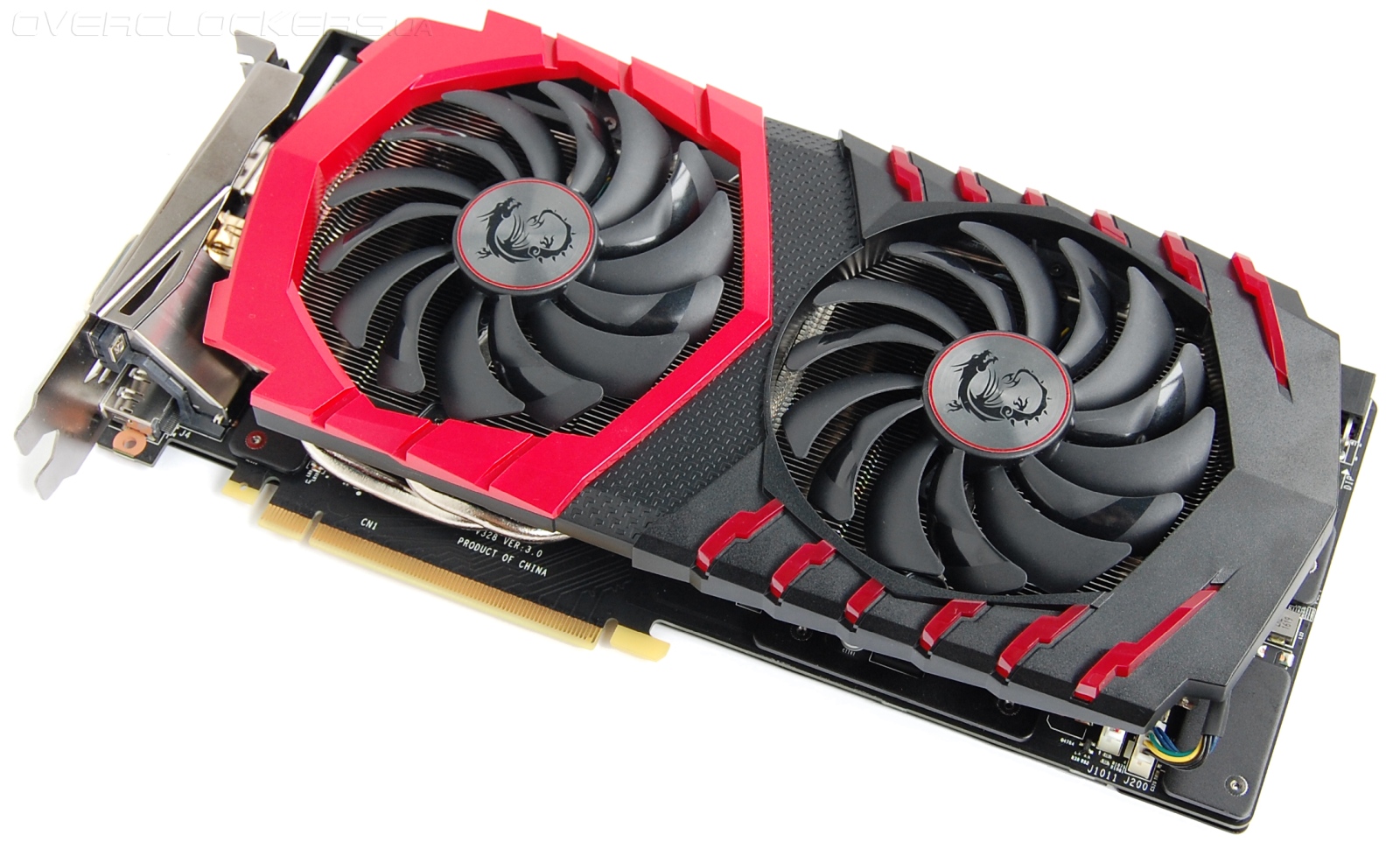
The new Gaming series video cards have an aggressive design with red teeth and an intricate casing shape. Spectacular appearance is complemented by no less spectacular large-sized fans. The total length of the card is almost 28 cm.
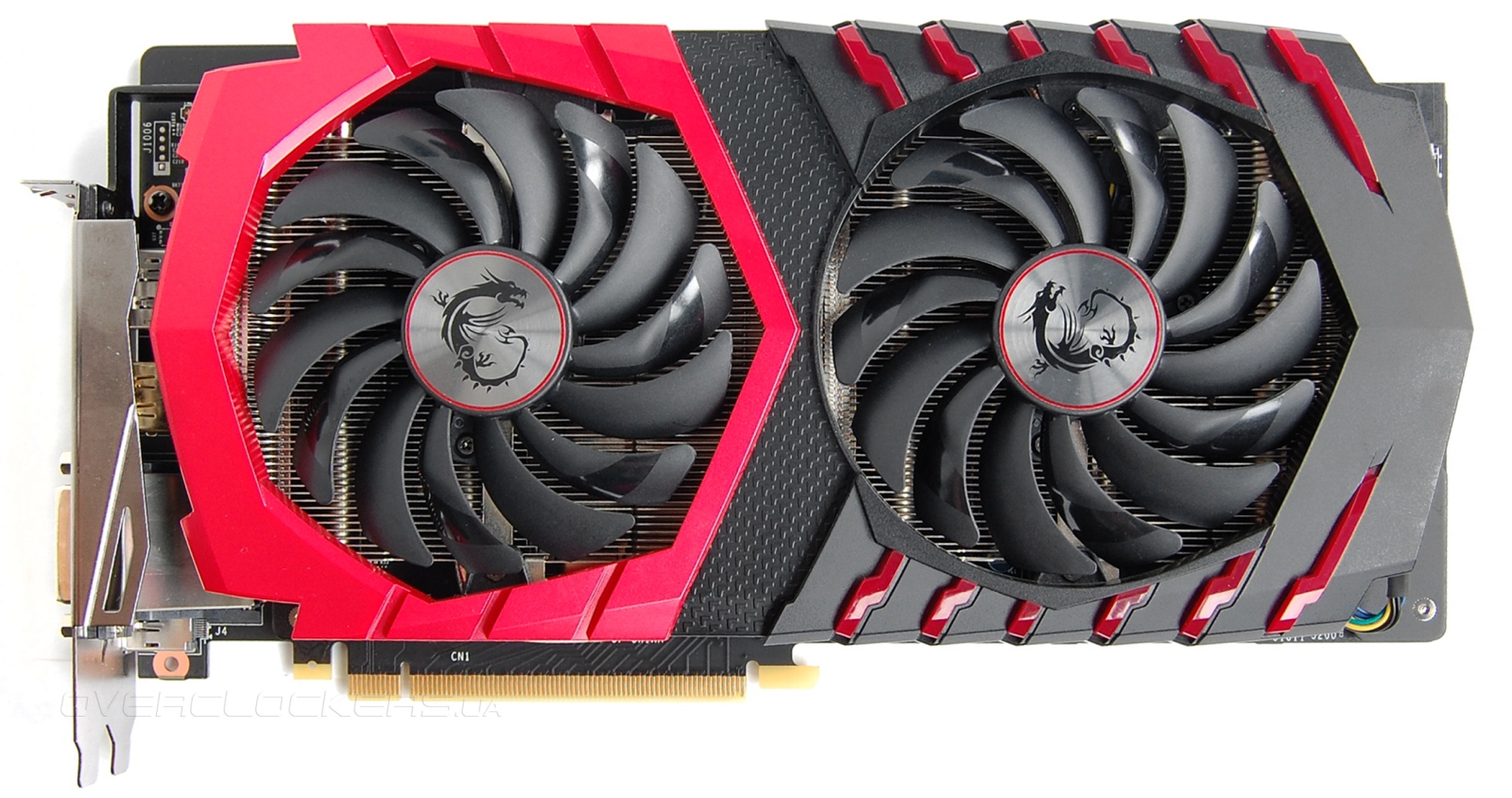
The back side of the board is protected by a metal plate with a dragon logo. Partially present decorative perforation to improve the convection of hot air. In the corner there is one power connector for eight pins.
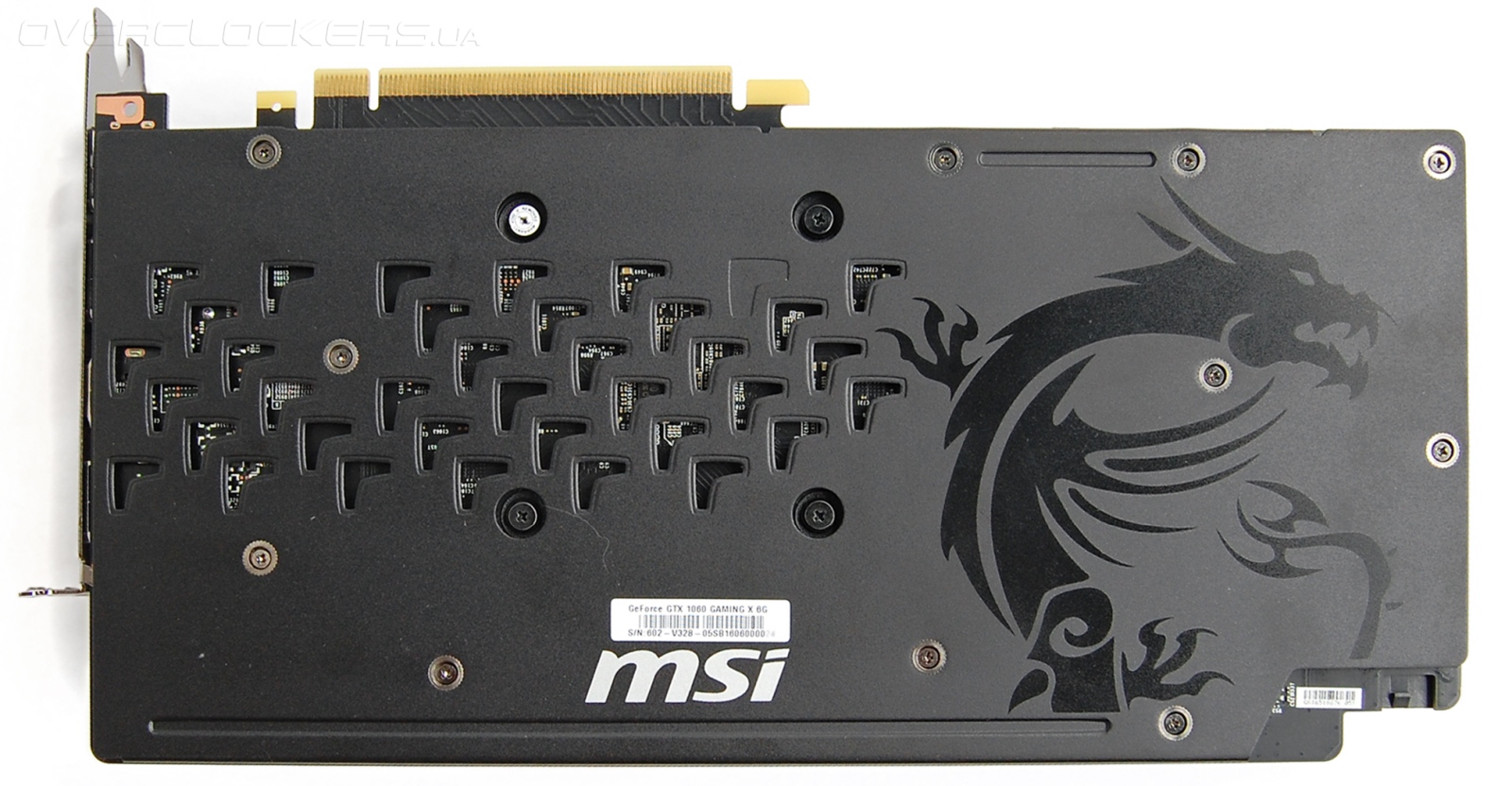
In the side there is a highlighted logo. Highlighting also have red teeth. The intensity and color can be changed and adjusted through software Msi.

The rear panel displays three DisplayPort connectors, one HDMI and DVI.
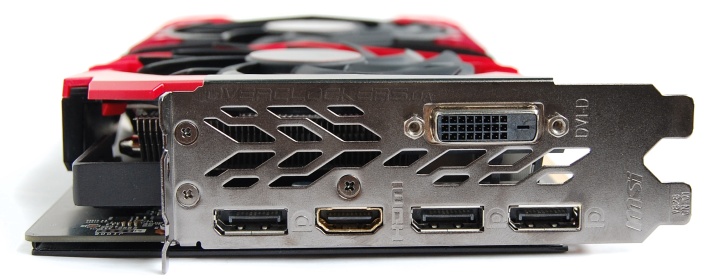
In the design of the cooling system, there is noticeable continuity with the older models of MSI Gaming. The same large radiator, but less heat pipes. Contact with the surface of the graphic crystal is carried out through a massive base.
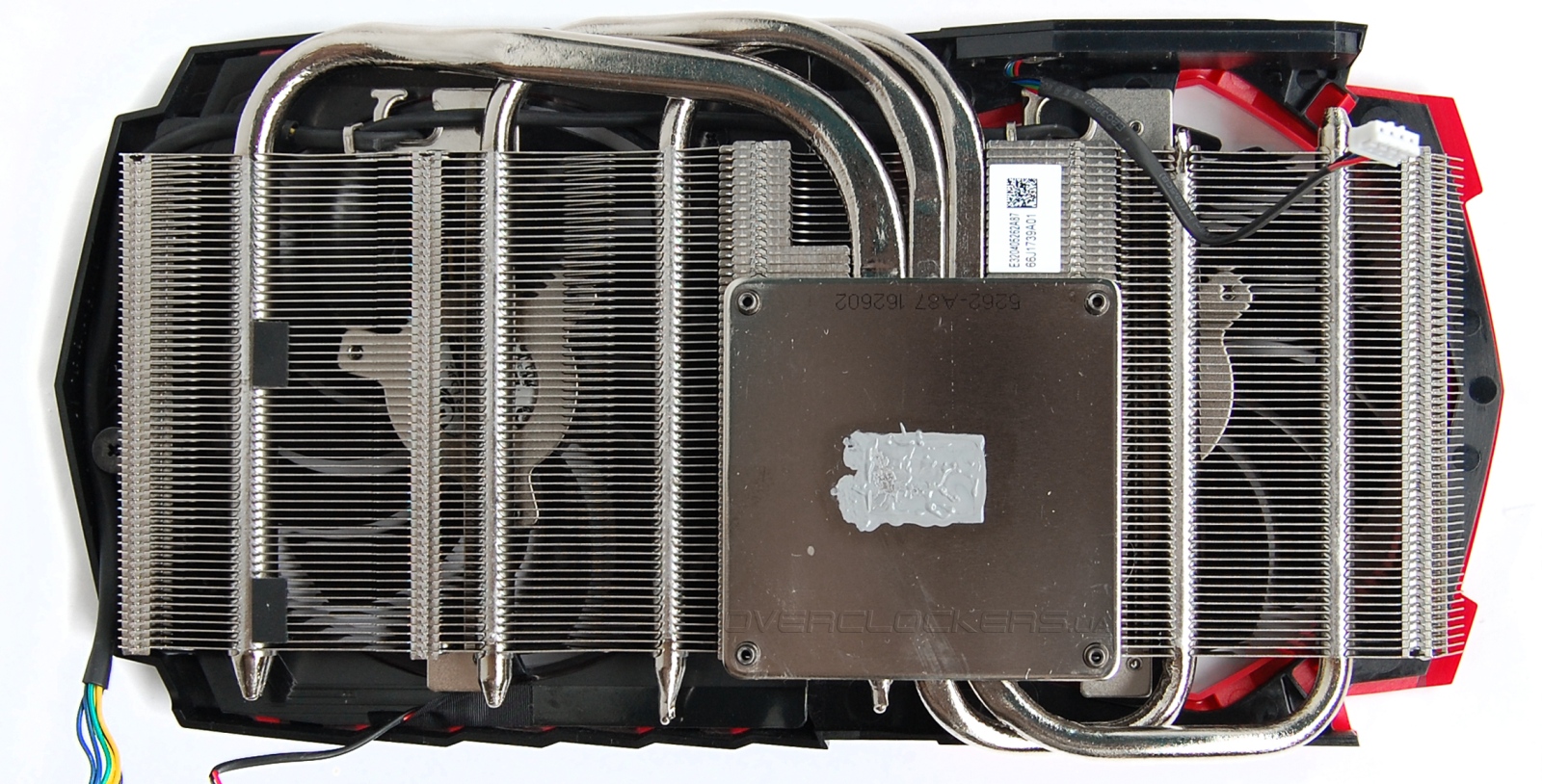
Two tubes of the usual diameter of 6 mm, one thicker and massive. They bend and penetrate an array of plates twice, ensuring efficient heat distribution.
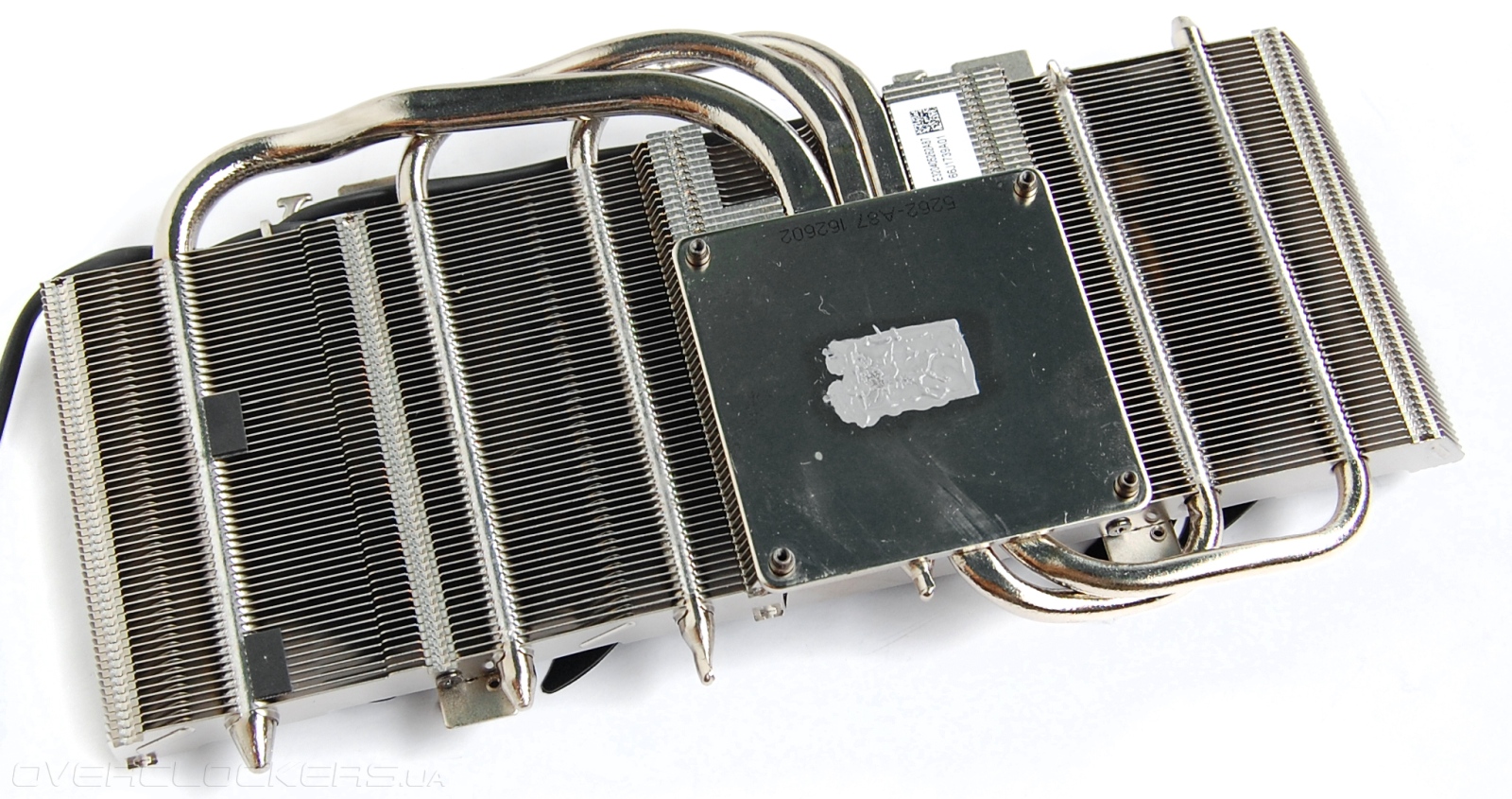
From the front side, two 100 mm-sized fans are screwed onto the radiator. The special shape of the impeller in accordance with Torx 2.0 technology provides a more powerful airflow and better dispersion for complete blowout of the entire radiator.
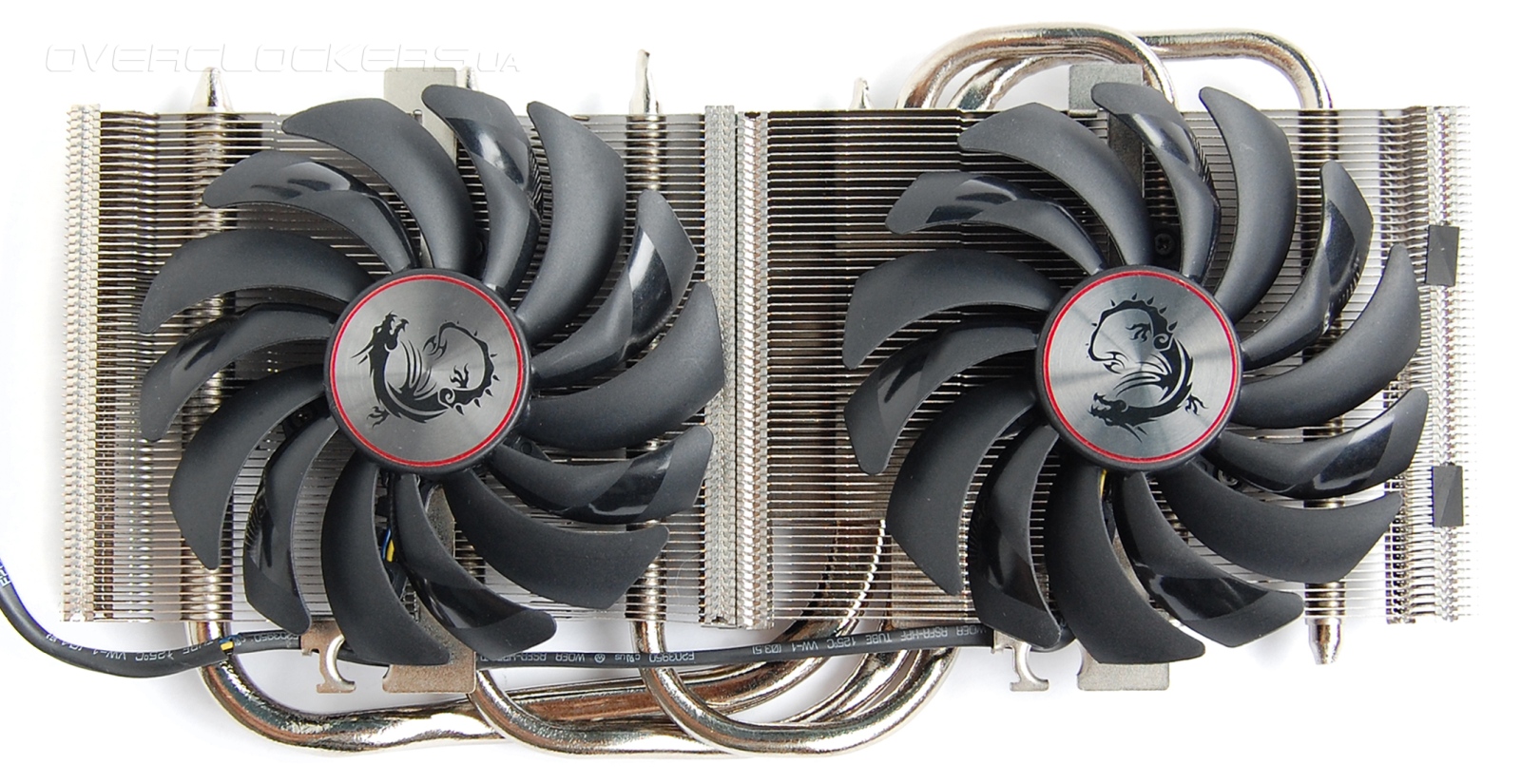
Important elements on the board are covered with a plate, which acts as a radiator and an additional element, which gives rigidity to the structure.
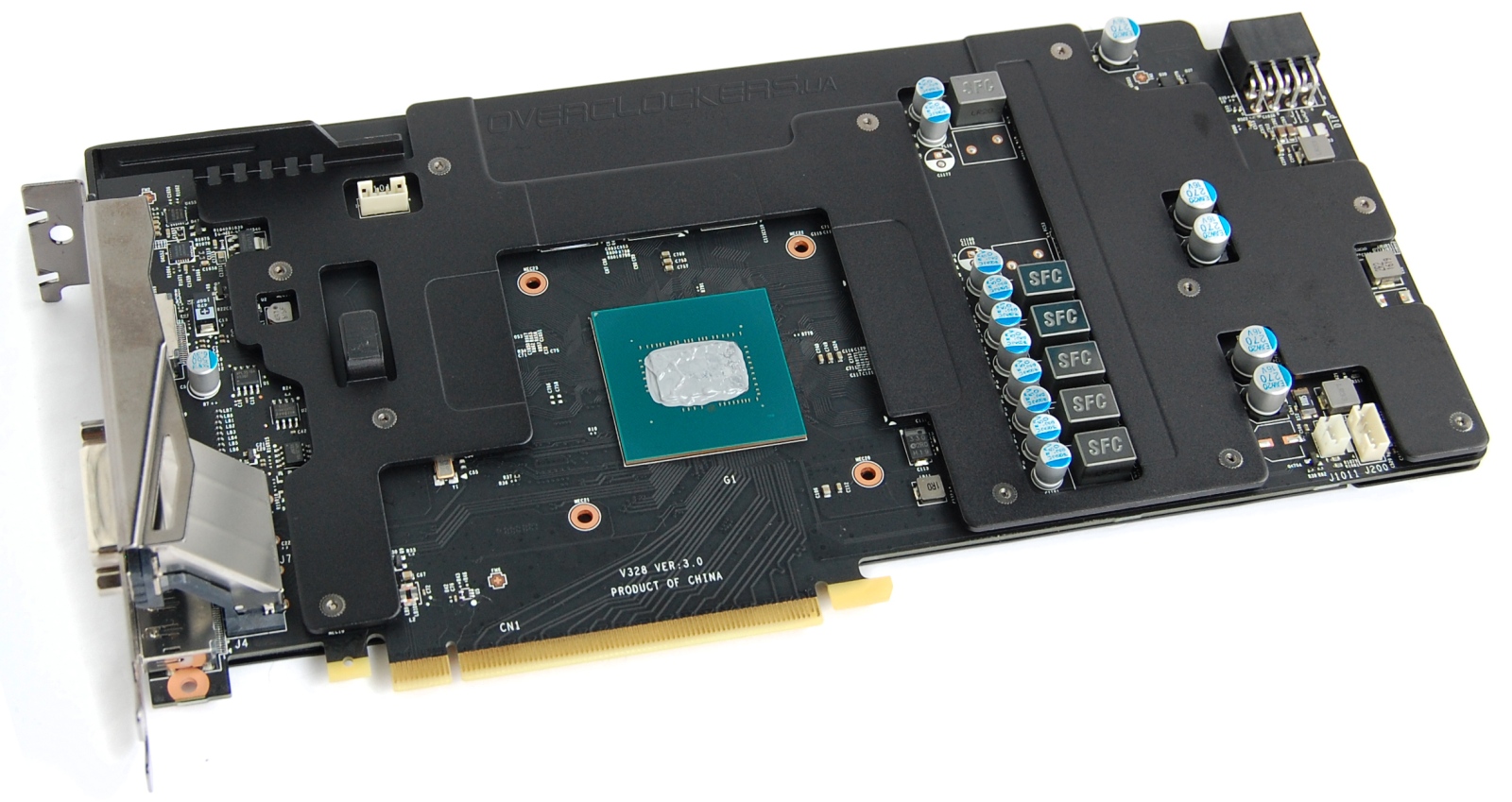
Now let's look at the board itself. It is very large and does not resemble the standard "stub" at all.
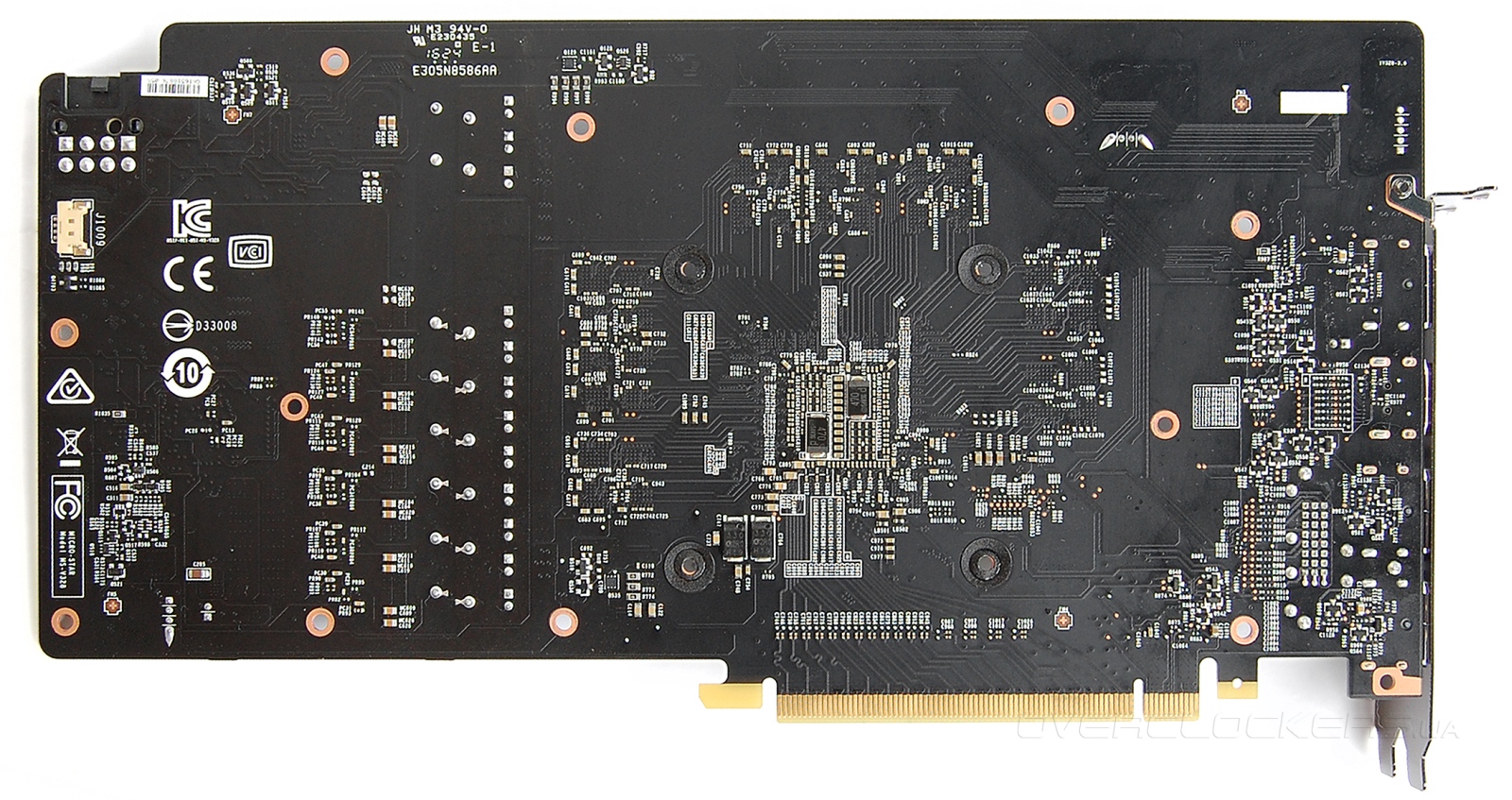
The power supply system has increased the number of phases, although there are unsoldered places, perhaps for some top-end modification.
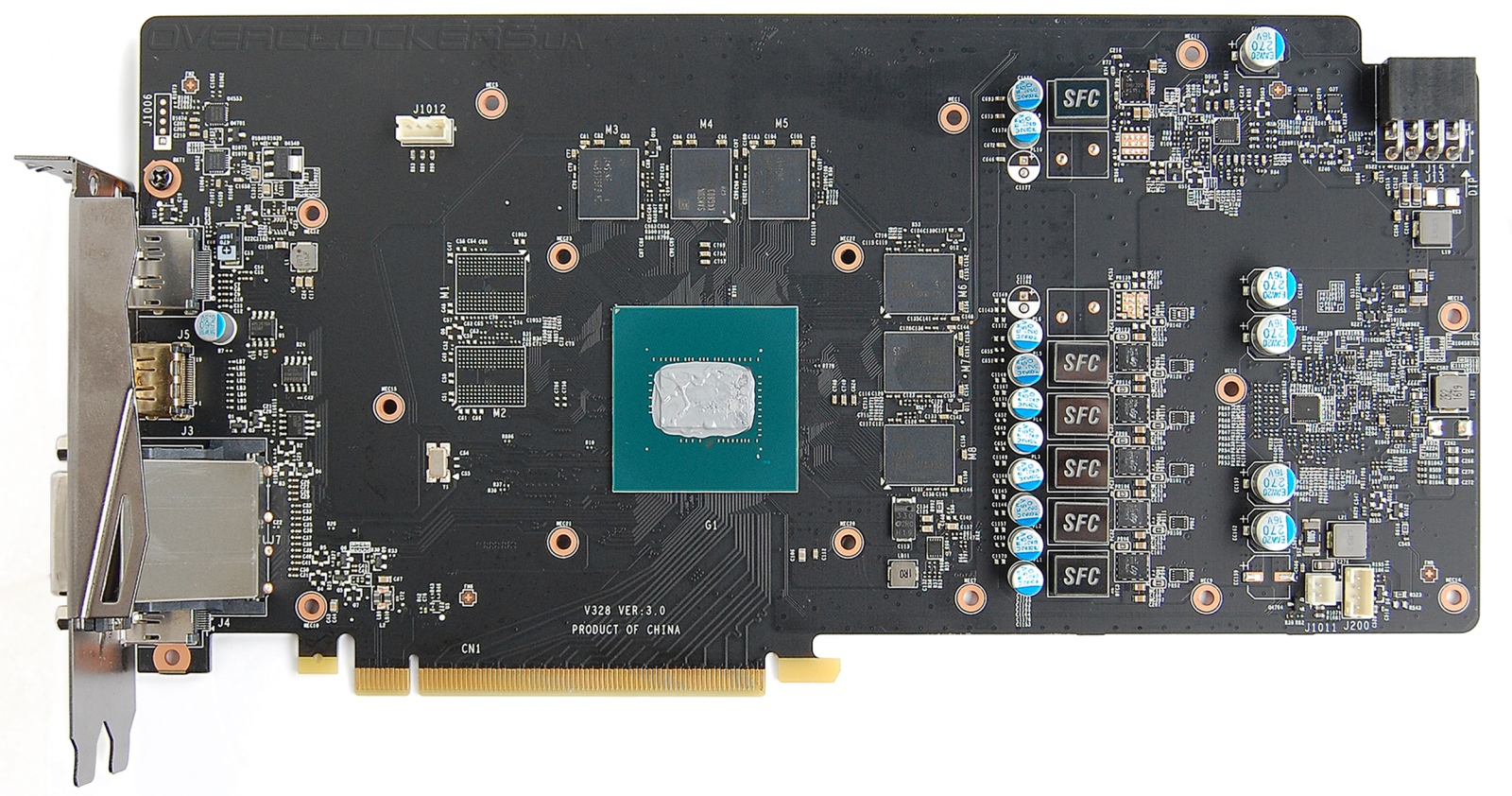
The GPU power subsystem has five phases, GDDR5 memory is powered from one phase.

Full marking of the GP106-400-A1 processor.

Wired six memory chips Samsung K4G80325FB-HC25.
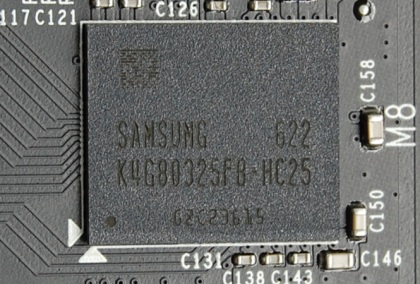
Our default instance worked at the base clock frequency of 1595 MHz and Boost Clock 1810 MHz. The effective memory frequency is 8100 MHz.

This frequency configuration corresponds to the profile settings OC Mode. Retail versions can work by default with the Gaming Mode profile, which provides for frequencies of 1570/1785 MHz for the core and 8014 MHz for the memory. Switching between these modes is carried out through the Gaming App, which at the same time allows you to adjust many other parameters, including setting up the backlight.

In addition to the mentioned modes, Silent Mode is also provided with frequencies of 1507/1722 MHz for the core and 8014 MHz for the memory. This configuration is almost identical to the recommended reference version frequencies.
Video cards were operated on an open stand at 28 ° C. Not the most favorable ambient temperature, but MSI performance is great even in such conditions. When tested in Tom Clancy "s The Division, the core was heated to 65-66 ° C at a fan speed of 1000 rpm. Long-term load with the benchmark Metro: Last Light warmed the core a degree higher at a fan speed of not more than 1100 rpm.
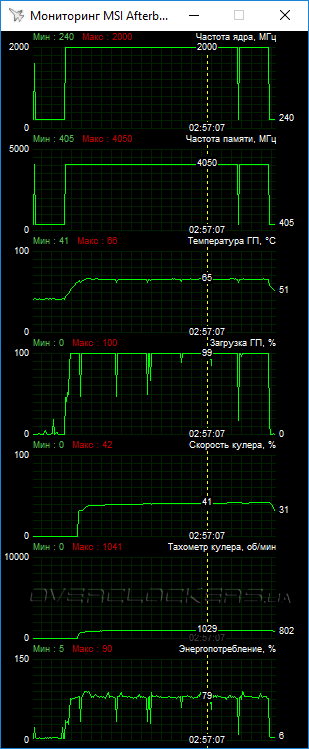

At the base frequency of 1595 MHz, the real Boost turned out to be at the level of 2000 MHz, and this frequency was stably maintained in all gaming tests. That is, MSI Gaming initially expanded the power limit, which allows not to exceed these limitations. And the temperature limit of 83 ° C with such effective cooling is simply unattainable. The final noise is minimal.
The increased characteristics of the video card are good for the buyer, but for an objective picture we still need to test the GeForce GTX 1060 at recommended frequencies or close to this level. In the usual Silent mode, the Boost frequency steadily kept at around 1911 MHz. By the way, switching to such a profile of settings minimally affected the change in the final temperatures and fan speeds, which were initially very low.
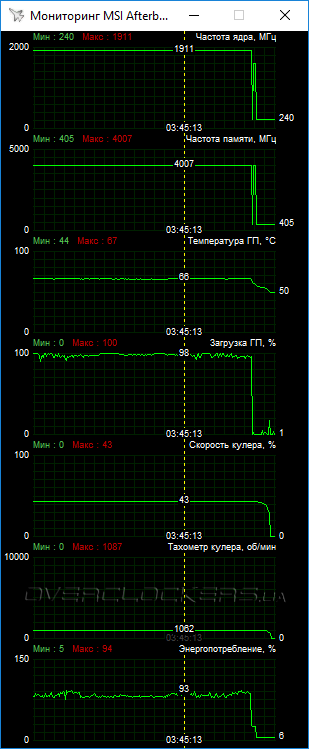
Taking into account the higher value of the average Boost Clock, we decided to additionally lower the core frequency so that we limit ourselves to the maximum Boost within 1860 MHz. Monitoring parameters in this mode when testing in Metro: Last Light is shown in the screenshot below.
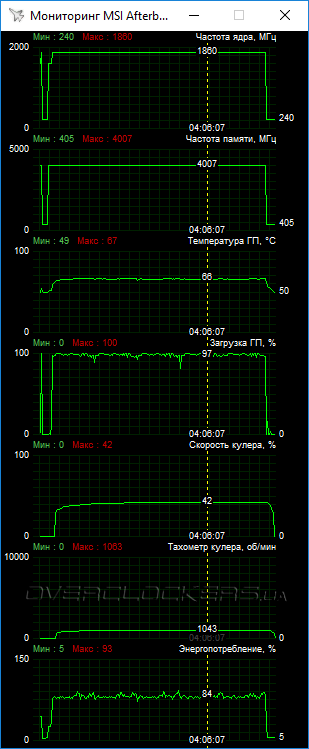
What is the overclocking potential of a video card? At first, we settled on a configuration of frequencies that provided a stable peak boost at the level of 2,126 MHz. The video card successfully passed many difficult tests at such a frequency, but in some places it failed. As a result, I had to stop at the basic value of 1705 MHz with Boost 2101 MHz. This is slightly higher than the frequencies that we received on the GeForce GTX 1070/1080. Well, it should be noted separately that this is not a floating frequency, but an absolutely stable value.

The final frequency looks impressive, but with respect to the same 1860 MHz, this is an increase of 13%. If we take the starting frequencies as a reference point, then the increase is only 5%. But the memory was struck by the fact that it was able to work at 9548 MHz, which is 19% higher than the recommended level!

To maintain overclocking performance, we fixed the fan speed at 1300 rpm. As a result, it was still quiet, and the heating was at the initial level.
Additionally, it should be noted that the power limit can be raised only by 8%. If the reference versions have the same small power margin, this can affect, if not the maximum level of Boost frequencies, then their stability in overclocking. Softvoltmod is not supported, but it is often of no use on older cards.
Characteristics of the tested video cards
The reviewed video card will be compared with the Radeon RX 480 and GeForce GTX 970 from recent testing. At the same time, top-level models from GeForce GTX 1080 Founders Edition and MSI GeForce GTX 1080 Gaming X 8G reviews will be added to the comparison.
| Video adapter | GeForce GTX 1070 | GeForce GTX 980 Ti | MSI GTX 1060 Gaming X | GeForce GTX 970 | Radeon R9 Fury X | Radeon RX 480 | Radeon R9 290 | |
|---|---|---|---|---|---|---|---|---|
| Core | GP104 | GM200 | GP106 | GP106 | GM204 | Fiji | Polaris 10 | Hawaii |
| The number of transistors, mln. Pcs | 7200 | 8000 | 4400 | 4400 | 5200 | 8900 | n / a | 6020 |
| Process technology, nm | 16 | 28 | 16 | 16 | 28 | 28 | 14 | 28 |
| Core area, square mm | 314 | 601 | n / a | n / a | 398 | 596 | 232 | 438 |
| Number of stream processors | 1920 | 2816 | 1280 | 1280 | 2048 | 4096 | 2304 | 2560 |
| The number of texture units | 120 | 176 | 80 | 80 | 128 | 256 | 144 | 160 |
| Number of rendering blocks | 64 | 96 | 48 | 48 | 64 | 64 | 32 | 64 |
| Core frequency, MHz | 1506-1683 | 1024-1100 | 1595-1810 | 1506-1708 | 1126-1216 | Up to 1050 | 1120-1266 | Up to 947 |
| Memory bus, bit | 256 | 386 | 192 | 192 | 256 | 4096 | 256 | 512 |
| Memory type | GDDR5 | GDDR5 | GDDR5 | GDDR5 | GDDR5 | Hbm | GDDR5 | GDDR5 |
| Memory frequency, MHz | 8000 | 7010 | 8100 | 8014 | 7010 | 1000 | 8000 | 5000 |
| Memory capacity, MB | 8192 | 6144 | 6144 | 6144 | 4096 | 4096 | 8192 | 4096 |
| DirectX supported version | 12.1 | 12.1 | 12 | 12 | 12.1 | 12 | 12 | 12 |
| Interface | PCI-E 3.0 | PCI-E 3.0 | PCI-E 3.0 | PCI-E 3.0 | PCI-E 3.0 | PCI-E 3.0 | PCI-E 3.0 | PCI-E 3.0 |
| Power, W | 150 | 250 | 120 | 120 | 165 | 275 | 150 | 275 |
Test stand
The test bench configuration is as follows:
- processor: Intel Core i7-6950X (3.0 @ 4.1 GHz);
- cooler: Noctua NH-D15 (two fans NF-A15 PWM, 140 mm, 1300 rpm);
- motherboard: Gigabyte GA-X99P-SLI;
- memory: G.Skill F4-3200C14Q-32GTZ (4x8 GB, DDR4-3200, CL14-14-14-35);
- system disk: Intel SSD 520 Series 240GB (240 GB, SATA 6Gb / s);
- additional drive: Hitachi HDS721010CLA332 (1 TB, SATA 3Gb / s, 7200 rpm);
- power supply: Seasonic SS-750KM (750 W);
- monitor: ASUS PB278Q (2560x1440, 27 ″);
- operating system: Windows 10 Pro x64;
- geForce GTX 1060 driver: NVIDIA GeForce 368.64;
- geForce GTX 1080/1070 driver: NVIDIA GeForce 368.39;
- geForce GTX 980 Ti driver: NVIDIA GeForce 368.22;
- radeon R9 Fury X driver: AMD Grimson 16.5.3;
- radeon RX 480 driver: AMD Grimson 16.6.2.
Based on the test method described in one of the previous articles. But since the configuration settings for top-end video cards were used there, simpler parameters are involved in this comparison for some applications. Often, only the quality of the smoothing was reduced. Therefore, the comparison with high-level models is not everywhere, but even the above results are enough to compare the potential of the GeForce GTX 1060 with more expensive cards. As for the main three participants, they are tested in all applications. If the final results at the basic test resolution of 2560x1440 were unsatisfactory for practical use, additional tests were carried out at a resolution of 1920x1080.
Test results
Batman: Arkham Knight

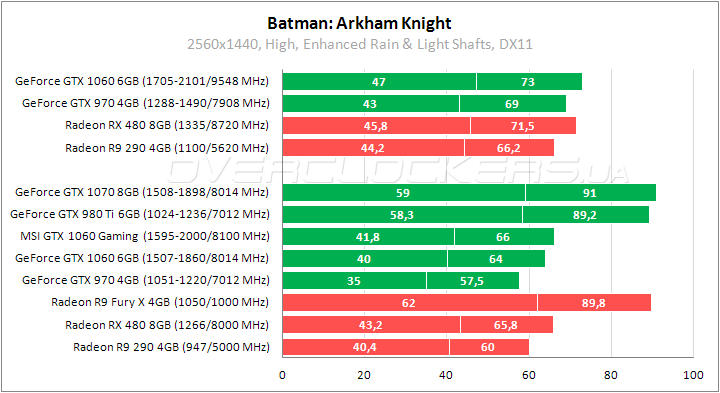
The advantage of the GeForce GTX 1060 over the GeForce GTX 970 in Arkham Knight is at the level of 11-14%, a meager lag behind the Radeon RX 480. Acceleration gives acceleration 14-17%, allowing you to keep a slight advantage over the forced Radeon RX 480.
Battlefield 4

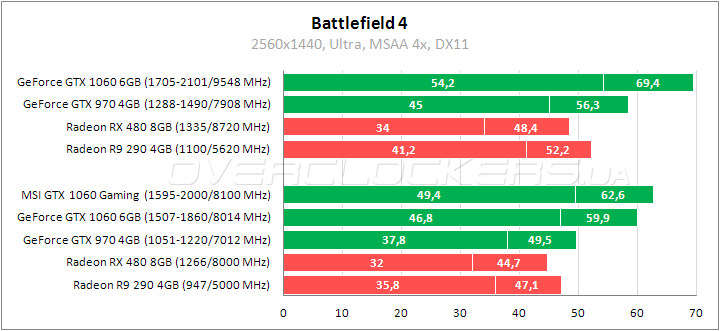
The position of the GeForce GTX 1060 in Battlefield 4 is already stronger. The gap from the GeForce GTX 970 is 21-24% and up to 30% the gap from the Radeon RX 480. MSI Gaming is 5% faster than the reference, further acceleration adds 10% acceleration.
DiRT Rally

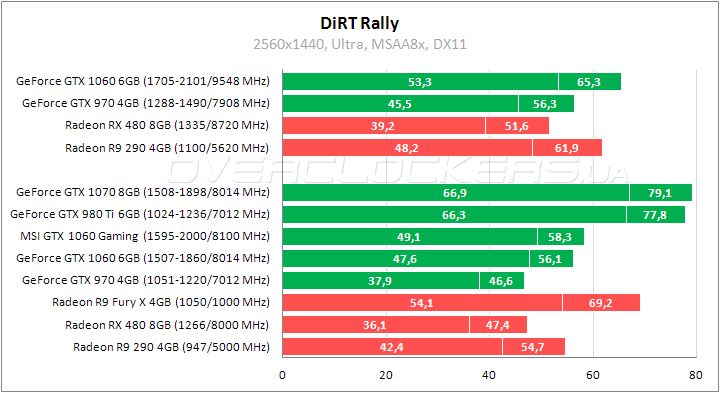
GeForce GTX 1060 with initial frequencies is more productive than GeForce GTX 970 by 18-25%. A small gap from the Radeon R9 290 and more weighty from the Radeon RX 480. Overclocking allows you to get closer to the performance of the Radeon R9 Fury X.
DOOM

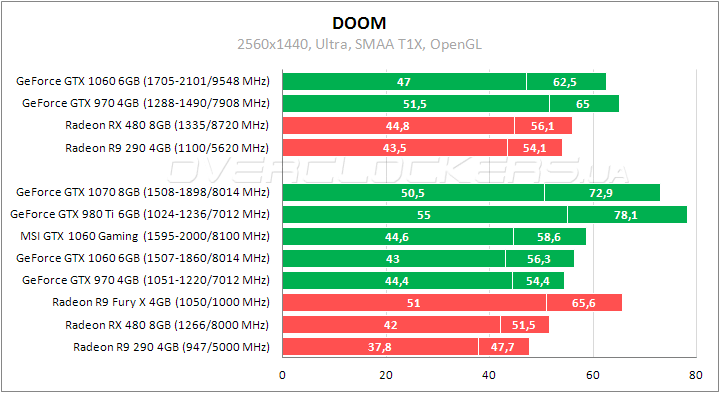
In the new DOOM, the GeForce GTX 1060 and GeForce GTX 970 have similar performance at standard frequencies, the same is true for OpenGL and older NVIDIA cards. The advantage over the Radeon RX 480 is small. Recently, the game received an update that finally added the promised support for the Vulkan API. In this mode, we will compare opponents in the following articles.
Fallout 4

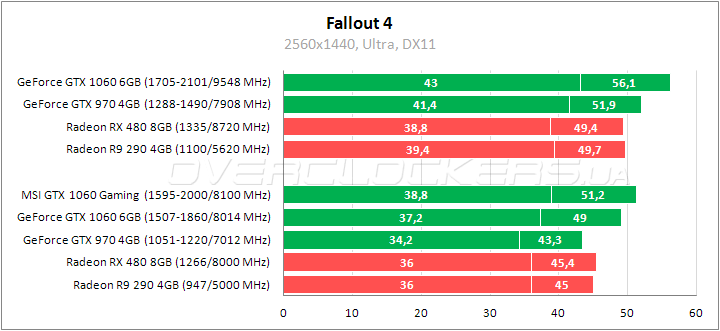
GeForce GTX 1060 is faster than GeForce GTX 970 by 8-13% in Fallout 4 and even smaller difference with competitors from AMD. Overclocking allows you to increase the lead over rivals.
Far cry primal

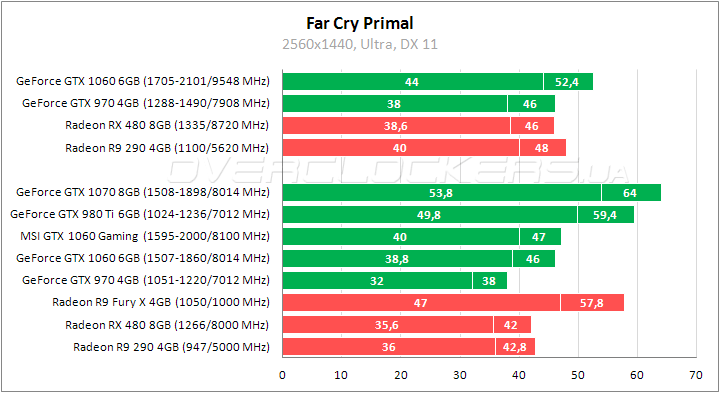
A good lead over the GeForce GTX 970 in Far Cry Primal, the advantage over the Radeon RX 480 is more modest. Overclocking allows you to increase performance by 13-14%. Accelerated competitor from AMD is 14% weaker. If we talk about the difference between the GeForce GTX 1060 and the GeForce GTX 1070, then it is about 39%; such a gap cannot be compensated for by overclocking
Gears of War: Ultimate Edition


Again a good lead over the GeForce GTX 970. But the Radeon RX 480 is a little faster this time than the GeForce GTX 1060. Overclocking these competitors are equal. It is interesting to note that the performance level of the beginner at the initial frequencies is slightly higher than that of the overclocked GeForce GTX 970.
Grand theft auto 5

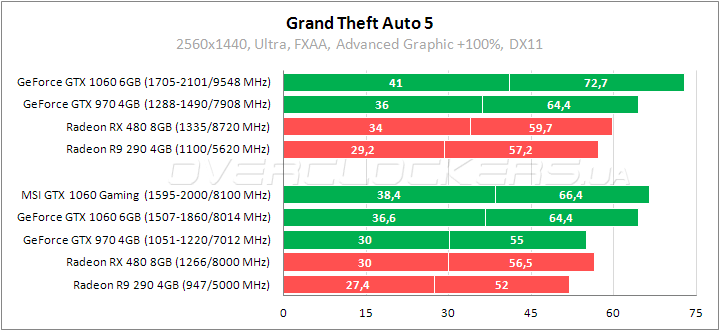
A good lead over rivals in GTA 5. The newcomer at standard frequencies shows performance on the same level as the overclocked GeForce GTX 970 and higher than the result of the forced Radeon RX 480.
Just Cause 3

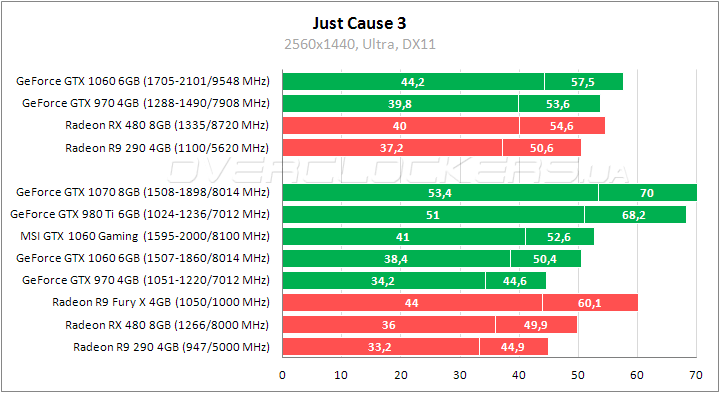
Less than 13% of the difference with the GeForce GTX 970 in Just Cause 3 and no more than 5% of the difference with the Radeon RX 480. MSI Gaming frequencies provide an additional advantage of 4-7%, further acceleration gives acceleration less than 9%. Increasing the frequencies minimizes the lag behind the Radeon R9 Fury X, but with the GeForce GTX 1070 the difference is still more than 20%.
Metro: Last Light

Let's start with the results without the resource-intensive smoothing of the SSAA.
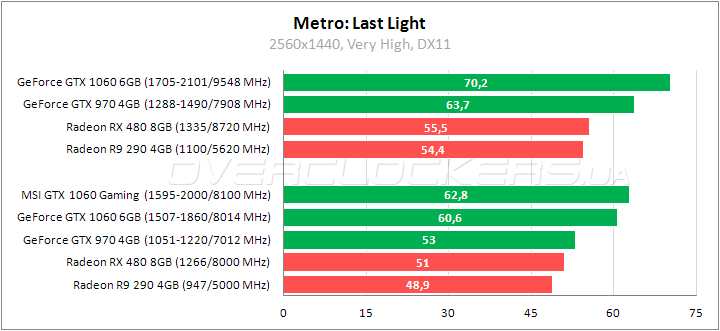
At standard frequencies, the novice is 14% faster than the GeForce GTX 970 in Last Light. The difference with AMD competitors is about 19%, so even with overclocking, the Radeon RX 480 is not able to overtake the GeForce GTX 1060.

The transition to SSAA increases the gap GeForce GTX 1060 from its closest competitors. The GeForce GTX 970 is 17% weaker, while the Radeon RX 480 loses 25%. The gap with the GeForce GTX 1070 is over 41%. Overclocking allows you to win up to 16% and reduce the backlog of Fury X to 4%.
Quantum break

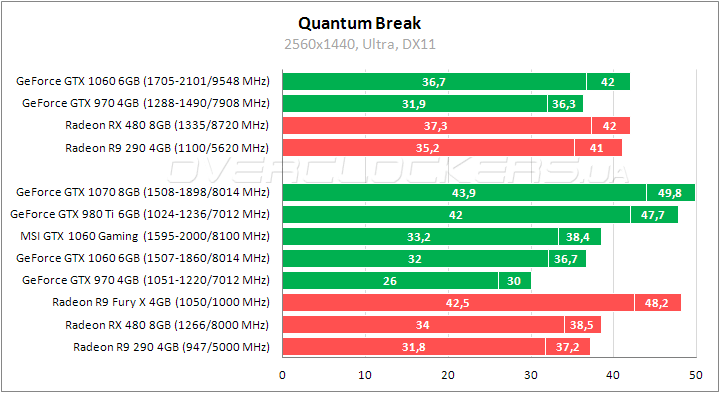
The regular version of the GeForce GTX 1060 is faster than the GeForce GTX 970 with overclocking in Quantum Break. But at the same time, the performance of the Radeon RX 480 is slightly higher, closer to this competitor MSI Gaming with factory overclocking. After overclocking, rivals GeForce GTX 1060 and Radeon RX 480 turn out to be equal.
Rise of the Tomb Raider


In Full HD mode, where younger participants show acceptable results for Rise of the Tomb Raider, the newcomer seriously outperforms the competition. GeForce GTX 1060 is 31-37% faster than the GeForce GTX 970, the difference from the Radeon RX 480 is up to 26%. None of these rivals are not able to catch up with the hero of the review due to their overclocking.

If you choose a higher resolution and unscrew all the parameters to the limit, the ratio almost does not change. It affects a higher result compared to the Radeon R9 Fury X, but the reason for this is the lack of memory for such an opponent. But the gap with the GeForce GTX 1070 at the level of 41-44%. Radeon RX 480 again can not catch up on the GeForce GTX 1060, even by increasing its frequencies.
The Witcher 3: Wild Hunt

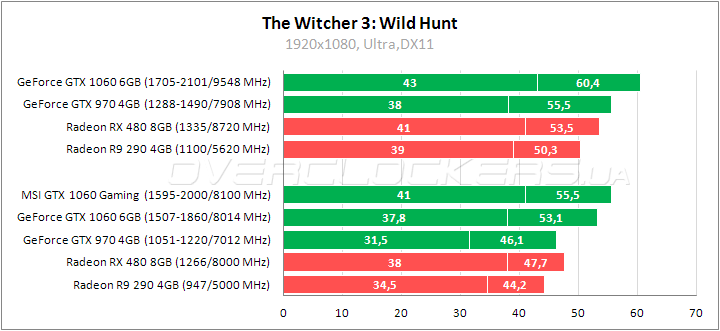
In The Witcher 3, the GeForce GTX 1060 has a good advantage over the GeForce GTX 970, but the comrade with higher frequencies is still slightly stronger. Regarding the Radeon RX 480, the gain is mainly in average fps.
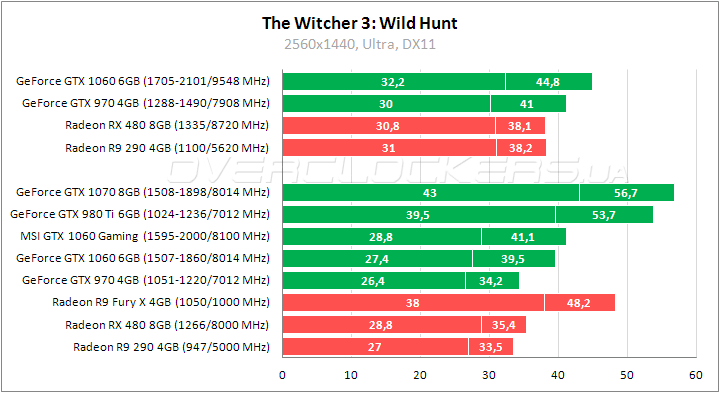
The transition to a higher resolution reduces the difference in minimum performance between the GeForce GTX 1060 and GeForce GTX 970, the average fps advantage for a beginner is more than 15%. The lag of the Radeon RX 480 only by an average of about 12%.
Tom Clancy "s the division

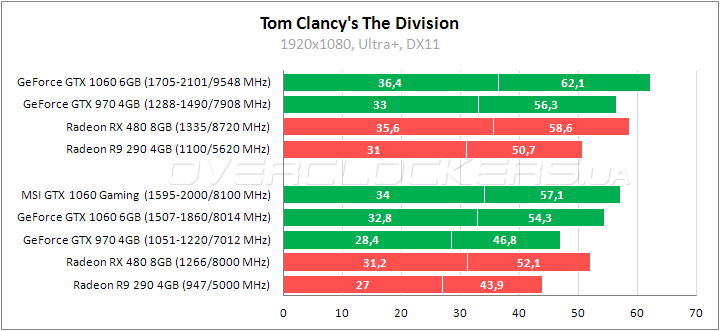
In The Division, the performance of the GeForce GTX 1060 is close to the level of the overclocked GeForce GTX 970 and is only 4-5% higher than the results of the Radeon RX 480.
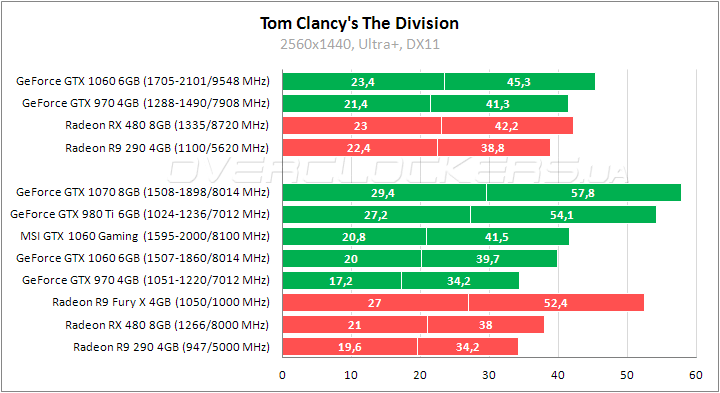
The transition to higher resolution slightly changes the situation in the ratio of the minimum fps. Now you can even talk about some kind of parity with the Radeon RX 480, but after overclocking, the GeForce GTX 1060 strengthens its position. When comparing the standard version with the GeForce GTX 1070, we can state the difference of 45%.
Total War: Warhammer


Suddenly, we see the same results for the GeForce GTX 1060 and GeForce GTX 970, both weaker than the Radeon RX 480, and even the Radeon R9 290. In overclocking, the beginner's performance scales better than that of a friend, and is almost as good as the Polaris 10 forced rival.
XCOM 2


In XCOM 2, the newcomer is separated from the GeForce GTX 970 at a level of 22-24%, the difference from the Radeon RX 480 to 12%. Both rivals cannot catch up with the GeForce GTX 1060 even after increasing their frequencies.
3DMark 11


GeForce GTX 1060 wins about 20% of the GeForce GTX 970 and over 26% of the Radeon RX 480. Increasing the frequencies to 1705-2101 MHz / 9548 MHz allows you to suddenly get around the Radeon R9 Fury X.
3DMark Fire Strike

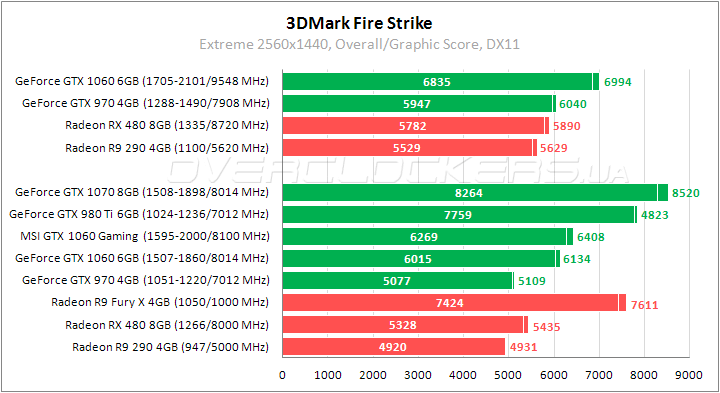
The ratio between the younger NVIDIA participants does not change, but the Radeon RX 480’s lag behind the GeForce GTX 1060 is now less than 13%.
power usage
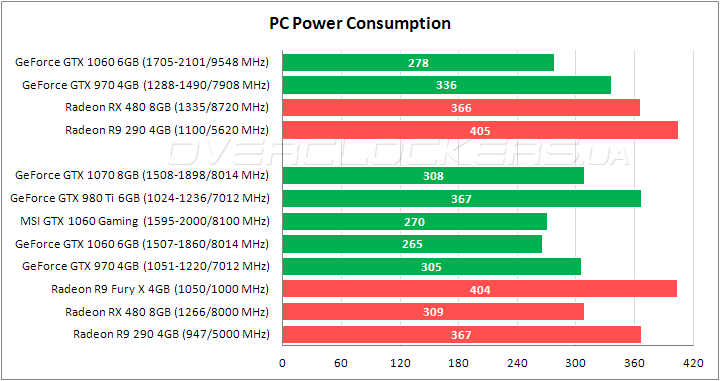
All in line with expectations. The system has the lowest power consumption with a GeForce GTX 1060. But the new Radeon RX 480 is closer to the level of GeForce GTX 970.
findings
According to the test results, it can be stated that the GeForce GTX 1060 shows performance at the level of GeForce GTX 970 with overclocking. So the newcomer really should be close to the GeForce GTX 980. And this is at a record low power consumption for this level of performance! In terms of performance and power consumption, this is currently the best video card in the middle class. Impressive performance indicators are provided by the transition to the new Pascal architecture and due to the high initial frequencies that have become available to NVIDIA graphics accelerators as part of the 16-nm process technology. GeForce GTX 1060 did not cut back on the bus, as it did with the GeForce GTX 960. The combination of a 192-bit bus and high-speed GDDR5 8 GHz modules provides high throughput. Memory size in comparison with the GeForce GTX 970 or GeForce GTX 980 is higher, which in some modern games may be quite in demand even in the popular resolution of 1920x1080. If we talk about higher resolutions or heavy graphics modes, then the GeForce GTX 1060 will receive even more weighty advantages. As for the comparison with the Radeon RX 480, a clear advantage on the side of the newcomer NVIDIA. Not everywhere this advantage is significant, but with increasing frequencies it becomes more impressive.
The overclocking potential of GPU GP106 is not much different from the results of GP104 on older NVIDIA graphics cards. Based on the overall experience with the new accelerators, suppose that MSI’s core acceleration is average or close to that. But the memory overclocking is impressive. Moreover, real productivity growth is often higher than the increase in core frequency, which indicates the obvious benefit of overclocking the video buffer. In such conditions, much will depend on the memory capacity of each individual video card. Here to catch up with older Pascal models still will not work. The GeForce GTX 1070 is 40% more powerful, which cannot be compensated by overclocking the GeForce GTX 1060. The difference with GeForce GTX 980 Ti is smaller, but even here the older video card cannot be overtaken.
MSI GeForce GTX 1060 Gaming X 6G is an improved version of the GeForce GTX 1060, which is closer to older models in terms of workmanship and cooling level. High factory overclocking will provide acceleration with respect to the usual versions, and a powerful cooling system will ensure low operating temperatures with extremely low noise levels. As for overclocking, we have already noted the high potential of memory. It is doubly pleasant that the increased frequencies are easily achievable while maintaining full acoustic comfort due to the low speed of the fans. This video card is for those who want maximum performance from the GeForce GTX 1060 with at least maximum comfort. A great option for purchase.
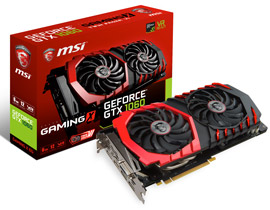

Separately, it should be noted that our article compared the non-reference version of the GeForce GTX 1060 and the standard Radeon RX 480 card. This fact plays an important role, because the weak cooling of the Radeon acts as a deterrent during overclocking. And in the nominal, due to the exceeding of the temperature limit, the overall performance slightly decreases. Non-reference versions of the Radeon RX 480 also promise a good overclocking, and it is possible that such cards in the opposition with the GeForce GTX 1060 will perform better. How true the assumptions are, will show a real comparison of non-reference rivals, what we will try to do in the future. Stay tuned, stay tuned to our reviews!
Foreword
“GeForce GTX 980 performance at a price of $ 249” - this was the motto for the presentation of the new NVIDIA GeForce GTX 1060 middle class video card. This is the first product based on the GP106 GPU, which expands the range of NVIDIA solutions with the Pascal architecture. The first and so far the only chip of this architecture was the GP104, with which we met about a month and a half ago. Now it's time to find out what the younger GP106 chip and the first video card based on it, the GeForce GTX 1060, are capable of.
1. Overview nVIDIA graphics card GeForce GTX 1060 Founders Edition 6 GB
architecture, specifications and recommended cost
The architecture of the novelty completely repeats GP104, so we will not re-pay attention to it, those who want to learn more can read our nVIDIA Overview GeForce GTX 1080. We will study the changes that are quantitative.
So, GP106 contains two GPC (Graphics Processing Cluster), five TPC (Texture Processor Cluster) each. TPC, in turn, consists of one geometry processing unit and one SM (Streaming Multiprocessor), containing 128 stream processors. As a result, the GP106 has 10 geometry processing units and 1280 stream processors — exactly half of the GP104.
The memory subsystem looks more interesting. It has lost only a quarter of the executive devices, compared with the GP104, and consists of 48 raster operations (ROP) blocks, 1.5 MB of the second-level cache, and six 32-bit memory channels, giving a resulting 192-bit bus.

For clarity, let's compare the technical characteristics of the GP106 novice, its predecessor GM206, as well as GM204, to replace which it is positioned in terms of performance (values are rounded to the nearest).

As follows from the table, a slight superiority in the number of actuators over the predecessor, multiplied by the noticeably increased clock frequencies, allows us to achieve excellent results. GeForce GTX 1060 has 81% more performance in computing speed and texturing, as well as more than double the fill rate compared to the GeForce GTX 960. New compression algorithms that save video memory bandwidth, as well as a different configuration of the memory controller, divided into six The 32-bit channels, versus the two 64-bit channels of the GM206, will allow the new player approximately double the GeForce GTX 960. Very good result. However, one should keep in mind that the recommended prices for GeForce GTX 1060 will start at $ 249, versus $ 199 for GeForce GTX 960. Nevertheless, the superiority of the new product over its predecessor is so great that even a simplified and cheaper version of the GP106, which will surely be released Soon, will surely be ahead of the GeForce GTX 960.
The fact that NVIDIA compares the GeForce GTX 1060 with the card that ranked the flagship in the period from September 2014 to March 2015 - GeForce GTX 980 speaks about the high speed of the new product. Based on the results of calculations in the table above, we see that most indicators GP106 lags behind GM204. But the gap is insignificant, and can be compensated by architectural changes Pascal. We can assume that the GeForce GTX 1060 will indeed demonstrate the performance level of the flagship of a year and a half ago in most cases, and confidently surpass the results of one of the most popular cards of the previous line - GeForce GTX 970.
Specifications and cost of the NVIDIA GeForce GTX 1060 video card are listed in the table in comparison with the reference versions of NVIDIA GeForce GTX 1080 and GTX 1070, as well as the GeForce GTX 960.
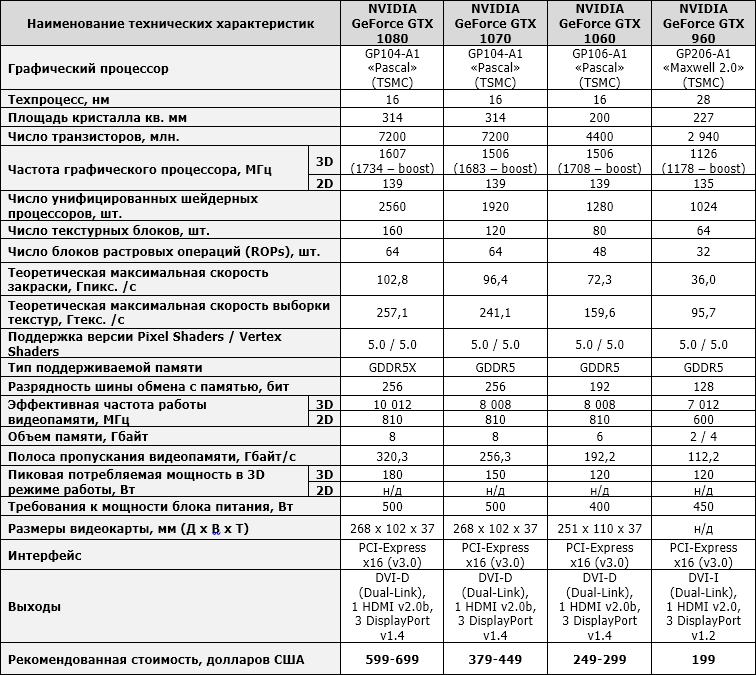
It is worth adding here that for Russia GeForce GTX 1060 announced the recommended price of 18,999 rubles, which is clearly higher than even the lower limit of $ 249 at the ruble exchange rate at the time of publication of the article.
pCB design and features
Since samples for the press were provided for testing in the usual antistatic bag, there will not be a section familiar to our readers with a description of packaging and packaging today. Immediately go to the video card.
In its design, NVIDIA GeForce GTX 1060 Founders Edition resembles older GTX 1080 and GTX 1070, although earlier GeForce GTX 960 and GTX 980/970 had nothing in common with their appearance. Now the reference video card or as it is now called Founders Edition looks stylish and attractive. Even to some extent it is a pity that such interesting externally models will be very rare in free sale.

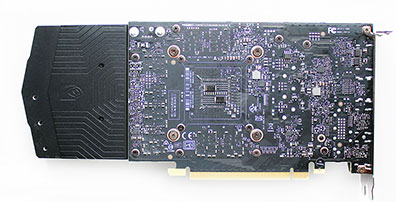
When looking at the video card from the back side, it becomes obvious that the printed circuit board of the GTX 1060 is quite short, and the total length of the video card, which is 251 mm, is complemented by the base of the cooling system.
On top of the cooler case you can see the familiar “GEFORCE GTX” inscription, equipped with a green backlight.
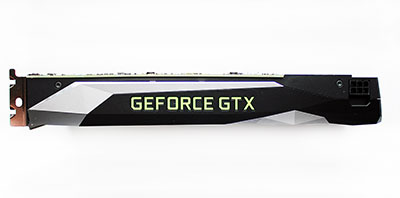

There is nothing remarkable from the bottom and from the back side, so let's add here that the height of the video card is 110 mm, and the thickness is equal to the standard 37 mm. This copy weighs 846 grams.
As with the two older models of Founders Edition graphics cards on graphics processors of the Pascal architecture, the panel with video outputs is as thin as possible to allow the air heated by the graphics card out of the case system unit. It has one DVI-D (adapters for analog video outputs are also not supported here), one HDMI version 2.0b and three DisplayPort version 1.4.
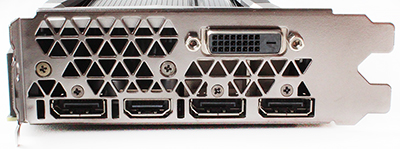
Four monitors can be connected at the same time.
Reference nVIDIA version GeForce GTX 1060 is equipped with one six-pin connector for connecting additional power. By the way, due to the shortened PCB, inside this connector is made, how to say it softer, unusual.

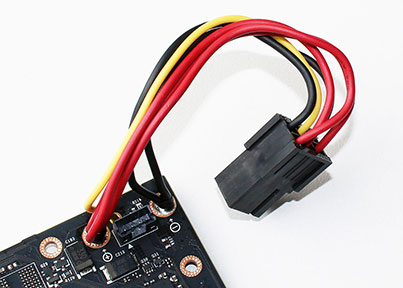
As for the power requirements of the new product, the maximum 120 watts are stated, which is no higher than the power consumption level of the GeForce GTX 960. The power supply capacity for a system with one such video card should be at least 400 watts.
The length of the video card of the video card is only 175 mm. Nevertheless, and on it you can find empty zones without elements.
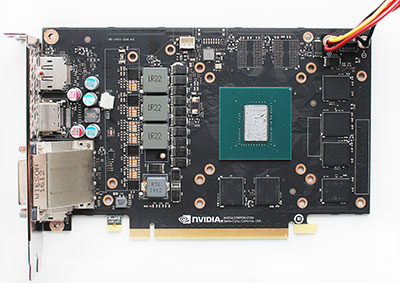

So, only three phases are allocated for powering the GPU, but only one for memory and power circuits.
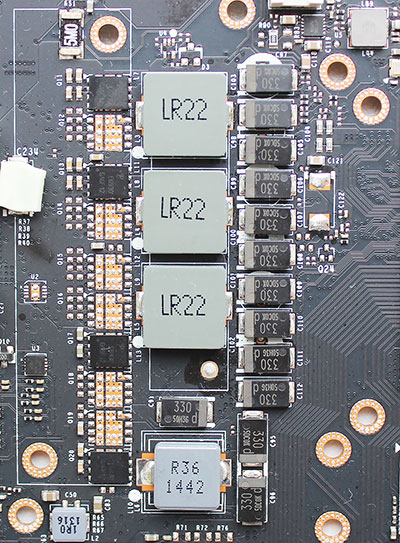
The GPU power management is performed by the uP9509P controller, information about which could not be found.
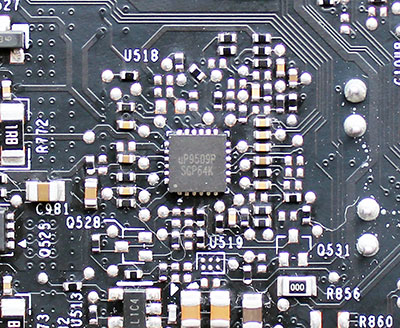
The monitoring functions on the video card are assigned to Texas Instruments' INA3221 chip.

The GP106-400-A1 graphics processor does not have a protective frame around the substrate, and, as practice shows, testing original versions of older GTX 1080/1070, GeForce GTX 1060 production models will also be deprived of it, so you must be very careful when removing and installing cooling systems , to prevent chipping crystal. The area of the latter is approximately 200 mm2, and the GPU of our GeForce GTX 1060 instance was released on the 20th week of the current year (mid-May) and belongs to revision A1.
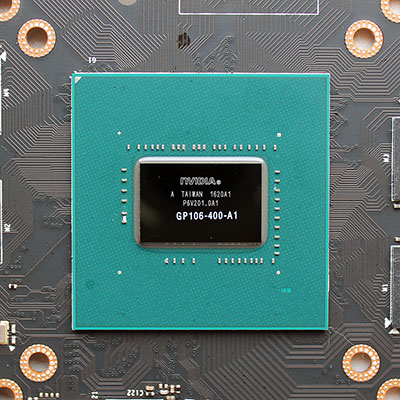
The new GP106 contains 1280 unified shader processors (33.3% less than the GTX 1070 and 25% more than the GTX 960), 80 texture units and 48 ROP. The base frequency of the graphics processor in 3D mode for GeForce GTX 1060 is the same as for GeForce GTX 1070 and is equal to 1506 MHz, which is 33.7% higher than that of GeForce GTX 960. In addition, this frequency can automatically increase up to 1708 MHz, and according to the monitoring data it reached impressive 1886 MHz! Simply put, this is a huge advantage over the replaced GeForce GTX 960. We add that when switching to 2D mode, according to monitoring data, the frequency of the GP106 decreased to 139 MHz.
On the front side of the printed circuit board, six GDDR5 video memory chips in the FCFBGA package with a total volume of 6 GB on a 192-bit bus are soldered. By the way, two more platforms for memory chips on the PCB are empty, although this does not at all mean that after some time GeForce GTX 1060 can be released Ti with a 256-bit bus and 8 GB of memory. The chips are manufactured by Samsung, are labeled K4G80325FB-HC25 and have a theoretical effective frequency of 8000 MHz.

Due to such a high frequency, such chips, even on a 192-bit bus, are capable of providing 192.2 GB / s of bandwidth, which is 71.3% higher than the bandwidth of the GeForce GTX 960 with its 128-bit memory bus. For video cards of this class, the increase in video memory is tripled (namely, two-gigabyte GTX 960 is most widely used) with a simultaneous so significant increase in throughput - a huge step forward! In 2D mode, the frequency geforce memory The GTX 1060 is reduced to 810 effective megahertz.
At the end of the review of the reference NVIDIA GeForce GTX 1060 Founders Edition, we add that the latest GPU-Z version available at the time of preparing the article is already familiar with the characteristics of this video card.
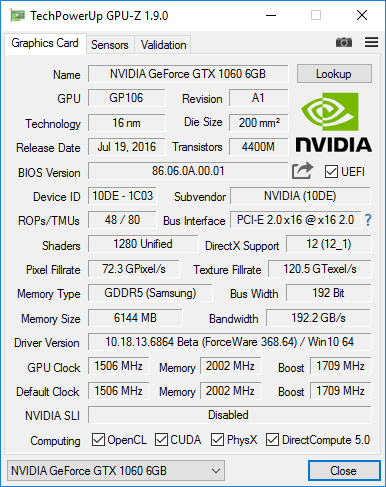
cooling system - efficiency and noise level
The cooling system of the NVIDIA GeForce GTX 1060 Founders Edition graphics card is made according to the classic reference pattern scheme. The plastic cover is fastened with four screws around the perimeter and is removed without any difficulties.
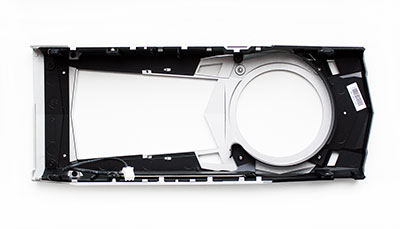
Below it are visible two separate radiators, painted black, and a radial fan.
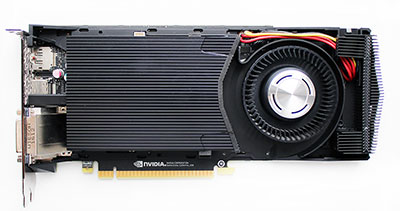
We disassemble the cooler further and remove the radiators from the board and the metal base.
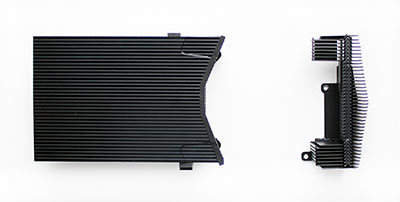
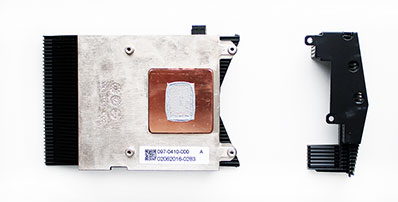
The radiator responsible for cooling the graphics processor has a copper base with which it contacts through a thick gray thermal grease. Additional radiator is designed to somewhat relieve the base, which, in turn, is in contact with the individual power elements of the printed circuit board.
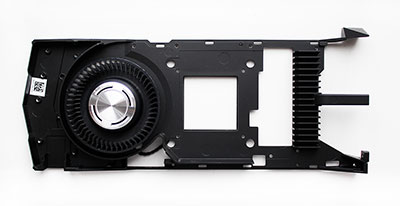
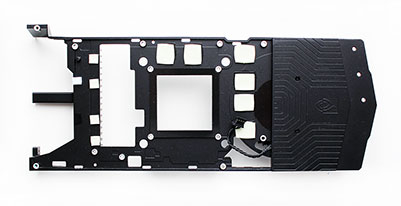
Everything is pretty simple and neat. We add that the speed of rotation of the radial fan is automatically adjusted by pulse-width modulation in the range from 1500 to 3250 rpm.
To create a load when checking the temperature conditions of the NVIDIA GeForce GTX 1060 Founders Edition video card, we used nineteen cycles of the new 3DMark stress test.
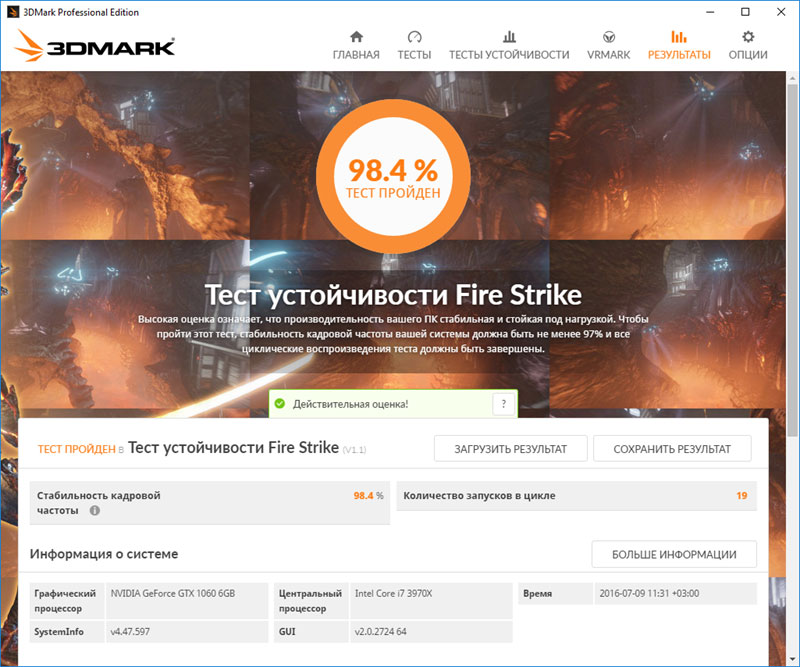
MSI Afterburner version 4.3.0 Beta 4 and GPU-Z utility versions 0.8.9 and 1.9.0 were used to monitor temperatures and all other parameters. All tests were conducted in a closed case of the system unit, the configuration of which you can see in the next section of the article, with a rather high average room temperature 26 degrees Celsius.
First of all, we checked temperature condition operation of the reference video card with fully automatic fan speed control.

Automatic mode (1590 ~ 2570 rpm)
As you can see, despite the 16-nm process standards, the GP106 turned out to be a rather hot graphics processor. In 12 minutes of the test, its temperature reached 85 degrees Celsius, and the speed of the turbine increased to 2570 rev / min. This is the price for a very high frequency, which reached 1886 MHz during testing. At the same time, we have no doubt that the original cooling systems of the serial GeForce GTX 1060 video cards will easily cope with the hot temper of the new product, and at the same time calm it down.
Next, we tested at the highest possible fan speed.
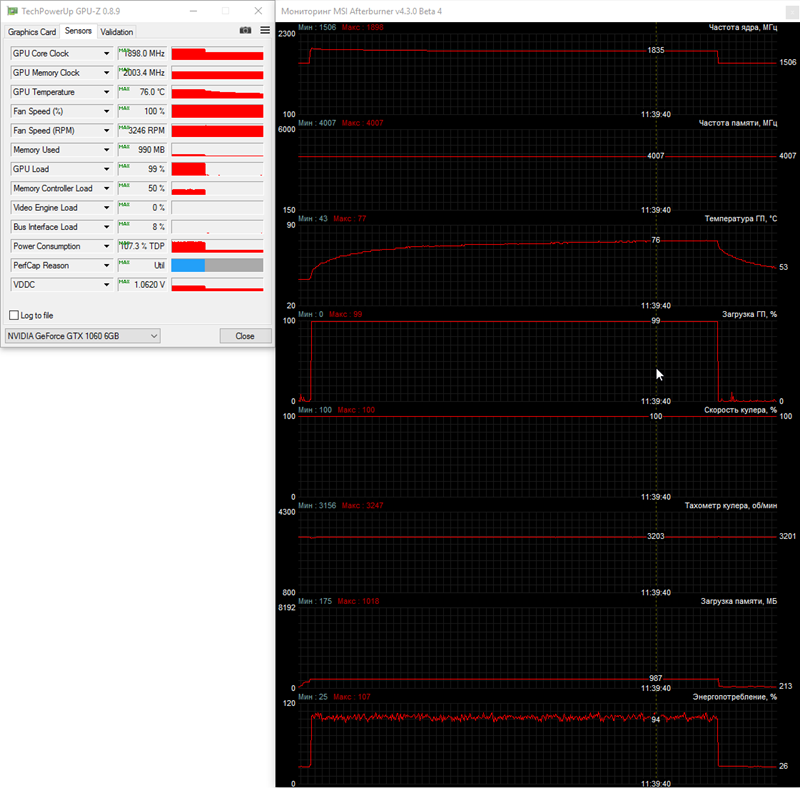
Maximum speed (~ 3250 rpm)
It was possible to win almost 10 degrees Celsius in terms of the temperature of the graphics processor, which is pretty good, considering the slight difference in the upper limit of the cooler speed with its automatic adjustment and maximum power. As you understand, the noise level of NVIDIA GeForce GTX 1060 Founders Edition operating in this mode is quite high.
overclocking potential
To check the overclocking potential of NVIDIA GeForce GTX 1060 Founders Edition, we set the maximum power limit (116%) and temperature limit (92 degrees Celsius), and manually set the fan speed to 90% power, which is approximately 3000 rpm. With such settings of the video card without loss of stability and the appearance of image defects, we increased the base frequency of the graphics processor by 230 MHz (+ 15.3%), and the effective frequency of the video memory - by 1340 MHz (+ 16.7%).

After such an increase, the frequency of the graphics processor was 1736-1939 MHz, and according to the monitoring data, the frequency of the GP106 briefly increased to 2126 MHz. However, in the course of testing, it was more often kept at the mark of 2038 MHz than at its peak.
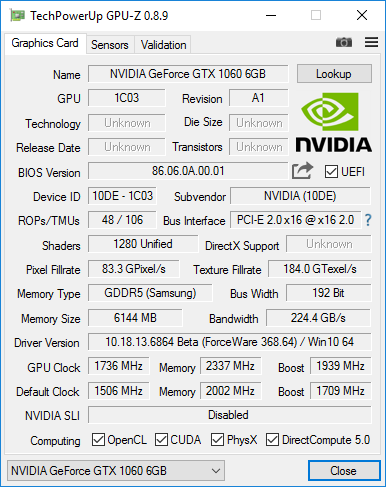
As for the temperatures of the overclocked video card of the reference design, at 90% of the capacity of the regular fan of the cooler, we managed to keep them within 85 degrees Celsius.
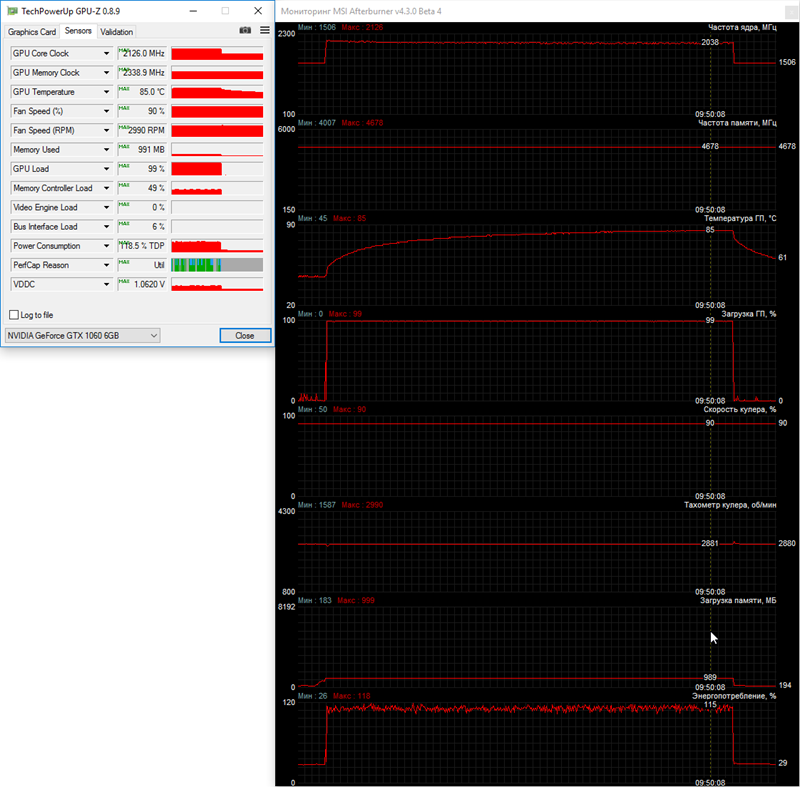
90% power, ~ 3000 rpm
The normal operating temperature limit for the NVIDIA GP106 GPU is 94 degrees Celsius, so our overclocked NVIDIA GeForce GTX 1060 Founders Edition is still far from this mark.
3. Test configuration, tools and testing methodology
Performance testing of video cards was carried out in a closed package on the system of the following configuration:
motherboard: ASUS Sabertooth X79 (Intel X79 Express, LGA2011, BIOS 4801 of 07/28/2014);
cPU: Intel Core i7-3970X Extreme Edition 3.5 / 4.0 GHz (Sandy Bridge-E, C2, 1.1 V, 6 x 256 Kb L2, 15 MB L3);
cPU cooling system: Phanteks PH-TC14PE (2 x Corsair AF140 at 900 rpm);
thermal interface: ARCTIC MX-4;
video cards:
NVIDIA GeForce GTX 1070 Founders Edition 8 GB 1506-1683 (1886) / 10012 MHz;
NVIDIA GeForce GTX 1060 Founders Edition 6 GB 1506-1708 (1886) / 8008 MHz and 1736-1939 (2126) / 9348 MHz;
Inno3D iChill GF GTX 980 Ultra HerculeZ X4 Air Boss 4 GB 1266-1367 (1394) / 7200 MHz;
ASUS GeForce GTX 970 DC Mini 4 GB 1050-1178 / 7012 MHz (GTX970-DCMOC-4GD5);
MSI GeForce GTX 960 Gaming 2 GB 1216-1279 / 7012 MHz;
rAM: DDR3 4 x 8GB G.SKILL TridentX F3-2133C9Q-32GTX (X.M.P. 2133 MHz, 9-11-11-31, 1.6 V);
system and game disk: Intel SSD 730 480GB (SATA-III, BIOS vL2010400);
disk for storage of programs and games: Western digital VelociRaptor (SATA-II, 300 GB, 10,000 rpm, 16 MB, NCQ);
archival disk: Samsung Ecogreen F4 HD204UI (SATA-II, 2 TB, 5400 rpm, 32 MB, NCQ);
sound card: Auzen X-Fi HomeTheater HD;
case: Thermaltake Core X71 (four be quiet! Silent Wings 2 (BL063) at 900 rpm);
control and monitoring panel: Zalman ZM-MFC3;
power supply: Corsair AX1500i Digital ATX (1500 W, 80 Plus Titanium), 140 mm fan;
monitor: 27-inch Samsung S27A850D (DVI, 2560 x 1440, 60 Hz).
NVIDIA GeForce GTX 1070 Founders Edition will be the first rival of NVIDIA GeForce GTX 1060 Founders Edition as the top performance benchmark, and from the “old guard” we included the original Inno3D iChill GF GTX 980 Ultra HerculeZ X4 Air Boss.

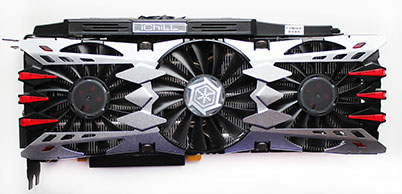

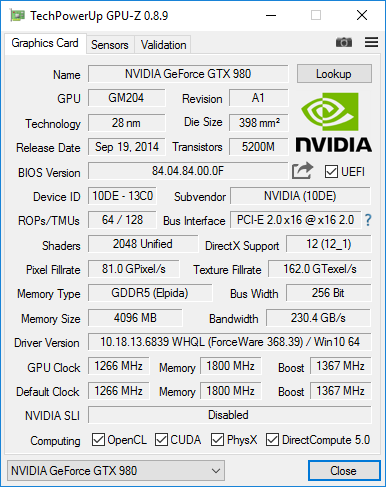
For sure, many will be interested in how much the GeForce GTX 1060 is lagging behind the GeForce GTX 1070 and will they be able to compete with the GeForce GTX 980 on equal terms, which at one time was the flagship video card on NVIDIA graphics processors.
In addition, ASUS GeForce GTX 970 DC Mini 4 GB and MSI GeForce GTX 960 Gaming 2 GB are included in testing for understandable reasons.
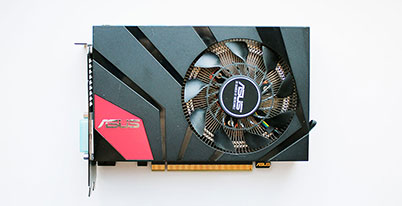
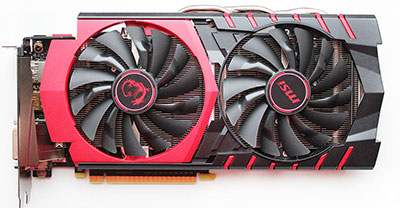
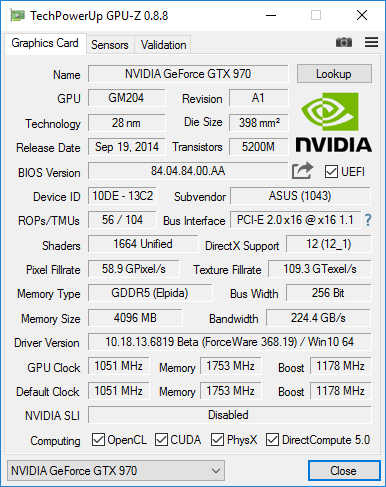
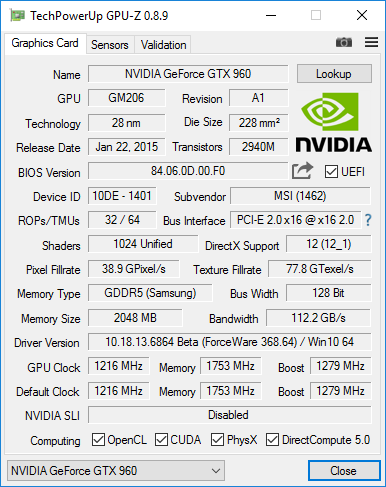
We add that the limits on power and temperature on all video cards have been increased to the maximum possible.
Attention! Absence in today's testing AMD Radeon The RX 480 is explained very simply - we got this video card later on the GeForce GTX 1060 and is currently preparing a separate article that (tentatively) will be released in a week, where it will be compared to two direct competitors of the “fresh cut”.
To reduce the dependence of video card performance on platform speed, a 32nm six-core processor with a multiplier of 48, a reference frequency of 100 MHz and the Load-Line Calibration function activated for Ultra High was accelerated to 4.8 GHz with an increase in voltage in the BIOS of the motherboard to 1.385 V.

Hyper-Threading technology is activated. At the same time 32 gigabytes random access memory functioned at a frequency of 2.133 GHz with timings 9-11-11-20_CR1 at a voltage of 1.6125 V.
Testing, started July 11, 2016, was conducted under the control of operating system Microsoft Windows 10 Professional with all updates for the specified date and with the installation of the following drivers:
intel Chipset Drivers motherboard chipset - 10.1.1.32 WHQL 07.04.2016;
Intel Management Engine Interface (MEI) - 11.5.0.1101 WHQL 06.30.2016;
video card drivers on NVIDIA GPUs - GeForce 368.64 beta for GeForce GTX 1060 and GeForce 368.39 WHQL of 06/06/2016 for other NVIDIA cards.
The performance of the video cards was tested in resolutions of 1920 x 1080 and 2560 x 1440 pixels. For the tests, two graphics quality modes were used: Quality + AF16x - texture quality in the default drivers with the inclusion of 16x anisotropic filtering and Quality + AF16x + MSAA 4x (8x) with the inclusion of 16x anisotropic filtering and 4x or 8x full-screen anti-aliasing, in cases when the average number of frames per second remained high enough for a comfortable game. In individual games, due to the specificity of their game engines, other smoothing algorithms were used, which will be indicated later in the methodology and on the diagrams. The inclusion of anisotropic filtering and full-screen anti-aliasing was performed directly in the game settings. If these settings in the games were missing, the parameters were changed in the control panel geForce drivers. In the same place, vertical synchronization (V-Sync) was forcibly disabled and the priority of the maximum performance mode was set.

In addition to this, no additional changes were made to the driver settings.
The video cards were tested in two graphics tests and in fifteen games, updated to latest versions on the date of commencement of preparation The list of test applications is as follows (games and further test results in them are arranged in the order of their official release):
3DMark (2013) (DirectX 9/11) - version 2.0.2724, testing in scenes of Cloud Gate, Fire Strike, Fire Strike Extreme and Fire Strike Ultra;
Unigine Valley Bench (DirectX 11) - version 1.0, maximum quality settings, AF16x and (or) MSAA 8x, resolution 1920 x 1080 and 2560 x 1440 pixels;
Crysis 3 (DirectX 11) - version 1.3.0.0, all graphics quality settings to maximum, degree of blurring is average, glare is on, modes with FXAA and with MSAA 4x, double sequential passage of a scripted scene from the beginning of the Swamp mission with a duration of 105 seconds;
Metro: Last Light (DirectX 11) - version 1.0.0.15, we used the in-game test, graphics quality settings and tessellation at the Very High level, Advanced PhysX technology in two test modes, tests with SSAA and without smoothing, double sequential run of the scene D6;
Company of Heroes 2 (DirectX 11) - version 4.0.0.21543, double sequential run of the test embedded in the game with the maximum quality settings for graphics and physical effects;
Battlefield 4 (DirectX 11) - version 1.2.0.1, all graphics quality settings on Ultra, double sequential running of the scripted scene from the beginning of the TASHGAR mission for 105 seconds (for video cards on AMD GPU, the API Mantle was used);
Thief (DirectX 11) - version 1.7 build 4158.21, graphics quality settings to the maximum level, Paralax Occlusion Mapping and Tessellation technologies are activated, a double sequential run of the benchmark built into the game (for graphics cards on AMD GPU, the API Mantle was used);
Sniper Elite III (DirectX 11) - version 1.15a, quality settings at the Ultra level, V-Sync is disabled, tessellation and all effects are activated, tests with SSAA 4x and without anti-aliasing, double sequential running of the benchmark built into the game (AMD Mantle API used for graphics cards on AMD GPU) );
(DirectX 11) - build 1951.27, all quality settings are manually set to the maximum and Ultra levels, tessellation and depth of field are activated, at least two consecutive runs of the benchmark built into the game;
Grand theft auto v (DirectX 11) - build 757.4, quality settings at the Very High level, ignoring the proposed restrictions is on, V-Sync is disabled, FXAA is activated, NVIDIA TXAA is off, MSAA for reflections is off, soft shadows are NVIDIA / AMD;
DiRT Rally (DirectX 11) - version 1.2, the Okutama track test built into the game was used, graphics quality settings for the maximum level for all items, Advanced Blending - On; tests with MSAA 8x and no smoothing;
Batman: Arkham Knight (DirectX 11) - version 1.6.2.0, quality settings at High, Texture Resolutioin normal, Anti-Alasing on, V-Sync disabled, tests in two modes — with and without the last two options NVIDIA GameWorks activated; in the game of the test;
(DirectX 11) - version 3.1, texture quality settings at the Very High level, Texture Filtering - Anisotropic 16x, and other maximum quality settings, tests with MSAA 4x and without anti-aliasing, double sequential running of the test embedded in the game.
Rise of the Tomb Raider (DirectX 12) - version 1.0 build 668.1_64, all parameters to Very High, Dynamic Foliage - High, Ambient Occlusion - HBAO +, tessellation and other quality improvement techniques activated, two test cycles of the built-in benchmark without smoothing and with SSAA 4.0 activated;
Far cry primal (DirectX 11) - version 1.3.3, maximum quality level, high resolution textures, volumetric fog and shadows to maximum, built-in performance test without smoothing and with SMAA activation;
Tom Clancy’s The Division (DirectX 11) - version 1.3, maximum quality level, all picture enhancement parameters are activated, Temporal AA - Supersampling, test modes without anti-aliasing and with SMAA 1X Ultra activation, built-in performance test but fixing FRAPS results;
Hitman (DirectX 12) - version 1.2.2, built-in test with graphics quality settings at Ultra level, SSAO enabled, Ultra shadow quality, memory protection disabled.
If the games realize the possibility of fixing the minimum number of frames per second, then it was also reflected in the diagrams. Each test was carried out twice; the best of the two values obtained was taken as the final result, but only if the difference between them did not exceed 1%. If the deviations of the test runs exceeded 1%, then the testing was repeated at least once more in order to get a reliable result.
4. Performance test results
Since today we are testing only video cards on NVIDIA GPUs, the green color will prevail on the diagrams. At the same time, to highlight the results of NVIDIA GeForce GTX 1060 in the nominal mode of operation, we chose a dark turquoise color, and when overclocked, it was highlighted with an even darker shade of the same color. We add that in the diagrams in each quality mode the test results are sorted from top to bottom in descending order of the cost of video cards.
3DMark (2013)
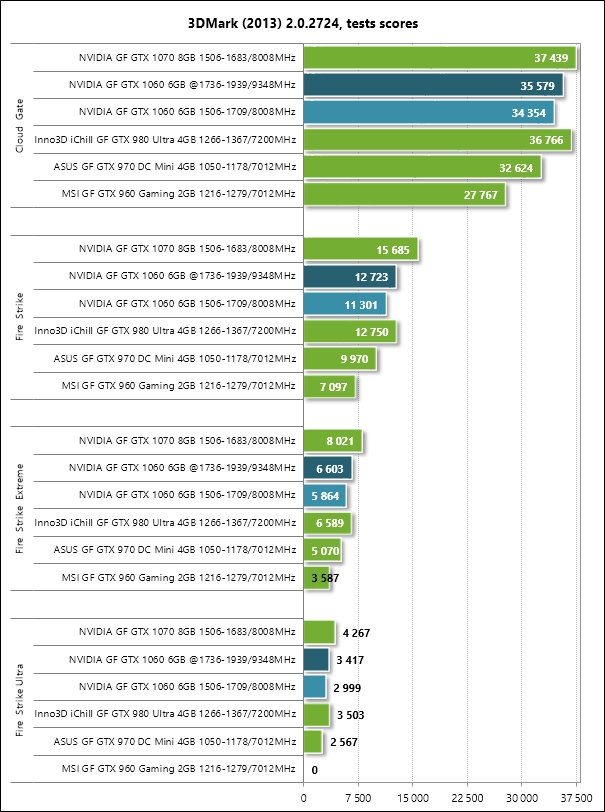
In 3DMark new nvidia The GeForce GTX 1060 demonstrates very decent performance, almost 80% ahead of MSI GeForce GTX 960 Gaming and bypassing the ASUS GeForce GTX 970 DC Mini. With a fast, even by modern standards Inno3D iChill GF GTX 980 Ultra, the novelty cannot cope at nominal frequencies, but at overclocking their performance is almost the same. In turn, the lag of NVIDIA GeForce GTX 1060 from NVIDIA GeForce GTX 1070 in this test is 25-30%.
Unigine Valley Bench
We can observe the alignment of forces quite comparable with 3DMark in the Unigine Valley benchmark.
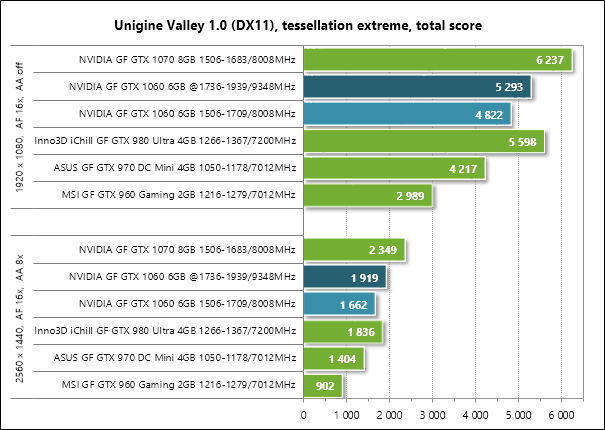
Crysis 3
The results in Crysis 3 demonstrated a tremendous advantage of the reference GeForce GTX 1060 over the original GeForce GTX 960, reaching 82% in one of the quality modes.
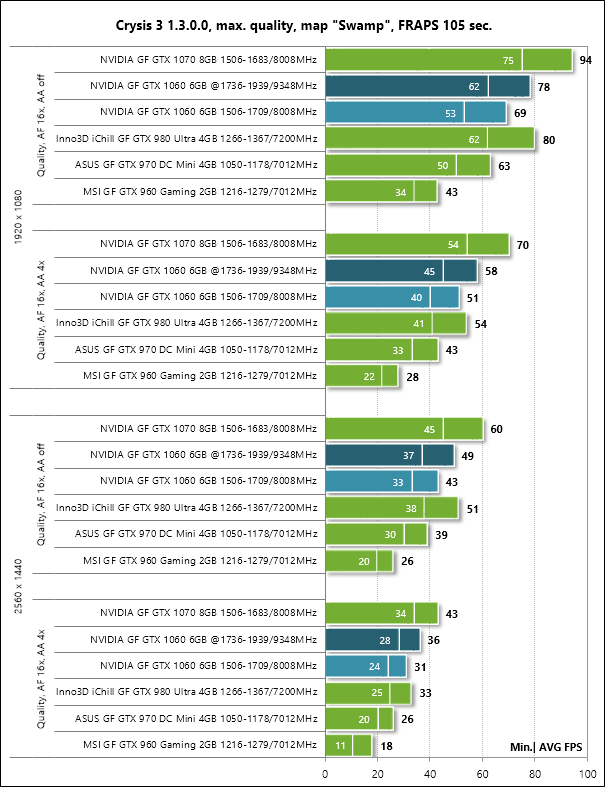
The novelty in this game feels confidently against the background of the GeForce GTX 970, and even the high-frequency version of the GeForce GTX 980. But the difference with the GeForce GTX 1070 is too big to compensate for its overclocking GeForce GTX 1060.
Metro: Last Light
Note that we traditionally tested the Metro: Last Light game both with the activation of Advanced PhysX and without using this technology. Since there are no graphics cards with AMD graphics processors in today's testing, the distribution of forces between the video cards in each of the test modes is the same.


NVIDIA GeForce GTX 1060 is 53-68% faster than MSI GeForce GTX 960 Gaming and is 9-14% ahead of ASUS GeForce GTX 970 DC Mini. But the Inno3D iChill GF GTX 980 Ultra is no longer possible to win, including during overclocking. The advantage of the GeForce GTX 1070 over a video card on GP106 here is 25-29%.
Company of Heroes 2
Except for the least resource-intensive testing mode in the game Company of Heroes 2, the performance of the video cards being tested today can be compared.
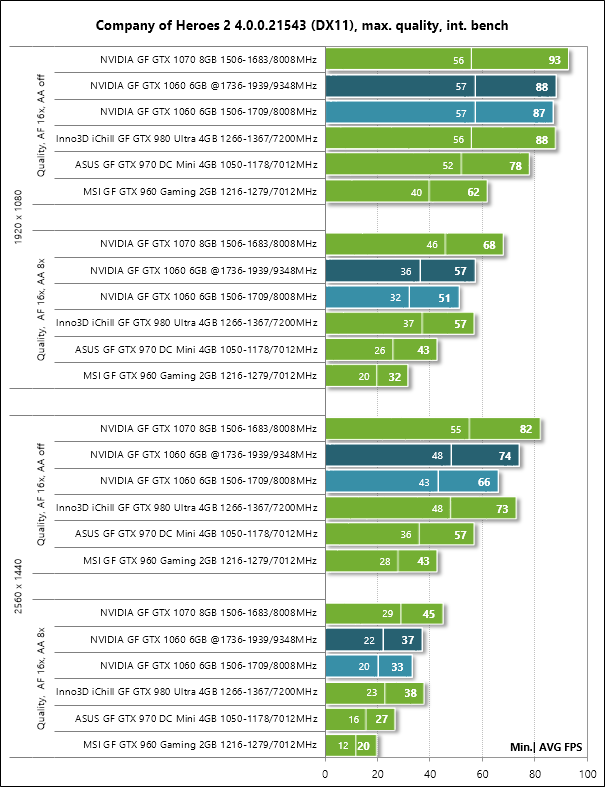
And the new NVIDIA GeForce GTX 1060 continues to impress with its advantage over MSI GeForce GTX 960 Gaming reaching 65% in the resolution of 2560 x 1440 pixels with anti-aliasing. The new ASUS GeForce GTX 970 DC Mini surely wins, and with the original Inno3D iChill GF GTX 980 Ultra is ready to be compared when overclocked. At the same time, the GeForce GTX 1060 will not be able to catch up with the standard NVIDIA GeForce GTX 1070, which is quite natural.
Battlefield 4
The game Battlefield 4 is still played by many gamers, and it is also well suited for comparing modern video cards.
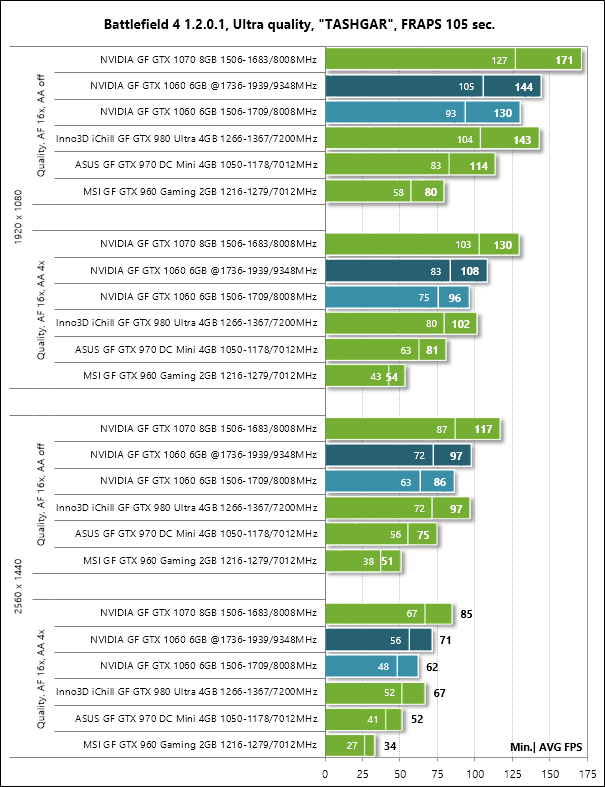
In general, the picture is exactly the same as in previous games, so immediately go on.
Thief

Without unique features tested in the game Thief.
Sniper Elite III
Sniper Elite III, as usual, was marked by a significant decrease in the performance of video cards when one of the highest-quality smoothing algorithms SSAA 4.0 was activated.
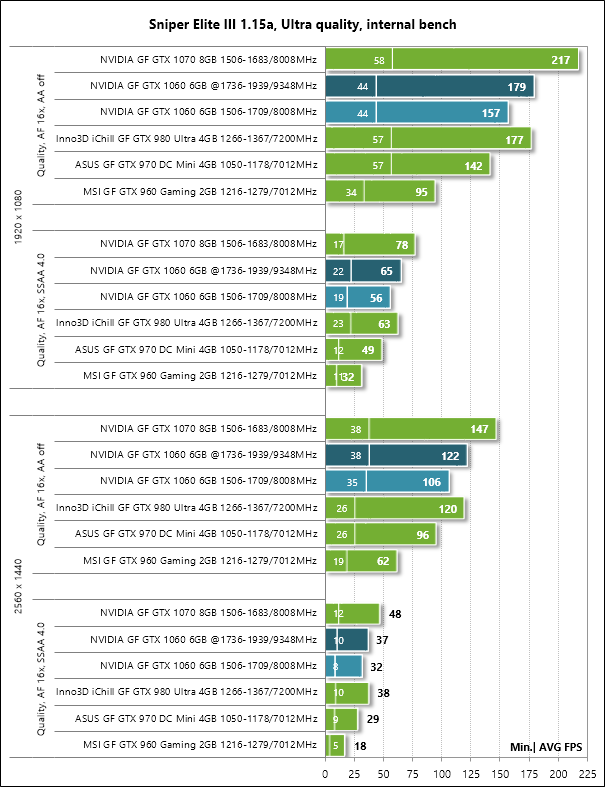
Nevertheless, NVIDIA GeForce GTX 1060 proved to be excellent here, outperforming MSI GeForce GTX 960 Gaming by 65-78%, ASUS GeForce GTX 970 DC Mini by 11-14% and reaching the level of Inno3D iChill GF GTX 980 Ultra during overclocking. And let the older NVIDIA GeForce GTX 1070 remain ahead, the performance of the new product impressed us very much.
Middle-earth: Shadow of Mordor
Even more significant advantage of NVIDIA GeForce GTX 1060 vs. MSI GeForce GTX 960 Gaming can be seen in the benchmark of the game Middle-earth: Shadow of Mordor.
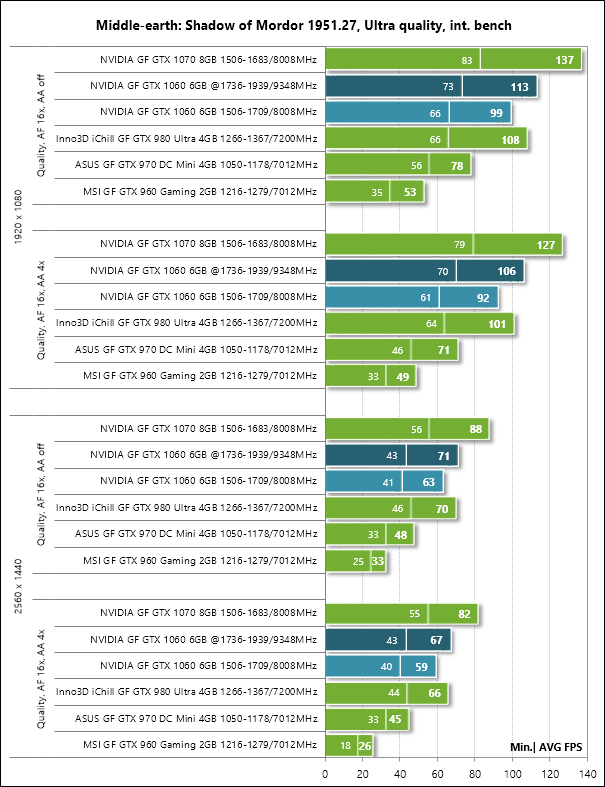
Here it reaches 127%, but, as you will see later, this is not a record in today's article.
Grand theft auto v
This game is very critical to the amount of video memory, so the two-gigabyte MSI GeForce GTX 960 Gaming with the maximum quality settings simply do not play it, which is not the case with NVIDIA GeForce GTX 1060.

The performance of the new product is almost twice as high as that of its predecessor, and in addition it is ahead of the GeForce GTX 970, and is also capable of “sorting out” the original GeForce GTX 980 when overclocked.
DiRT Rally
The newer the games on our test list, the higher the requirements for video memory, and DiRT Rally is no exception.
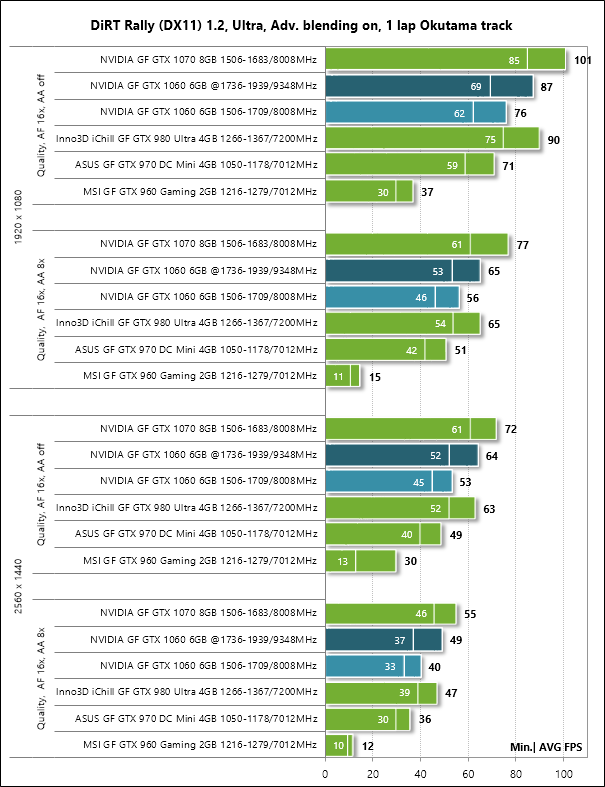
Speaking very simply, on MSI GeForce GTX 960 Gaming, you can play this game more or less comfortably only in 1920 x 1080 resolution without using anti-aliasing, while on NVIDIA GeForce GTX 1060 all even the most demanding quality and resolution modes are available.
Batman: Arkham Knight
Batman: Arkham Knight echoes the results of previous games. Suppose there is no failure in MSI GeForce GTX 960 Gaming with its two gigabytes of video memory "on board", but the advantage of NVIDIA GeForce GTX 1060 again, as they say, is evident.
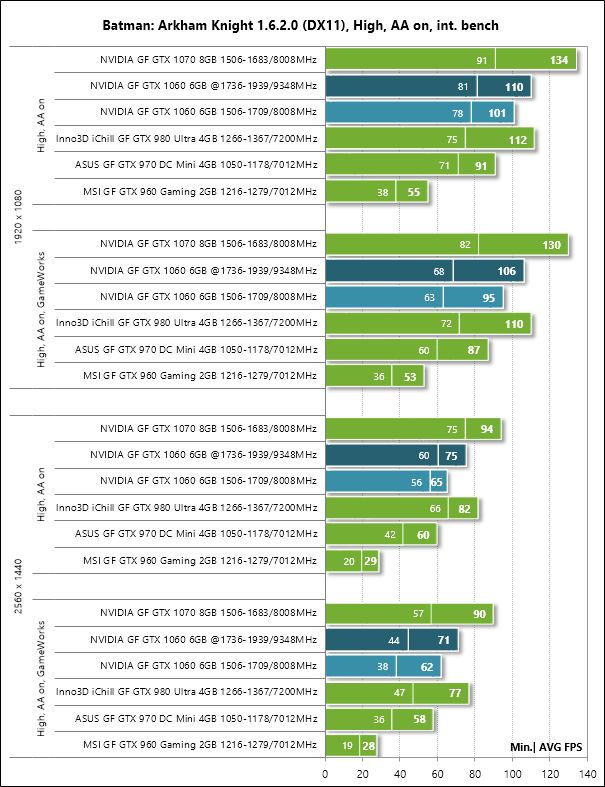
Tom Clancy "s Rainbow Six: Siege
Much more significant difference between the video cards can be seen in the game Rainbow Six: Siege.

Of the rivals of NVIDIA GeForce GTX 1060, only the original Inno3D iChill GF GTX 980 Ultra, which we again manage to catch up during overclocking, and the NVIDIA GeForce GTX 1070 remain here.
Rise of the Tomb Raider
If the previous games did not convince someone of the failure of two or four gigabytes of video memory, then Rise of the Tomb Raider does it to the full.
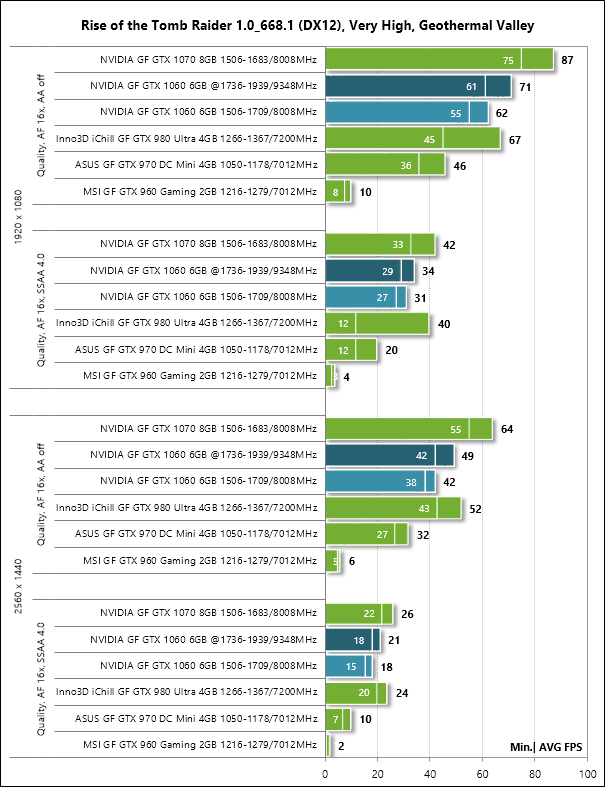
The advantage of NVIDIA GeForce GTX 1060 over MSI GeForce GTX 960 Gaming in the most resource-intensive scene of the benchmark built into the game is measured several times, while for ASUS GeForce GTX 970 DC Mini the novelty wins from 31 to 80%!
Far cry primal
More loyal to the video memory capacity, Far Cry Primal allows you to play on MSI GeForce GTX 960 Gaming, but it is obvious that 80-90% faster NVIDIA GeForce GTX 1060 provides here a much more comfortable FPS.

Once again, we note that during acceleration new video card GP106 goes to the level of the original Inno3D iChill GF GTX 980 Ultra, which is one of the fastest versions of the GeForce GTX 980.
Tom Clancy’s The Division

As you can see, the alignment of forces between the video cards in this game is classic for today's testing.
Hitman
Finally, the most resource-consuming Hitman game made it impossible to use anti-aliasing on MSI GeForce GTX 960 Gaming and ASUS GeForce GTX 970 DC Mini, although NVIDIA GeForce GTX 1060 did not just cope with this task, but was able to beat Inno3D iChill GF GTX 980 Ultra in one of the test modes.
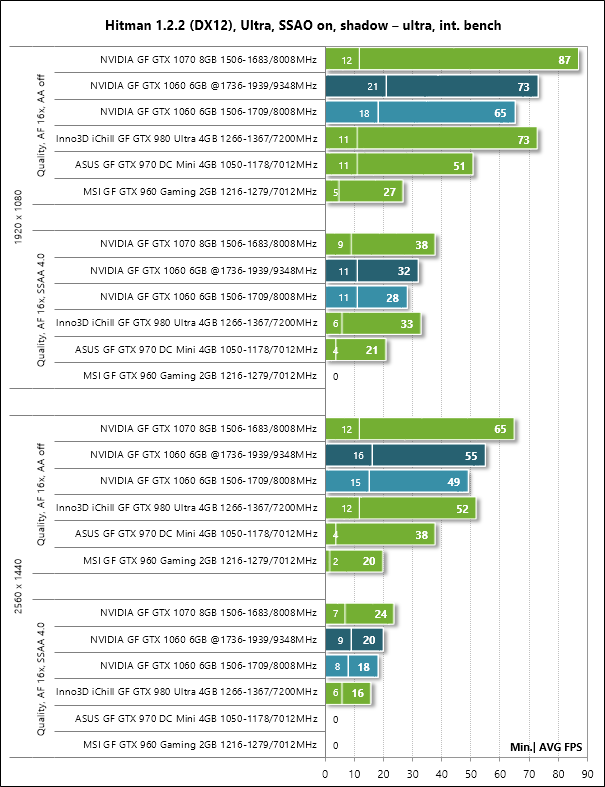
Next, we supplement the constructed diagrams with a final table with test results with the average and minimum number of frames per second derived for each video card.
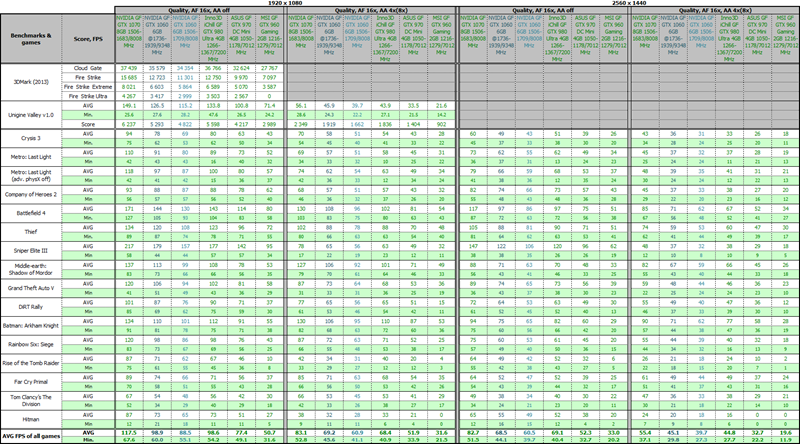
However, before turning to the pivot charts, we will give the results as a bonus. nVIDIA testing GeForce GTX 1060 and MSI GeForce GTX 960 Gaming in the CompuBenchCL benchmark.
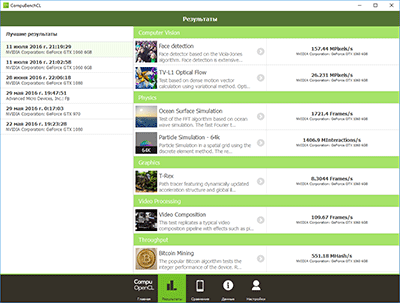

NVIDIA GeForce GTX 1060 6 GB (left) and MSI GeForce GTX 960 Gaming 2 GB (right)
As we see, here again the advantage of the novelty is rather close to twofold.
5. Summary diagrams
In the first pair of pivot charts, we estimate the difference between the new NVIDIA GeForce GTX 1060 and its predecessor in the form of MSI GeForce GTX 960 Gaming at their nominal frequencies. The results of the GeForce GTX 960 in each game are taken as the starting point of reference, and the average FPS GeForce GTX 1060 is postponed as a percentage of them.
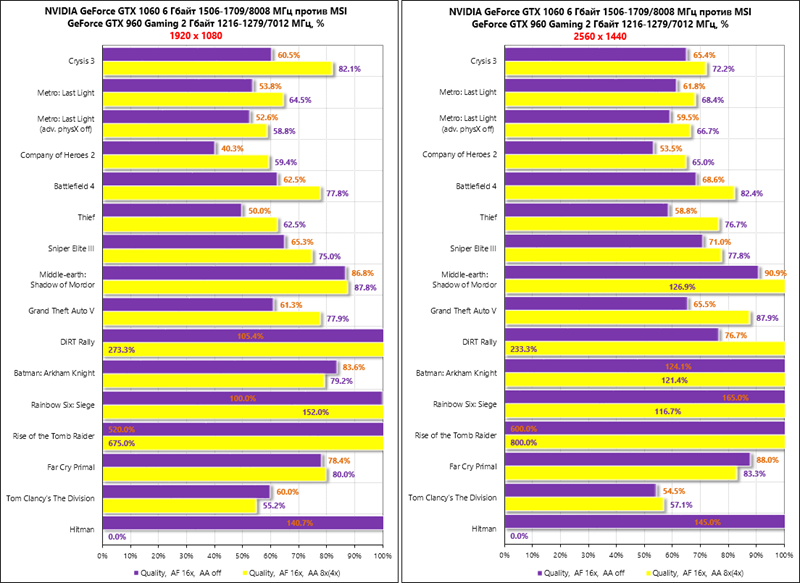
Everything is obvious here: in the worst case, the NVIDIA GeForce GTX 1060 is 40% faster than the GeForce GTX 960, and at its best, it reaches eight times. If we discard the least resource-intensive modes, as well as those testing modes where the GeForce GTX 960 does not have enough memory, then we can say that the performance of the GeForce GTX 1060 is higher than the performance of the GeForce GTX 960 by 80 (eighty) percent! If GeForce GTX 1060 (from $ 249) came out at the recommended cost of the GeForce GTX 960 announced once ($ 199), then the joy of all gamers with average incomes would be no limit.
Next, we compare the performance of the NVIDIA GeForce GTX 1060 with the ASUS GeForce GTX 970 DC Mini.

And here is a pretty convincing victory.
Now let's set an even more serious contender against the GeForce GTX 1060 - the original Inno3D iChill GF GTX 980 Ultra.

This time NVIDIA GeForce GTX 1060 failed to beat the rival, but its lag behind NVIDIA's flagship video card was only 10-12% at 1920 x 1080 pixels and 11-13% at 2560 x 1440 pixels. As we have seen in the course of analyzing the results, this difference easily overlaps the overclocking of the GeForce GTX 1060.
For sure, the future owners of NVIDIA GeForce GTX 1060 will be interested in how much their video card is slower than the NVIDIA GeForce GTX 1070. The answer is the next pair of summary diagrams.

On average for all gaming geForce tests The GTX 1060 is inferior to the GeForce GTX 1070 by 25-28% of performance, which, although a bit, overclocks the GeForce GTX 1060 in no way. But how much exactly does the first video card on the NVIDIA GP106 add when overclocking, we will learn from the next and last pair of summary diagrams for today.
Recall that the graphics processor of the first reference NVIDIA GeForce GTX 1060 Founders Edition we overclocked by + 15.3%, and the effective frequency of the video memory increased by + 16.7%. Here is the performance increase we managed to get.
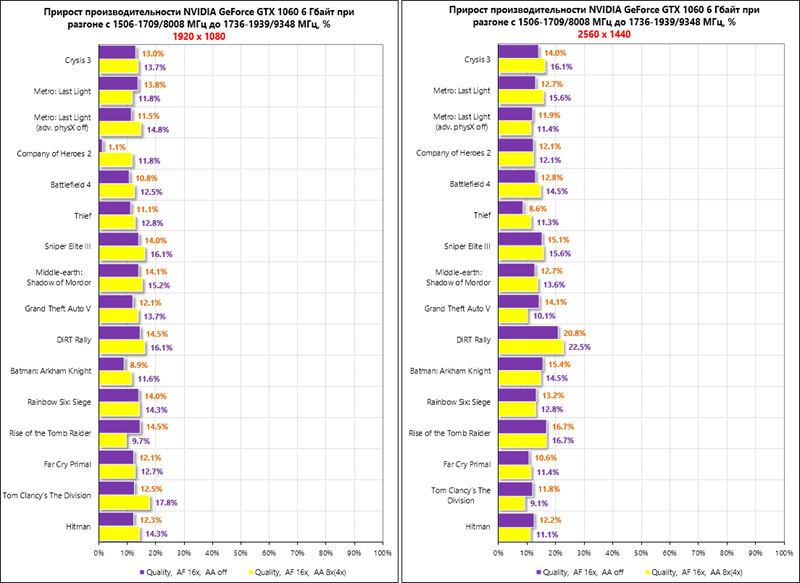
On average, for all gaming tests, the video card was able to accelerate by 11.9-13.7% in the resolution of 1920 x 1080 pixels and by 13.4-13.7% in the resolution of 2560 x 1440 pixels. Very good, in our opinion.
6. Power Consumption
Energy consumption was measured using the Corsair AX1500i power supply via the Corsair Link interface and the HWiNFO64 monitoring program version 5.32-2900 Beta. Measured power consumption of the entire system as a whole without a monitor. The measurement was carried out in 2D mode with normal work in Microsoft Word or Internet Surfing, as well as in 3D mode. In the latter case, the load was created using four consecutive cycles of the Swamp introductory scene from the Crysis 3 game at a resolution of 2560 x 1440 pixels with maximum graphics quality settings using MSAA 4X. We add that the diagram shows both the peak level of energy consumption in 3D mode and the average value of consumption over the entire testing cycle.
Let's compare the power consumption level of the systems with the video cards tested today according to the following diagram.
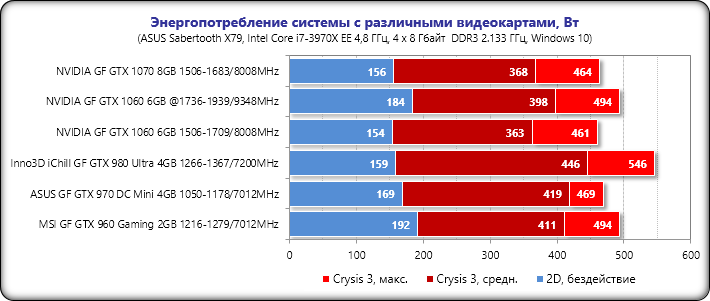
In the nominal mode of the video card, the NVIDIA GeForce GTX 1060 system turned out to be the most economical, consuming 461 watts at peak load, which is even less than the same configuration with the GeForce GTX 960. The average power consumption of the GeForce GTX 1060 is also ahead. At the same time, we cannot fail to note the minimal difference in the level of power consumption with the system with the GeForce GTX 1070, as if the 33% difference in the architecture of GP104 and GP106 graphics processors of these video cards is not at all. When the video card is overclocked, the power consumption of the system with it increases by 33 watts at peak load and by 35 watts at the average value, while still not exceeding the level of consumption of the system with GeForce GTX 960.
Conclusion
Inheriting all the best features of the NVIDIA GP104 Pascal architecture, the new 16-nm GP106 graphics processor and the first geForce video card GTX 1060 based on it have every reason to become a 3D bestseller in the middle class. Judge for yourself - the new model replaces the previous generation (GeForce GTX 960) with 80% of performance, which is higher than the GeForce GTX 1080 and GeForce GTX 1070 could achieve to their previous classmates. Moreover, thanks to the six gigabytes of video memory on board, in the most recent games and demanding modes, the advantage of the GeForce GTX 1060 is multiple. And all this NVIDIA managed to realize in the same thermal package as before - 120 watts. The only not quite pleasant change is the increase in the recommended cost (from $ 199 to $ 249), but, in our opinion, with current market trends, this has to be tolerated, as is the case with older models. Among the strengths of the GeForce GTX 1060 and excellent overclocking potential, which is already used by market leaders, releasing the original models with factory overclocking, as well as full support for DirectX 12.
Well, we will tell you about the battle with the new AMD Radeon RX 480 very soon.
Thanks to NVIDIA
and personally Irina Shekhovtsova
for the video card provided for testing.
ASUS DUAL-GTX1060-O3G Testing Technique Test Results One page
The GeForce GTX 1060 graphics card has received two incarnations. In detail about the older version of 6 GB, we told in a separate article. The younger version with 3 GB differs not only in the trimmed video memory, but also in a smaller number of computing units. Previously, both video cards featured in tests for individual games. Now we decided to bring them together in big comparisonto find out how GeForce GTX 1060 3GB differs from GeForce GTX 1060 6GB. The younger version is approximately in the same price category as the Radeon RX 470, but in this article we focused on comparison with older video cards. Therefore, from the side of AMD, Radeon RX 480 8GB will take part in testing.
Consider the general features of the GeForce GTX 1060 3GB and the capabilities of a specific model of this series in the face of ASUS DUAL-GTX1060-O3G. Let us estimate the temperature and noise characteristics, check the overclocking potential.
At the heart of all variations of the GeForce GTX 1060 is the GP106 GPU of the Pascal architecture, which is made according to the 16-nm process technology. This chip has 1280 CUDA cores, 80 TMU texture units and 48 ROP units. Compared with the previous generation, the intermediate configuration of the computing blocks between the GeForce GTX 970 and GeForce GTX 960 is obtained. But thanks to a serious increase in frequencies and a new architecture, the GeForce GTX 1060 6GB turns out to be faster than the GeForce GTX 970.
The GeForce GTX 1060 3GB video card should be closer in its capabilities to the GeForce GTX 970. The younger version was left with 1152 active CUDA cores with 72 texture units. Frequencies remained unchanged. The biggest simplification is reducing memory to 3 GB. And this is also a card closer to the GeForce GTX 970. Due to the nature of the memory subsystem, the GeForce GTX 970 has an effective capacity of 3.5 GB, and the last memory segment operates at a lower bandwidth and is not always effectively used by applications.
Compare the technical characteristics of the two versions of the GeForce GTX 1060 with the GeForce GTX 970 can be on the lower table.
|
GeForce GTX 1060 6GB |
GeForce GTX 1060 3GB |
||
|
Architecture |
|||
|
Code Name GPU |
|||
|
The number of transistors, mln. |
|||
|
Process technology, nm |
|||
|
Core area, square mm |
|||
|
The number of texture units |
|||
|
Number of ROP blocks |
|||
|
Core frequency, MHz |
|||
|
Memory bus, bit |
|||
|
Memory type |
|||
|
Memory capacity, MB |
|||
|
Interface |
|||
|
TDP level, W |
It's no secret that many modern games, even for Full HD, require up to 4 GB of video memory. Therefore, the question of the real difference between the GeForce GTX 1060 3GB and GeForce GTX 1060 6GB is very serious. We tried to answer it in this test by comparing different versions of the GeForce GTX 1060 with each other and with the Radeon RX 480 in 16 test applications at a resolution of 1920x1080. But first, let's look at the representative of the GeForce GTX 1060 3GB series.
ASUSDUAL-GTX1060-O3G
The ASUS video card comes in a small box. Not supplied with any additional adapters. But the buyer will receive a code with bonuses for the game World of Warships for 15 days of the premium mode.
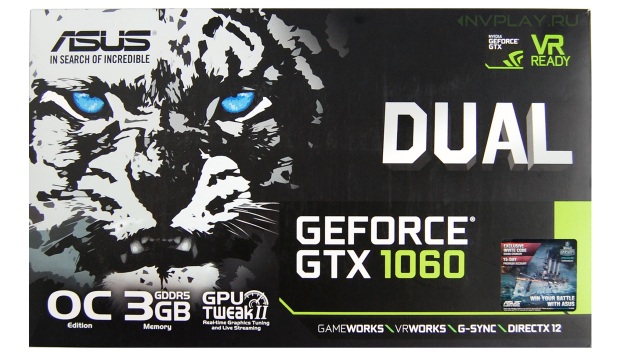
The line of graphics cards ASUS DUAL stands out with a special style using white. Typically, the design of video art is dominated by dark colors, so the snow-white case of this model looks unusual. It will look organic with motherboards ASUS X99-A II or in combination with other boards that use white radiators or light PCB.
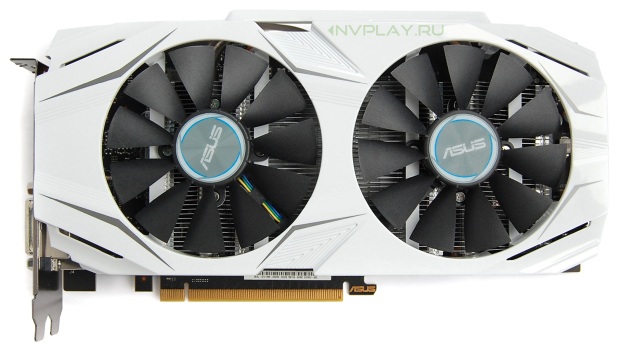
ASUS DUAL offers and good system cooling A large cooler covers the entire board, using two fans. Extra power connects to one 8-pin connector in the corner of the board.

The board itself is the usual black color. This is not a shortened version, as is the case with the cheap versions of GeForce GTX 1060. It can be seen that they did not save on production.
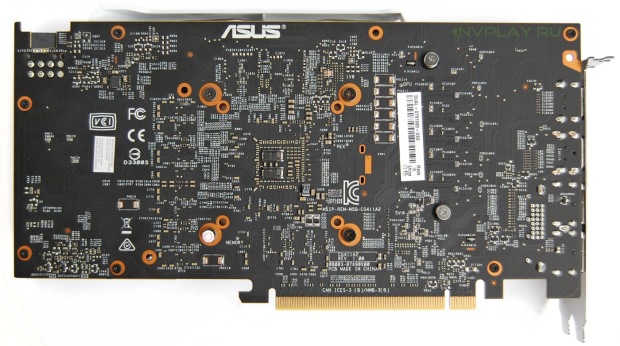
To display the image has five connectors: two HDMI, two DisplayPort and one DVI.
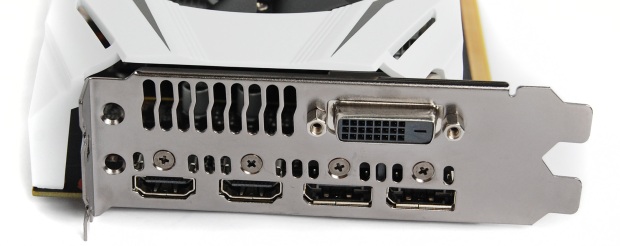
After dismantling the cooler, it becomes clear that the radiator is not as big as it seems in the assembled state. But the design uses two thick heat pipes with direct contact - their surface is in direct contact with the surface of the graphics chip.

The radiator is assembled from a series of small thin plates fixed in a massive base. Heat pipes run through the edges of the plate. A plastic case is screwed on top with a pair of 90-mm fans.
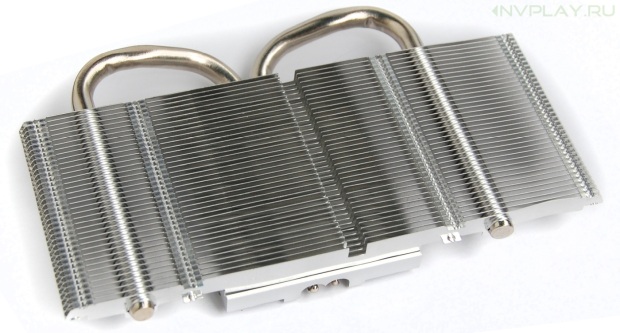
For the elements of the supply chain has its own radiator. Considering the dimensions of the fans, we can talk about a great blow on both this additional radiator and all electronic components on the board.

The graphics chip power subsystem consists of four phases. Apply high-quality components that can be seen and no more expensive ASUS video cards.
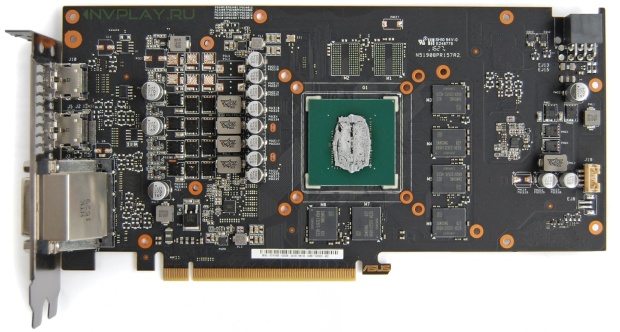
Full marking chip GP106-300-A1. Three gigabytes of memory is typed in six GDDR5 Samsung K4G41325FE-HC25 chips.

Standard specifications provide for a base frequency of a graphics chip of 1506 MHz with an average Boost Clock of 1708 MHz. ASUS operates at frequencies of 1569/1785 MHz. The effective memory frequency corresponds to the standard value of 8 GHz.
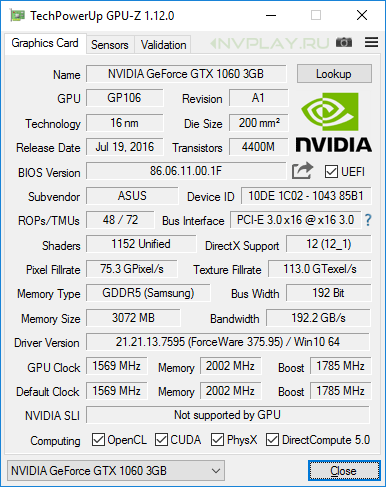
The factory overclocking is small, but there is also a software profile with higher core frequencies of 1594/1809 MHz. To select work profiles, use proprietary utility ASUS GPU Tweak II, which also allows monitoring parameters and manual overclocking.
We tested ASUS with standard factory settings. In game mode, at an indoor temperature of 23 ° C, the core was heated to 73 ° C. The fans spun up to the level of 1500 rpm and a little higher, creating an extremely low noise. The peak Boost value could reach 1974 MHz, but the average frequency was at the level of 1934 MHz, which is illustrated below with the monitoring screenshot in the MSI Afterburner program during the repeated passage of the Gears of War 4 market book.
Traditionally, for tests at standard frequencies, we are setting the GeForce GTX 1060 to Boost frequencies at the level of 1860 MHz. The same thing was done this time, the base value was adjusted so that the Boost frequencies were contained within 1848-1873 MHz. In order to avoid discrepancies on the performance graphs, the maximum Boost value for both versions of the GeForce GTX 1060 is indicated as 1860 MHz.
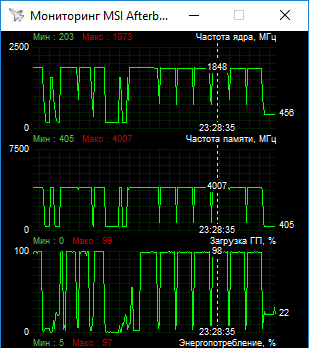
ASUS overclocking potential turned out to be at the level of older GeForce GTX 1060 6GB models. We managed to raise the base frequency of the core to 1700 MHz with the maximum boost up to 2101 MHz. Memory managed to overclock to 4743 (9486) MHz.

With an increase in the power limit to the maximum and a slight manual acceleration of the fans, it was possible to achieve that the core frequency was kept at 2088-2101 MHz, with occasional deviations from the smaller side.
At a fan speed of more than 2000 rpm, a clear hum is evident. And if in terms of acoustic comfort you are very demanding, you will have to reduce speed and, perhaps, slow down a little overclocking.
As a result, the reviewed video card was tested as a normal version with standard frequencies, at higher factory frequencies and in overclocking. The older version of GeForce GTX 1060 and Radeon RX 480 are positioned as more expensive and productive solutions. Therefore, they were tested only at standard frequencies.
Characteristics of test participants
|
GeForce GTX 1060 6GB |
ASUS DUAL GTX 1060 3GB |
GeForce GTX 1060 3GB |
||
|
Architecture |
||||
|
Code Name GPU |
||||
|
The number of transistors, mln. |
||||
|
Process technology, nm |
||||
|
Core area, square mm |
||||
|
Number of stream processors |
||||
|
The number of texture units |
||||
|
Number of ROP blocks |
||||
|
Core frequency, MHz |
||||
|
Memory bus, bit |
||||
|
Memory type |
||||
|
Effective memory frequency, MHz |
||||
|
Memory capacity, MB |
||||
|
Interface |
||||
|
TDP level, W |






